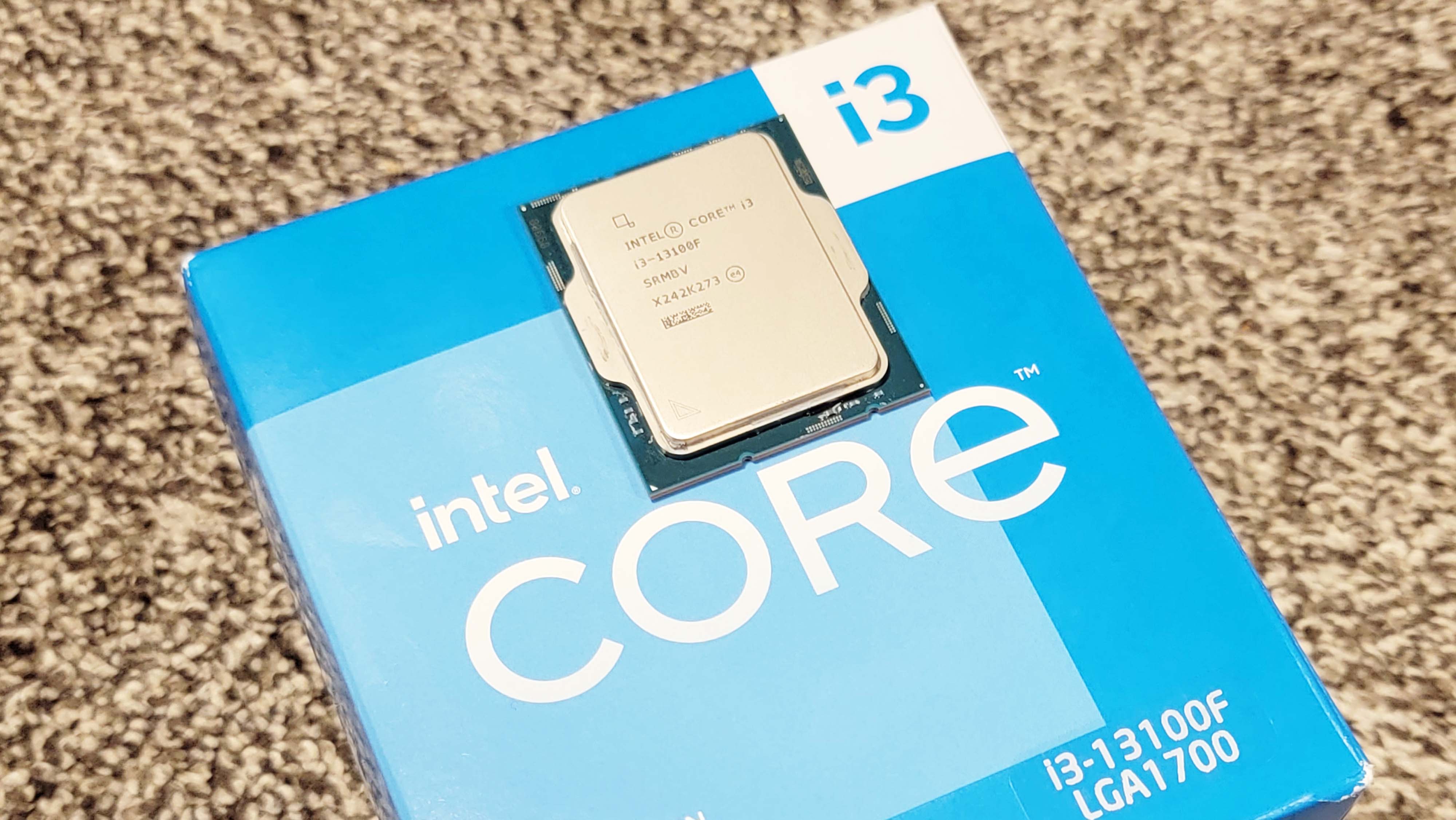
The Intel Core i3-13100F comes to market with big shoes to fill; its predecessor, the Core i3-12100F, built a reputation as the best budget CPU for gaming. Intel is obviously looking to repeat that success, but perhaps the Core i3-13100F follows in the footsteps of its predecessor too closely — the company repurposed the previous-gen design for the Core i3-13100, so it has the same four p-cores paired with an ever-so-slightly-improved 200 MHz higher boost clock of 4.5 GHz.
The 13100F addresses the sub-$150 budget segment, so pricing is critical. However, while Intel launched the previous-gen graphics-less Core i3-12100F at $104, it later quietly raised pricing. So naturally, that leads to higher prices for the new Core i3 models, too. As such, Intel's recommended pricing has jumped to $144 for the full-fledged Core i3-13100 model and $119 for the graphics-less 13100F model. That's a 12% and 15% gen-on-gen price increase, respectively.
Meanwhile, AMD might have moved forward to its new AM5 platform for its high-end Zen 4 Ryzen 7000 chips, but it also refreshed its Zen 3 Ryzen 5000 lineup to address the lower end of the market with its AM4 motherboards. The new Zen 3 processors initially arrived with slightly higher price tags than expected, but they now represent an exceptional value at their current pricing.
That leaves Intel's quad-core chip battling two six-core processors: The $144 Core i3-13100 faces stiff competition from the $140 Ryzen 5 5600, while the $119 Core i3-13100F squares off with the $99 Ryzen 5 5500. Both AMD chips drop into the inexpensive and plentiful AM4 chipset ecosystem, giving builders plenty of affordable options for budget builds, thus creating a fierce contest for a spot on the list of best CPUs for gaming. Let's see how the Core i3-13100F stands up to the pressure.
Intel Core i3-13100F Pricing and Specifications
Retail pricing for AMD and Intel's chips now diverges widely from suggested pricing, so here we've listed the latest street prices. Intel has used re-badged silicon for its lower-end chips in the past, and continues that practice with its new lineup. So while the new Core i3 models slot into the 13th-Gen Raptor Lake family, Intel re-uses the previous-gen 12th-Gen Alder Lake 'Intel 7' silicon and Golden Cove core architecture. Intel also takes this approach with some of the Core i5 models, like the Core i5-13400.
As such, outside of some microcode tuning, the 13100 is identical to the 12100. That is evident from the L2 cache capacity, which weighs in at 1.25 MB per core for the 13100. In contrast, the truly new Raptor Cove cores come with 2MB per core.
Like its predecessor, the Core i3-13100/F comes with four performance cores and eight threads, but no e-cores for background tasks. Intel sprinkled on 200 MHz of extra boost frequency (+5%), bringing it to 4.5 GHz, and 100 MHz higher base clock (+3%), bringing it to 4.3 GHz. The clock speed adjustments are all that Intel has to justify the step up to 13th-Gen branding and the much higher price tag.
As before, the 13100 has a 60W / 89W processor base/max turbo power, 16 PCIe 5.0 lanes and four PCIe 4.0 lanes, and support up to DDR4-3200 and DDR5-4800 MT/s (caveats apply to DDR5 support). Intel's non-K models don't allow overclocking the CPU cores, but they do support memory overclocking. Unfortunately, the company's nonsensical decision to keep certain voltages locked restricts DDR4's overclocking headroom, so gains are limited.
The standard Core i3-13100 comes with the UHD Graphics 730 engine and 24 EUs that run at 300/1500 MHz base/boost frequencies. You can save some cash by going without graphics with the F-series model, but that means you will lose Quick Sync capabilities and the iGPU fallback that you can use for troubleshooting. Otherwise, the chips provide the same performance.
The 13100 models drop into either 600- or 700-series motherboards and come with a bundled Laminar RM1 cooler that is sufficient for cooling the chip under normal conditions, albeit at the expense of a higher noise level than you'd get with a better cooler.
The six-core 12-thread Ryzen 5 5600 is a 7nm Vermeer model that debuted at $199, but its new $140 price point makes a lot more sense. This chip is the ‘non-X’ version of the Ryzen 5 5600X, so the two chips are nearly identical besides the 5600's reduced 3.5 / 4.4 GHz base/boost clock. Overall, the 5600 has the same feature set we see with other chiplet-based Zen 3 chips.
AMD's lowest-end Zen 3 chip, the Ryzen 5 5500, debuted at $150 but now retails for a mere $99. For this chip, AMD repurposed its monolithic (single-chip) Cezanne silicon that it typically uses for APUs, but disabled the chip’s integrated Radeon Vega graphics engine. That leaves us with a six-core 12-thread chip that looks and largely acts like a standard Vermeer processor.
The 5500 has the same design as the Ryzen 5 5600G, including support for PCIe 3.0 instead of PCIe 4.0. As a result, this chip will make a great pairing for older, lower-end AM4 motherboards (you definitely don’t want to pay for functionality you don’t need by pairing it with a PCIe 4.0-supporting motherboard). The 5500 wields a 3.6 / 4.2 GHz base/boost clock.
In contrast to the locked Core i3 lineup, the Ryzen chips are fully unlocked for overclocking the CPU cores, memory, and fabric, and like their more full-fledged counterparts, both chips come with a bundled Wraith Stealth cooler that is sufficient for stock operation. They also support up to DDR4-3200 memory. Neither chip has a functional iGPU, so you'll need to plan for a discrete GPU.
- MORE: AMD Ryzen 7 7800X3D vs Intel Core i9-13900K vs Core i7-13700K
- MORE: Best CPU for gaming
- MORE: CPU Benchmark Hierarchy
- MORE: Intel vs AMD
- MORE: How to Overclock a CPU
Intel Core i3-13100F Power Consumption and Efficiency
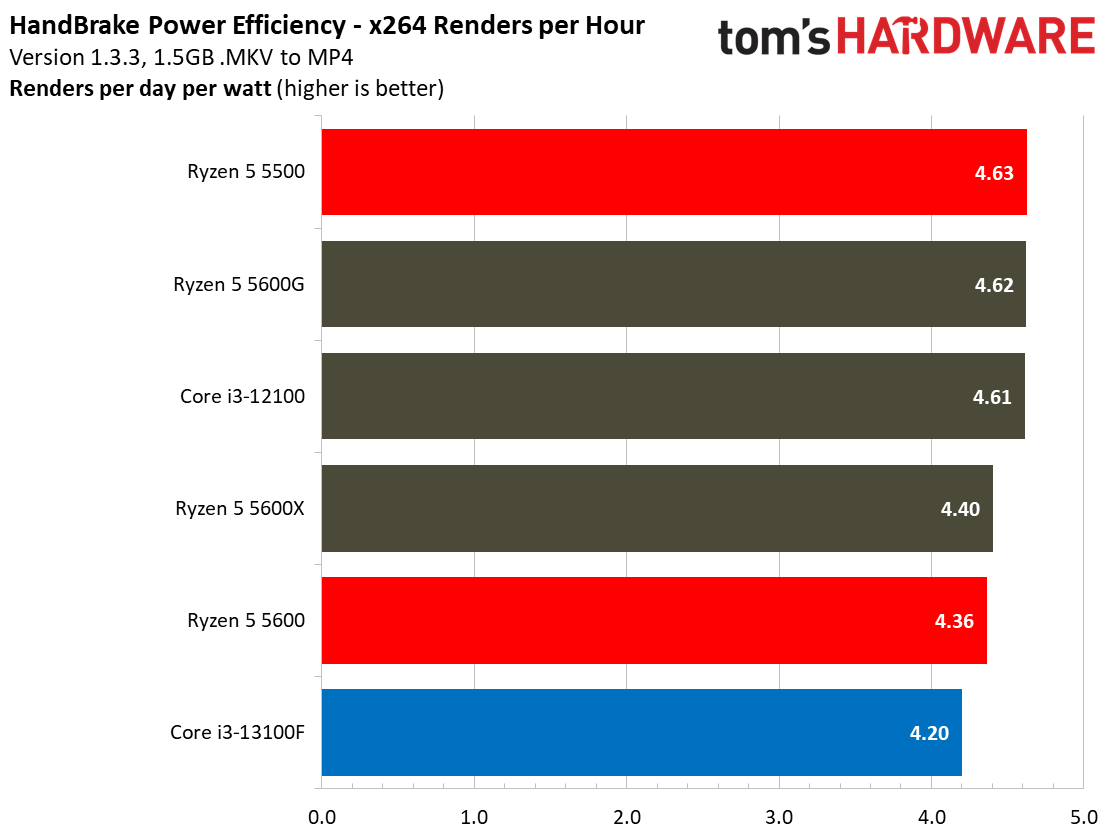
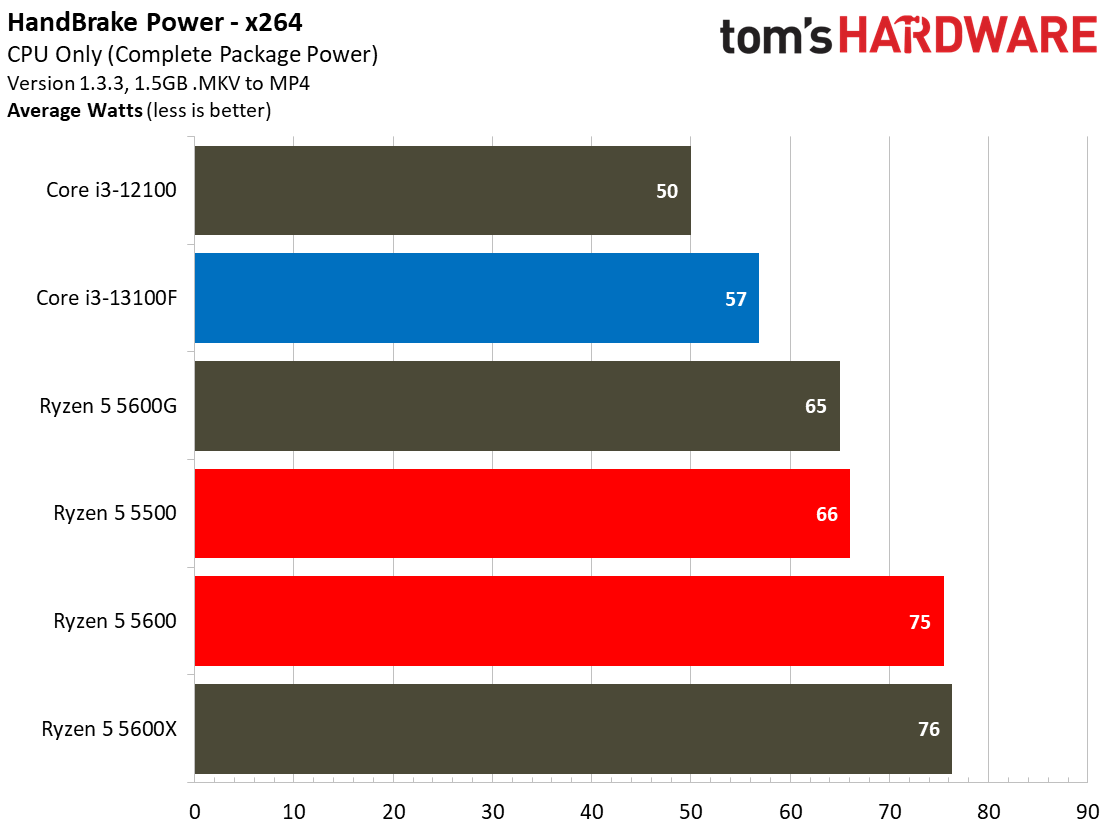
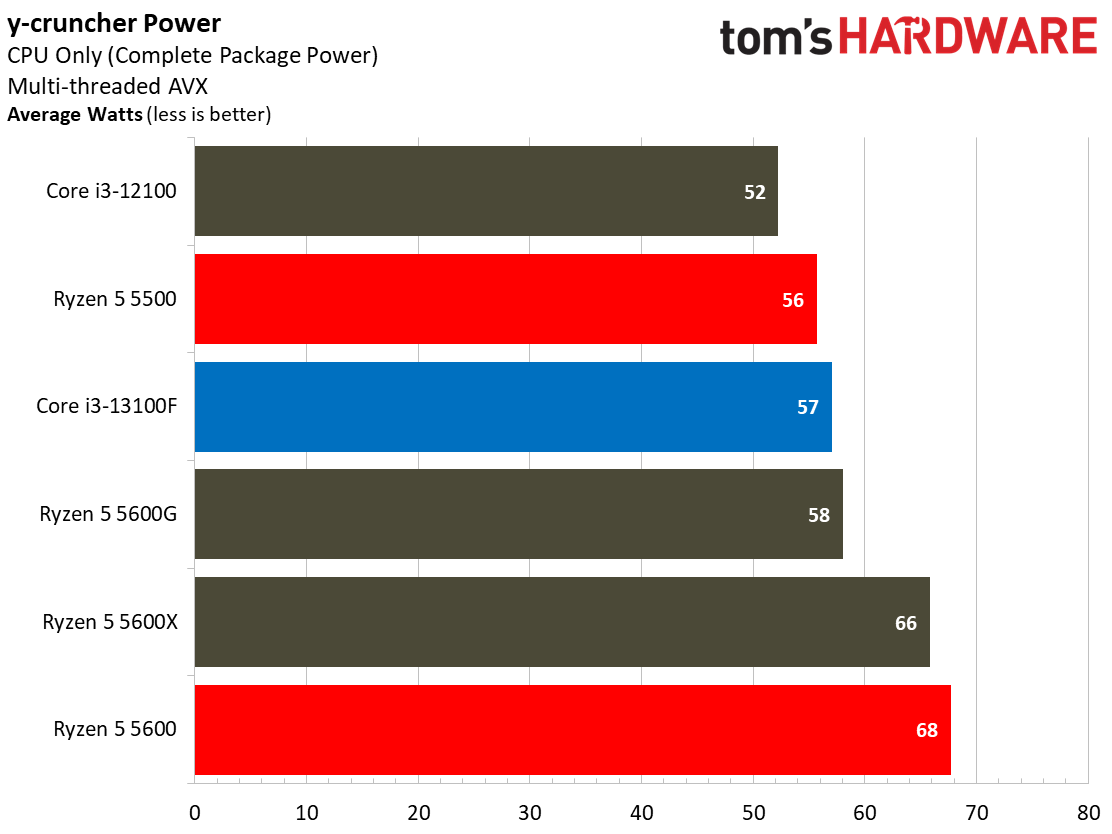
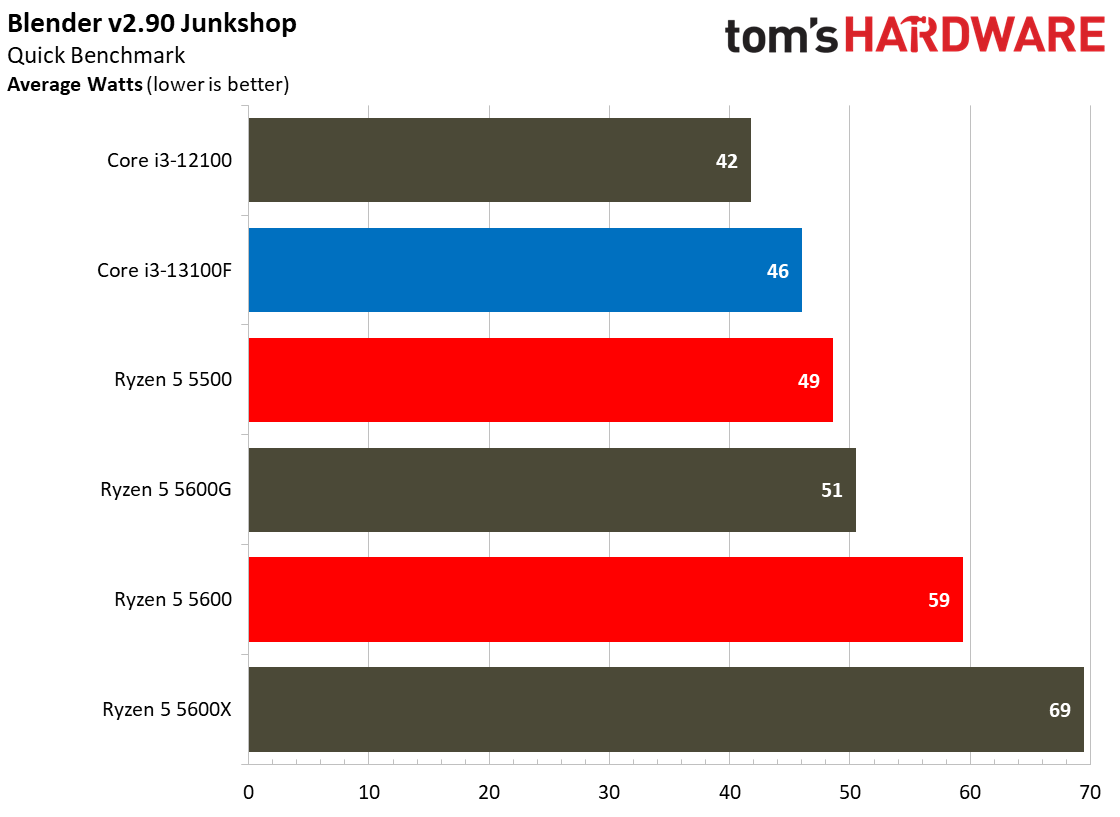
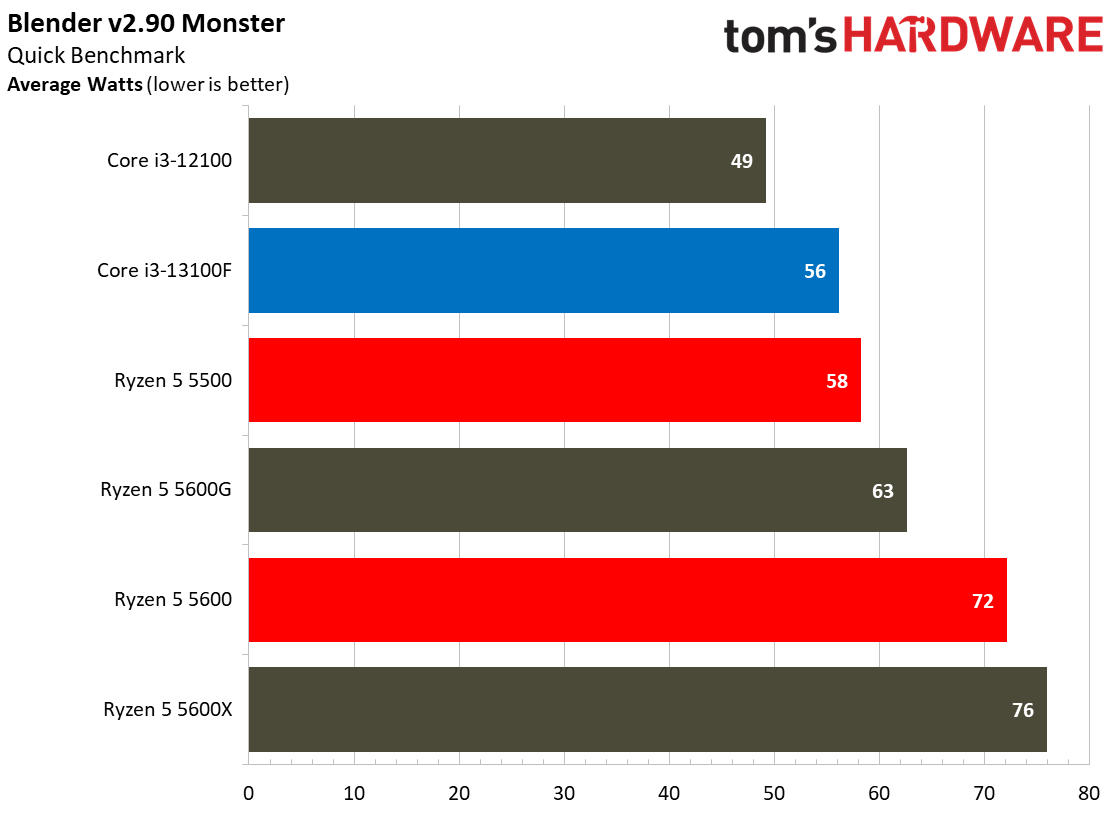
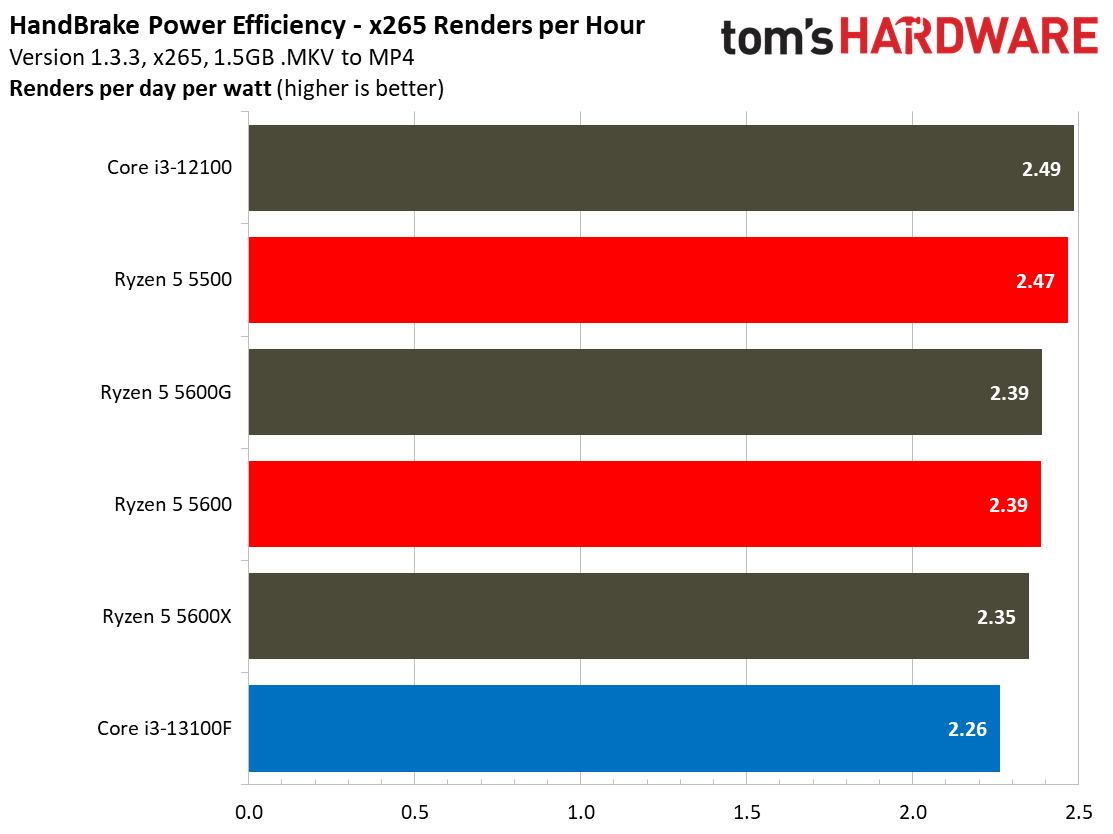
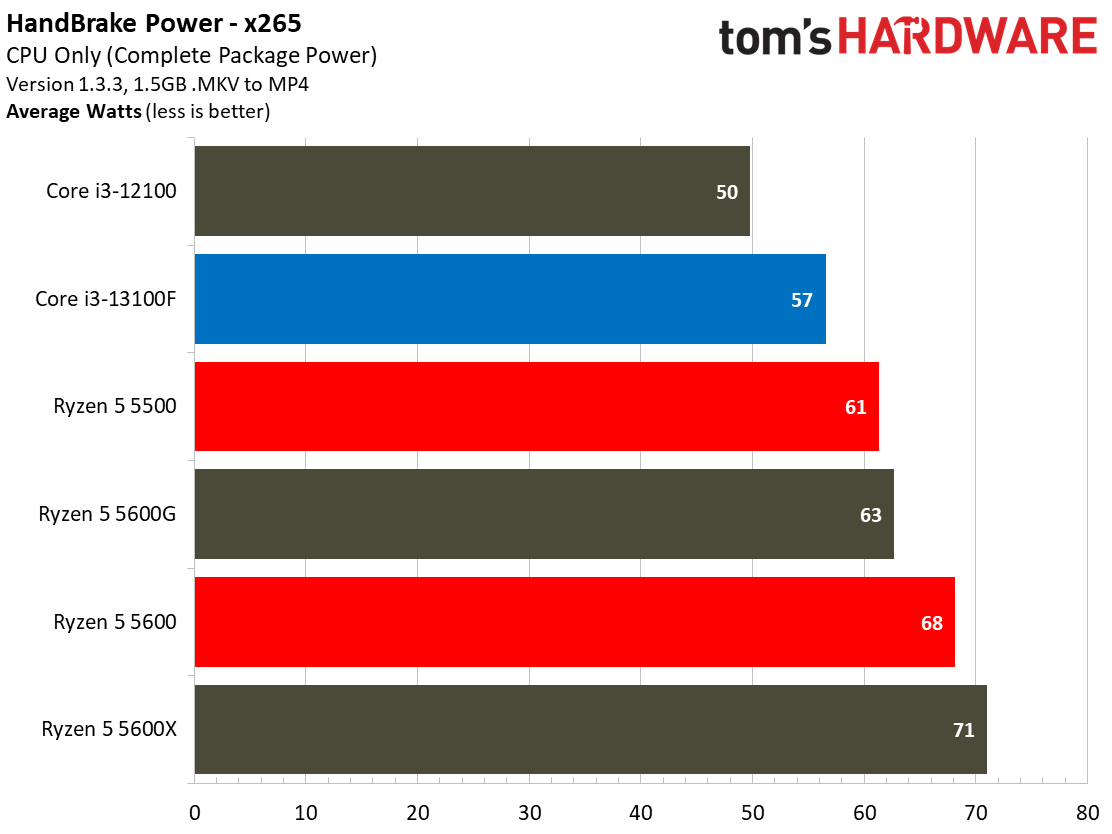
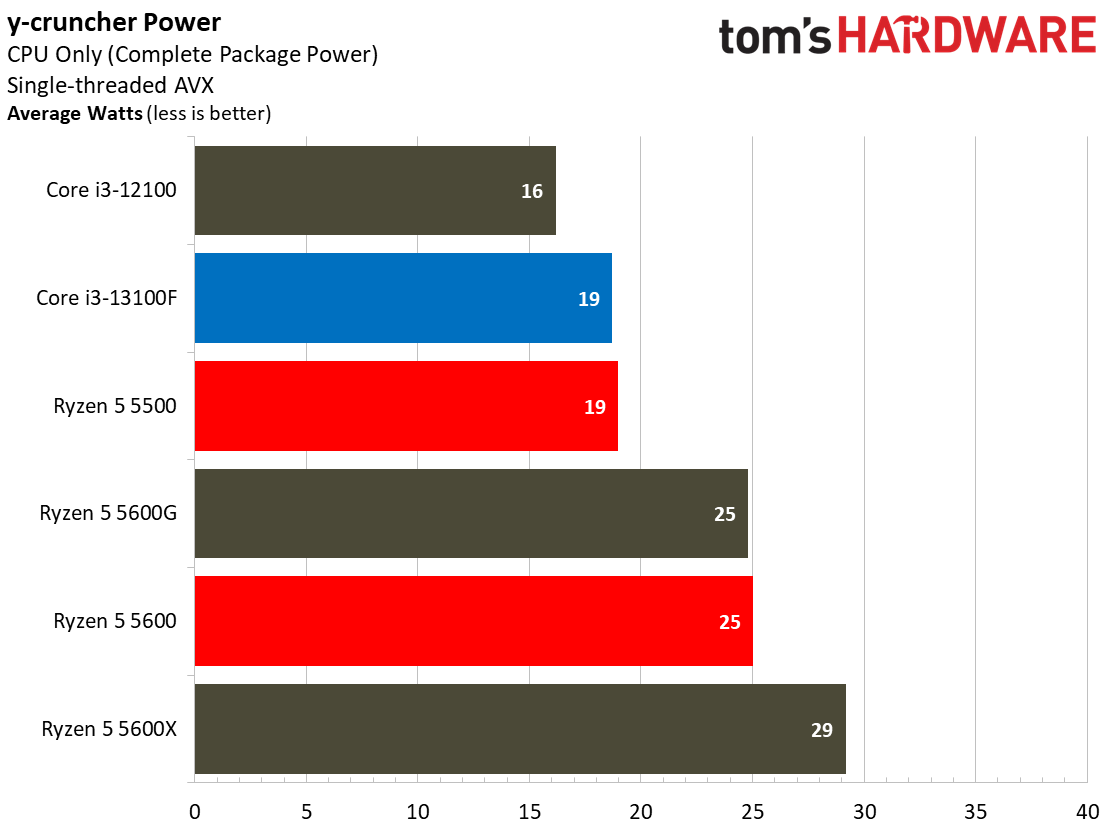
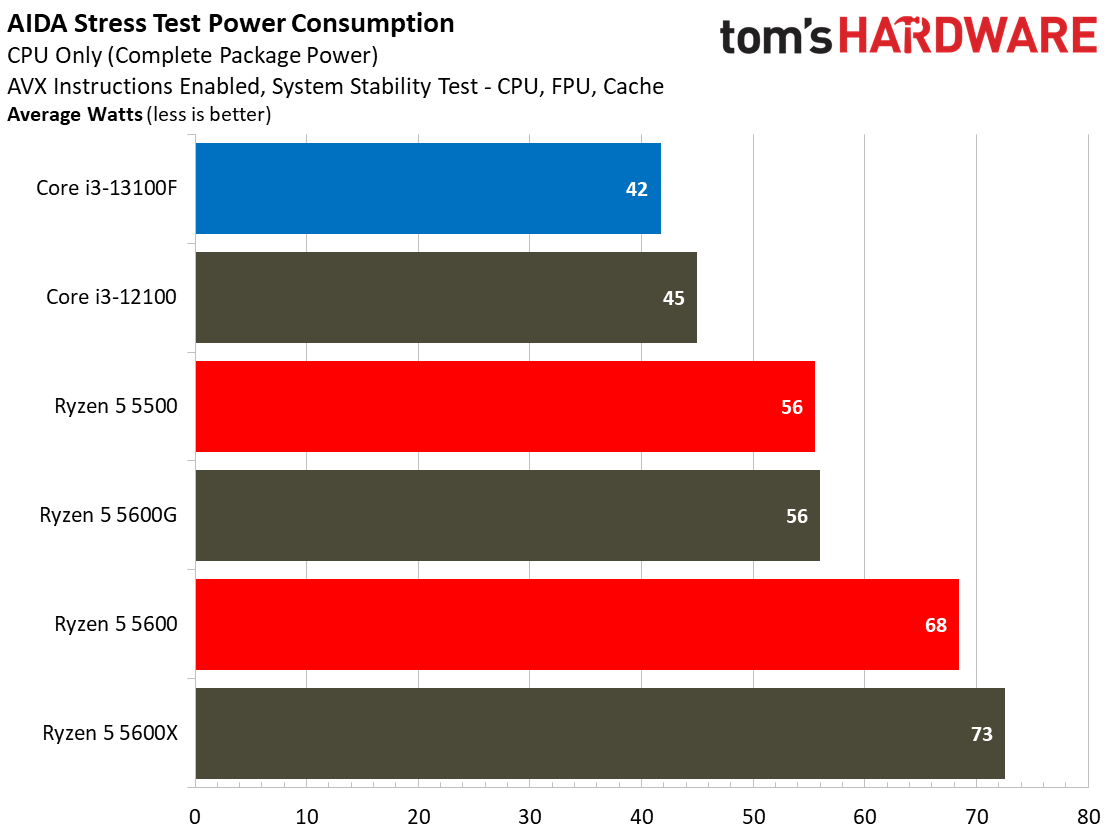
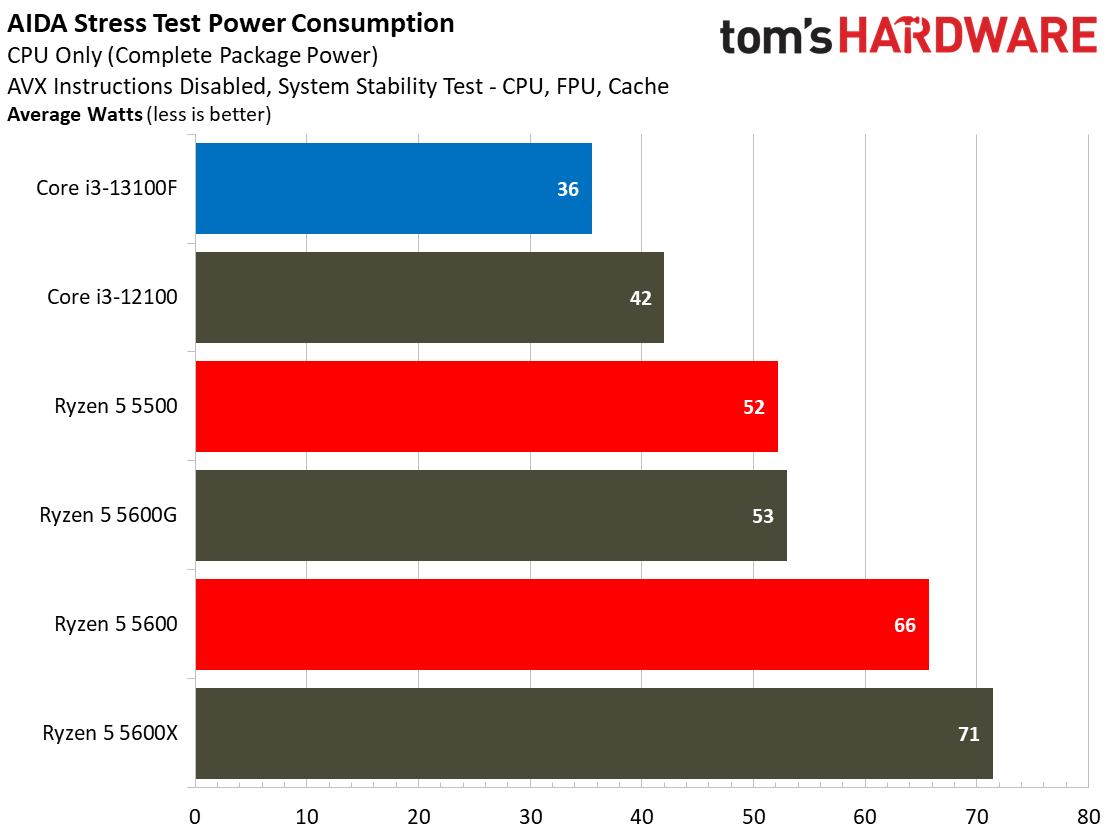
In several of these tests, the Ryzen 5 5600 and 5500 processors draw more power than the Core i3-13100F. However, the AMD chips have two more cores than the 13100 and still use the 7nm TSMC process, which isn't as efficient as the newer 5nm that AMD uses for Ryzen 7000 models. The Ryzen processors are faster in multi-threaded workloads, thus justifying the extra power consumption. This is reflected in the first chart, which outlines power efficiency as a renders-per-watt metric. Here the Ryzen processors both offer better efficiency metrics than the Core i3-13100F.
Our highest average power measurement for the Core i3-13100F was 57W, which is relatively easy to tame with lower-end coolers. Aside from a few outliers, the 13100F regularly consumed more power than its predecessor, the Core i3-12100. That's expected given the higher clock rates, but it results in less power efficiency. The Core i3-12100 beats the newer 13100F in the renders-per-day efficiency metrics, indicating that Intel's tuning for a higher clock rate has pushed the silicon further out of the sweet spot on the voltage/frequency curve.
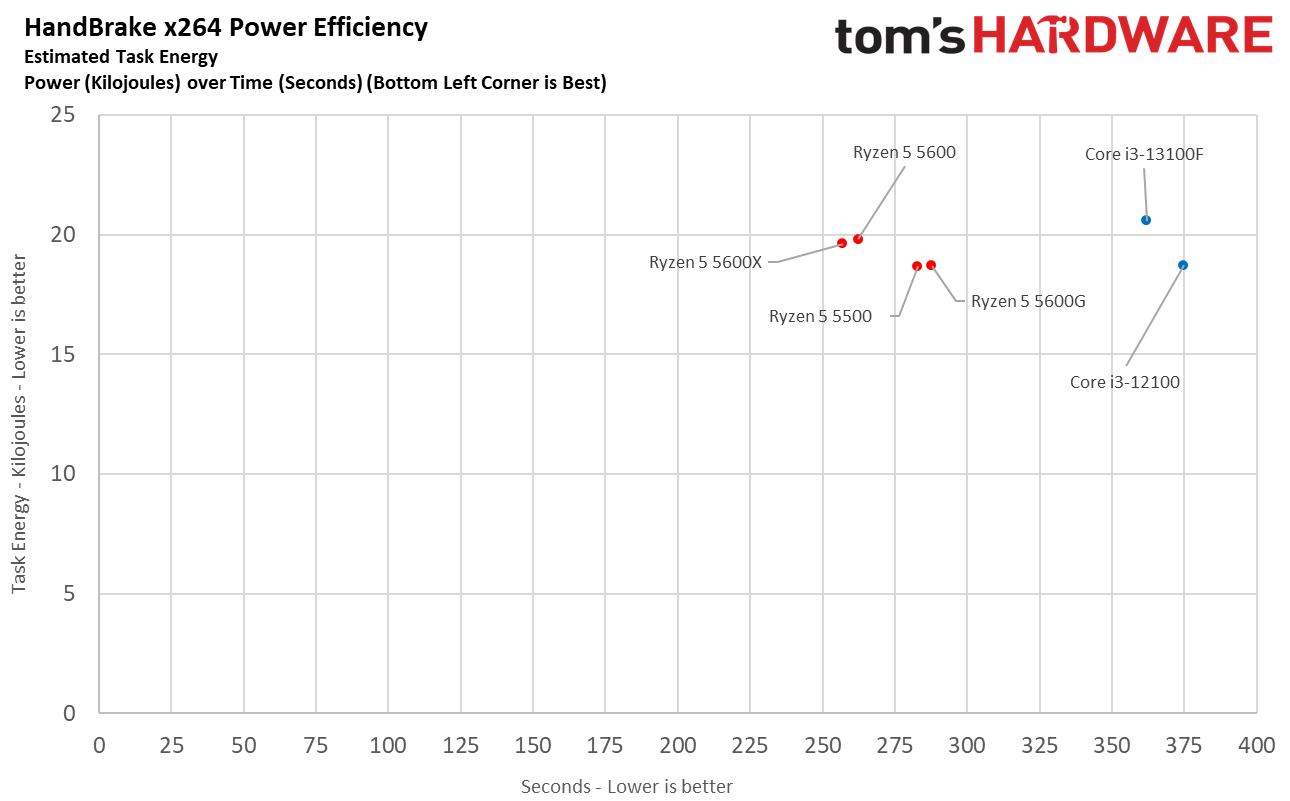
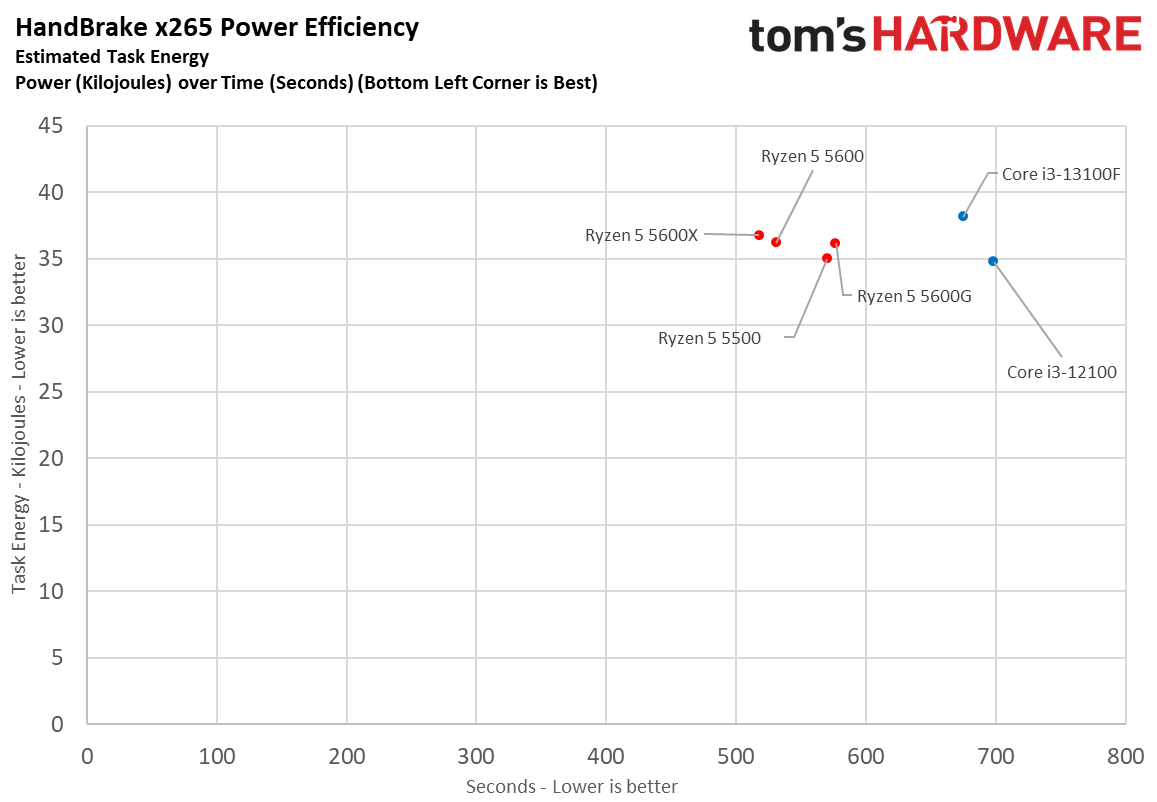
Here we take a slightly different look at power consumption by calculating the cumulative energy required to perform x264 and x265 HandBrake workloads, respectively. We plot this 'task energy' value in Kilojoules on the left side of the chart.
These workloads are comprised of a fixed amount of work, so we can plot the task energy against the time required to finish the job (bottom axis), thus generating a really useful power chart. Bear in mind that faster compute times, and lower task energy requirements, are ideal. That means processors that fall the closest to the bottom left corner of the chart are the best.
This chart brings the Core i3-13100's relatively slower performance into view — the Ryzen processors are faster while consuming less cumulative power, thus explaining their leading power efficiency. We can also see that the Core i3-13100 consumes more power than the 12100 here, but for a minimal performance improvement.
Intel Core i3-13100F Test Setup
- Intel Core i3-13100F: Corsair H115i 280mm water cooler, default power limits, DDR4-3200 (Gear 1)
- Intel Core i3-13100F DDR4-3600: Corsair H115i 280mm water cooler, default power limits, DDR4-3600 (Gear 1)
- Ryzen 5 5600: Corsair H115i 280mm water cooler, PBO Disabled, DDR4-3200
- Ryzen 5 5600 PBO: Corsair H115i 280mm water cooler, PBO Enabled, Scalar 10X, DDR4-3800, FCLK 1900 MHz (1:1 Ratio)
- Ryzen 5 5500: Corsair H115i 280mm water cooler, PBO Disabled, DDR4-3200
- Ryzen 5 5500 PBO: Corsair H115i 280mm water cooler, PBO Enabled, Scalar 10X, DDR4-4000, FCLK 2000 MHz (1:1 Ratio)
We tested with Windows 11 and DDR4 memory on a Z790 motherboard to maintain an even playing field with the rest of our test pool. Of course, you wouldn't pair this chip with this class of motherboard, but the 700- and 600-series B- and H-series motherboards also support overclocking memory and removing power limits. Given the 13100's tame power consumption, even lower-end motherboards will provide the chip with enough power to assure full operation.
Notably, we were able to overclock the Core i3-12100's memory to DDR4-3800 in our initial review but found that to be unstable for both the 13100 and 12100 during our retesting, which could be due to newer motherboard firmware. In either case, we dialed back to DDR4-3600. Regardless of the board you use, these locked chips have a relatively low memory overclocking limit due to Intel's decision to keep the SA voltage locked for Alder and Raptor Lake chips, which we'll hopefully see rectified in the next-gen refresh models. Your memory overclocking mileage will vary, but probably not by much.
We test Intel processors with the power limits fully removed for our standard measurements, so those chips run beyond the 'recommended' power settings but remain within warranty. We used DDR4 memory for testing, as DDR5's pricing premium isn't as suitable for this class of chip.
Microsoft has advised gamers to disable several security features to boost gaming performance. As such, we disabled secure boot, virtualization support, and fTPM/PTT on all systems for maximum performance. You can find further hardware details in the table below.
- MORE: AMD Ryzen 7 7800X3D vs Intel Core i9-13900K vs Core i7-13700K
- MORE: Best CPU for gaming
- MORE: CPU Benchmark Hierarchy
- MORE: Intel vs AMD
- MORE: How to Overclock a CPU
Intel Core i3-13100F Gaming Benchmarks — The TLDR
Here we have the geometric mean of our gaming tests at 1080p and 1440p, with each resolution split into its own chart. We're testing with an Nvidia GeForce RTX 4090 to reduce GPU-imposed bottlenecks as much as possible, and differences between test subjects will shrink with lesser cards, which is especially pertinent in this price range, or higher resolutions and fidelity. You'll find further game-by-game breakdowns below.
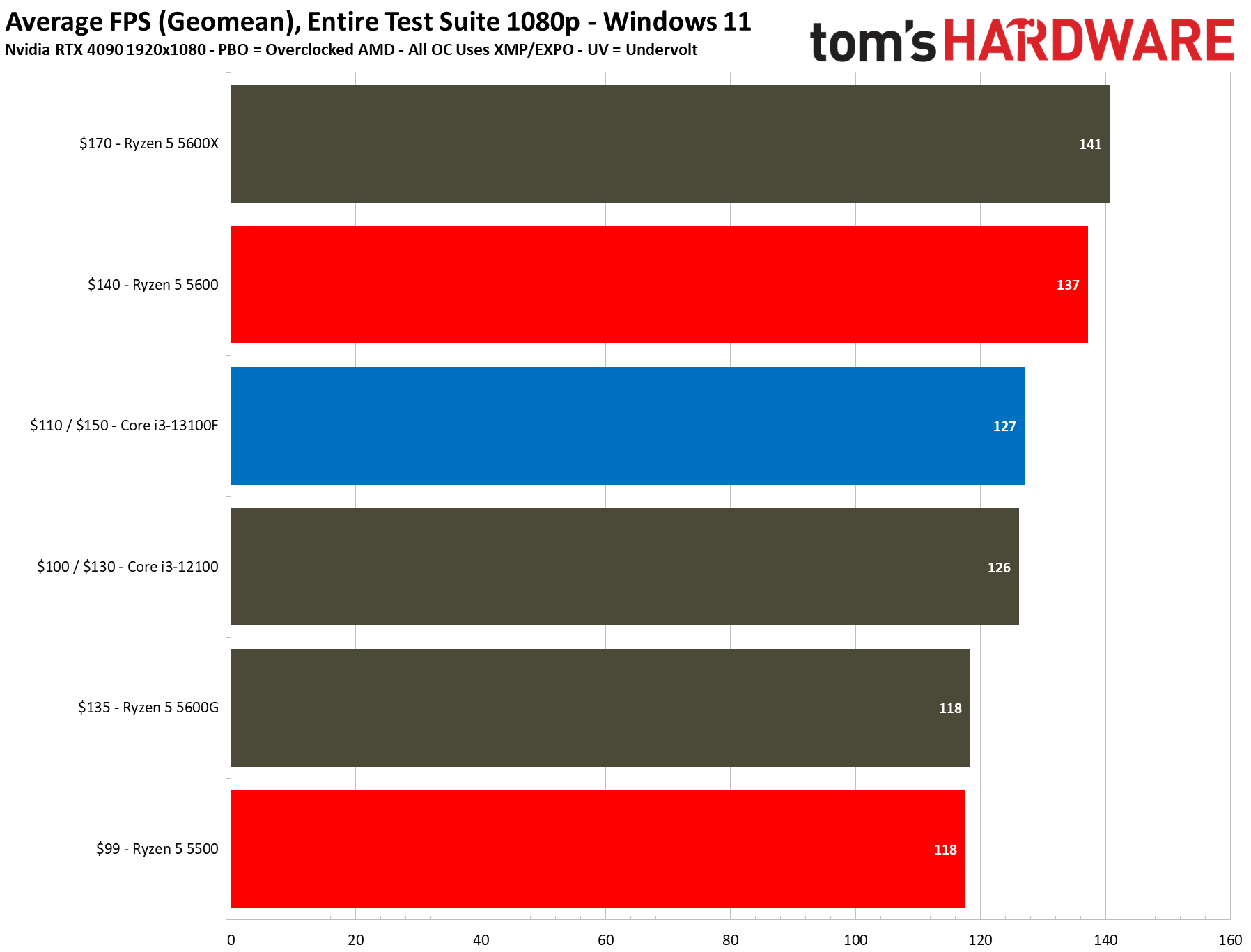
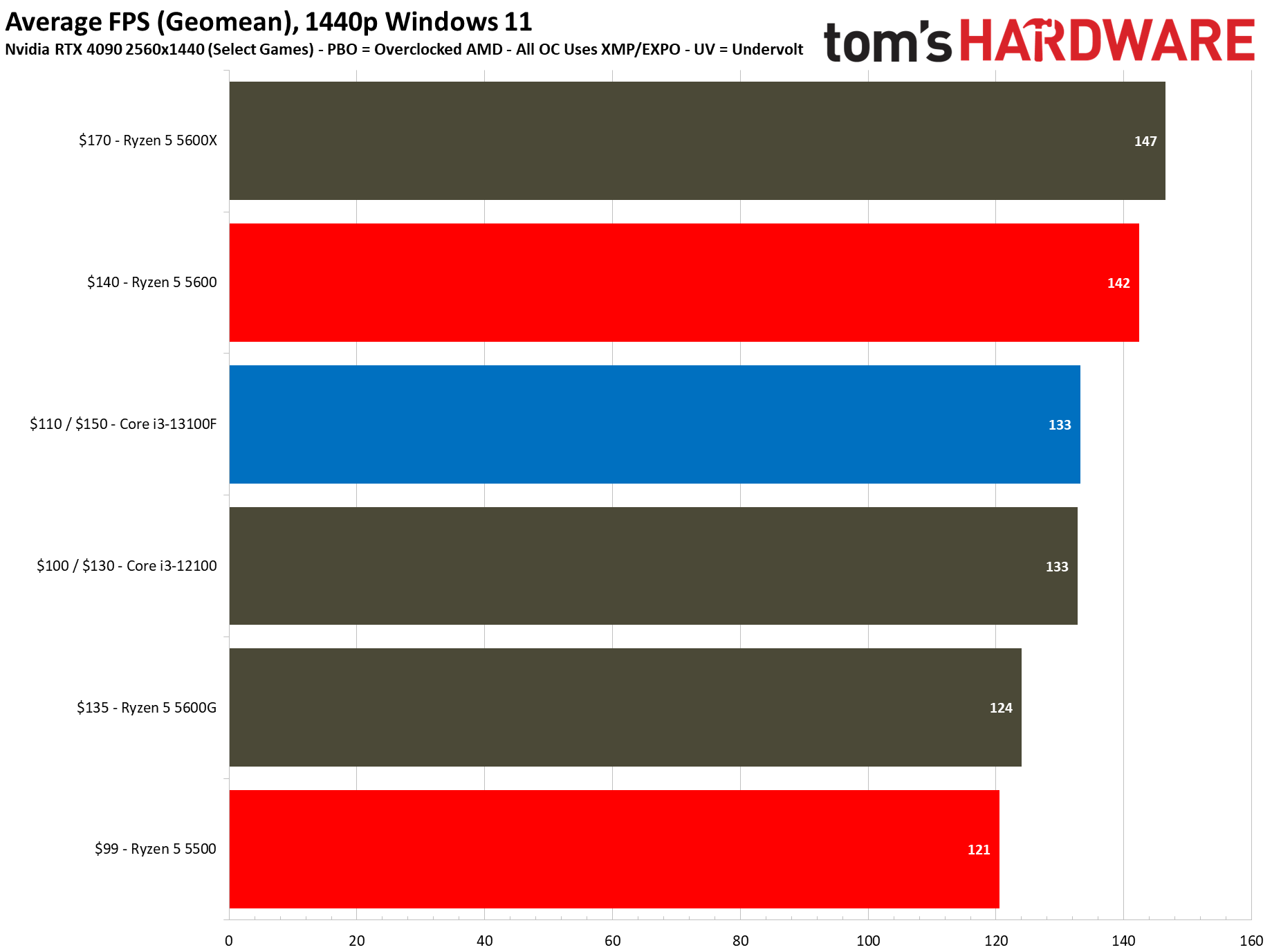
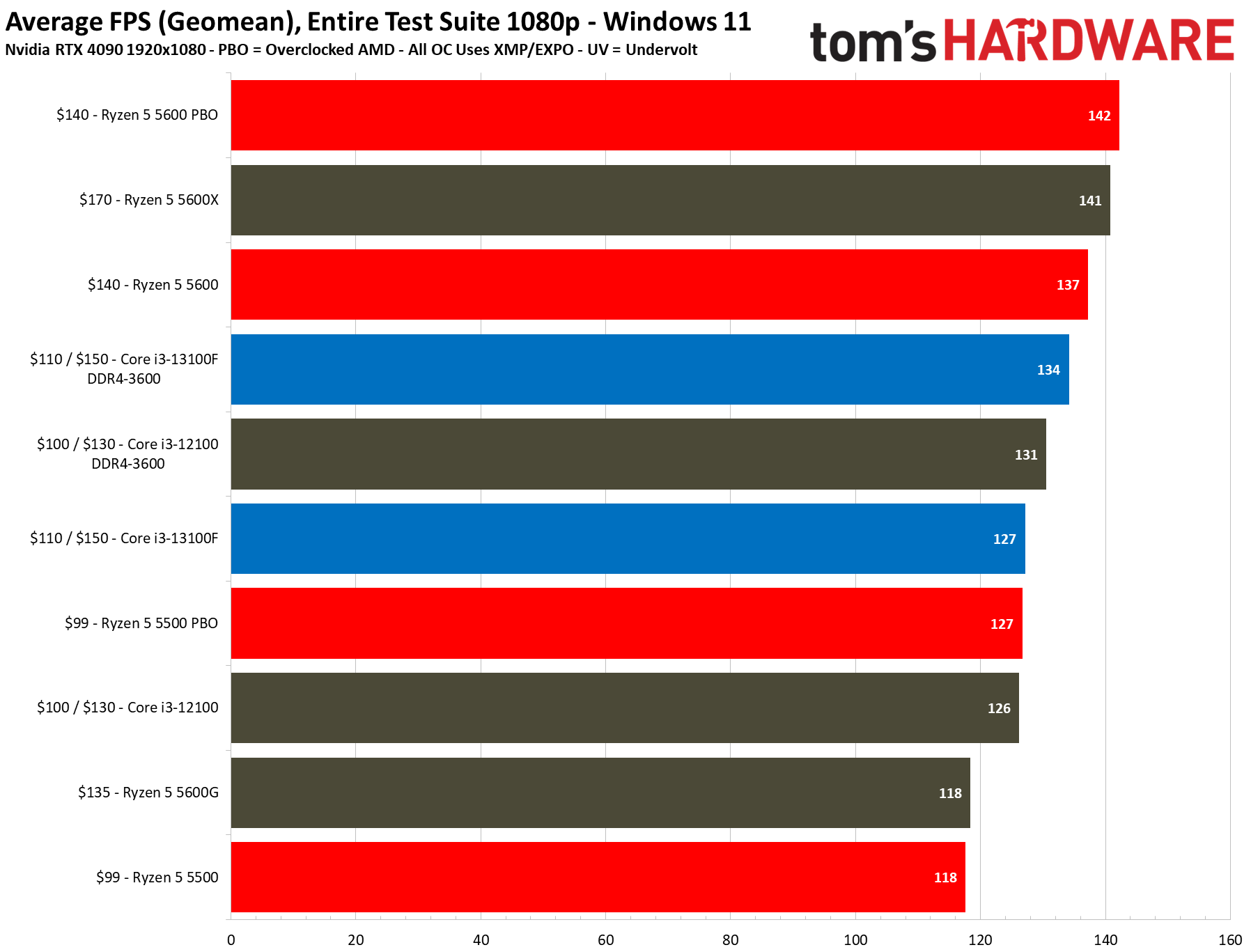
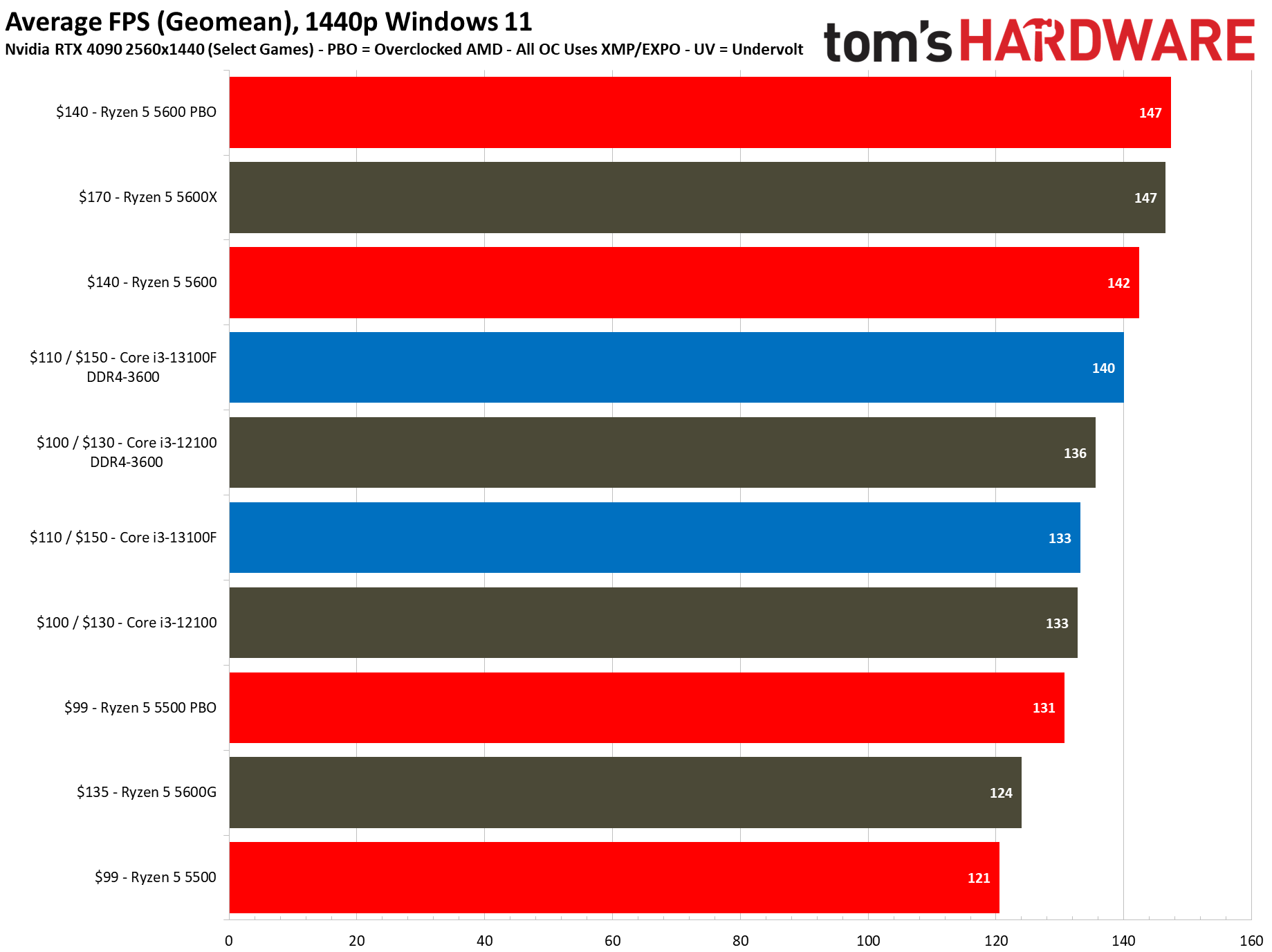
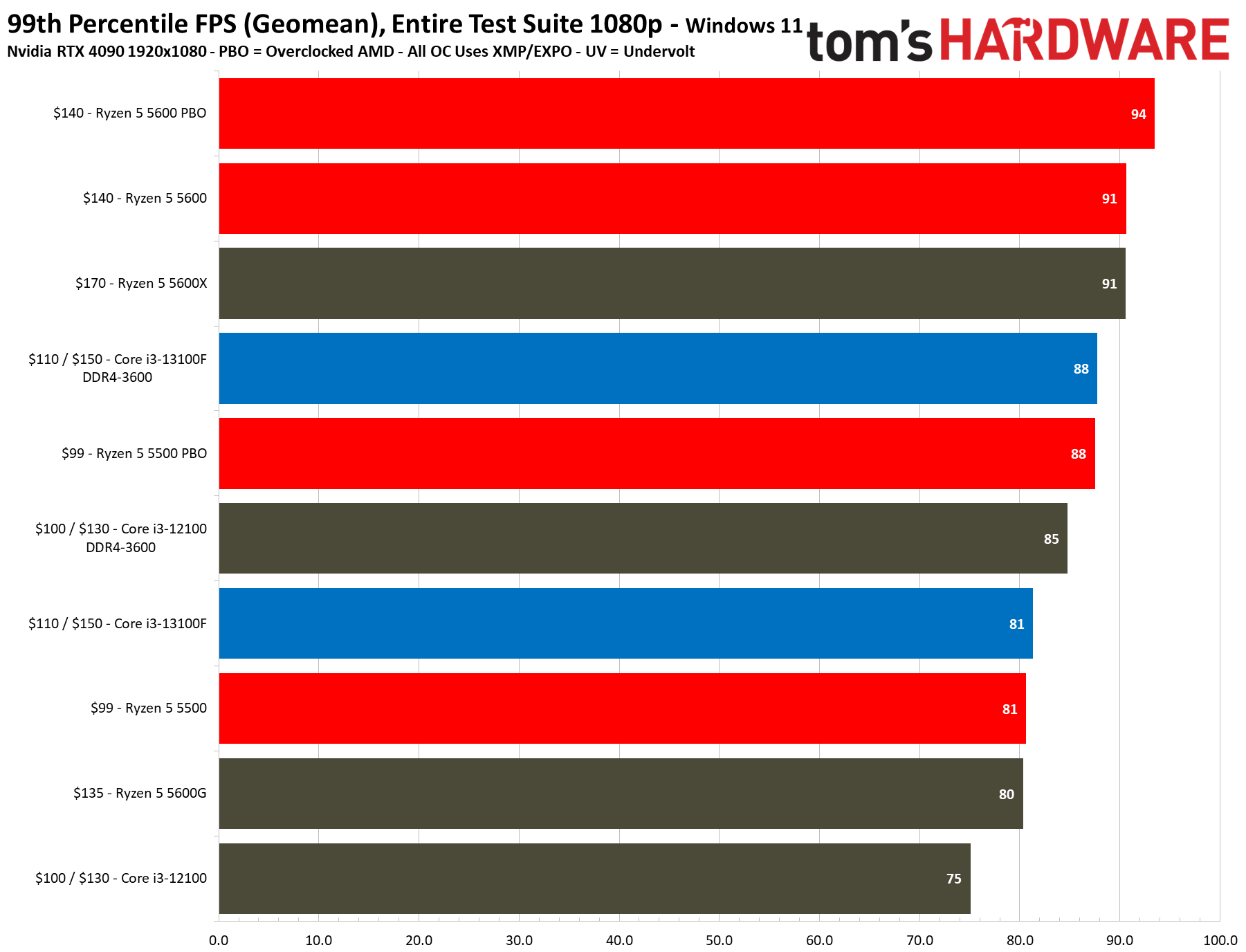
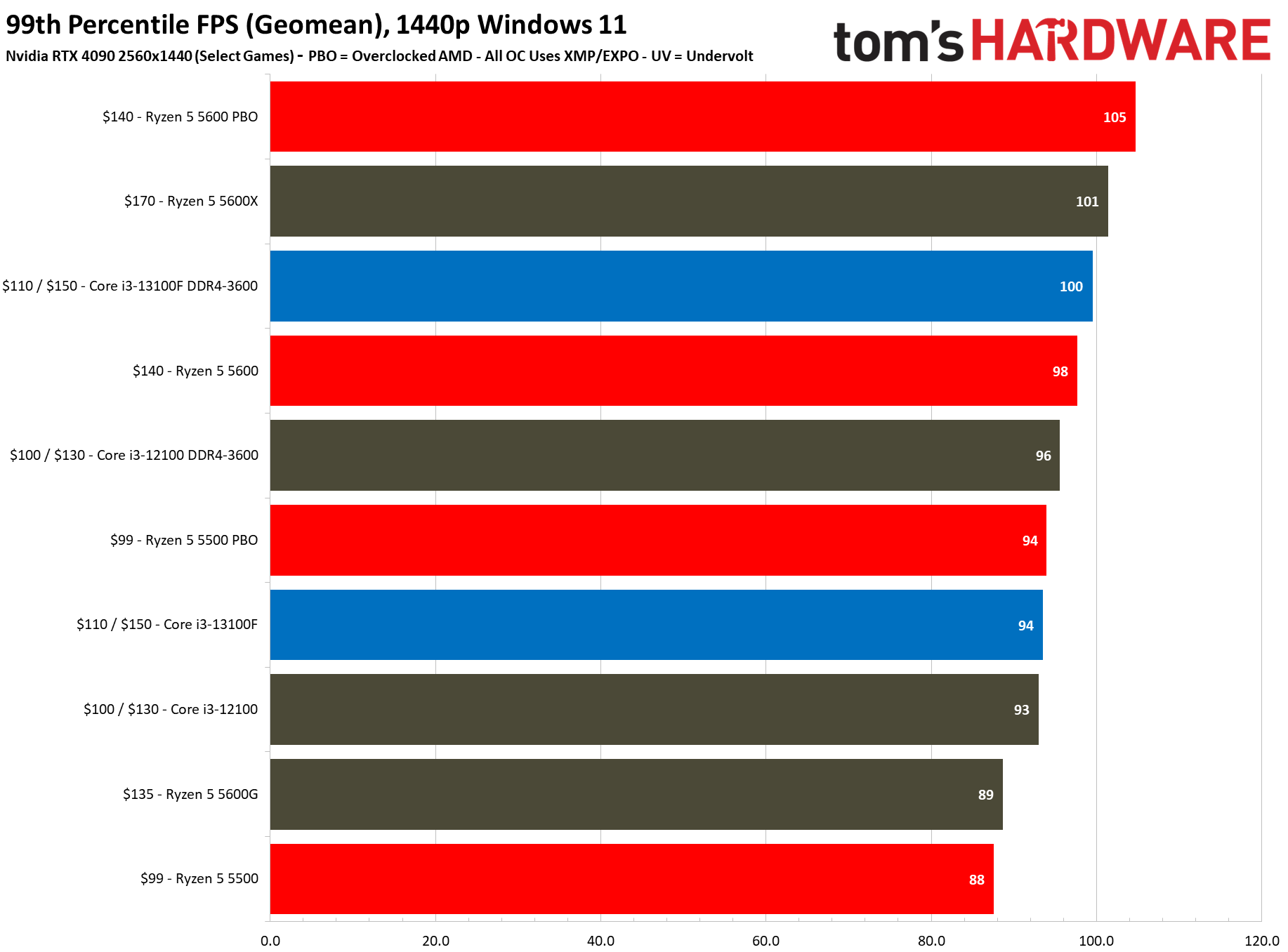
The first slides are simplified without the overclocking configs, while the remainder of the slides in the album cover the full roster of tested configurations.
The Core i3-13100 and 13100F offer the same level of gaming performance when paired with a discrete graphics card, but have a $40 price delta. That means we have two different contests in this section.
The $150 Core i3-13100 faces off with the $140 Ryzen 5 5600. The Ryzen 5 5600 is 8% faster than the Core i3-13100 at stock settings, and 6% faster after overclocking. That's an impressive advantage, especially given that the Ryzen 5 5600 regularly retails for $10 less.
The Core i3-12100 remains a viable gaming alternative at $130, especially because it offers basically the same performance as the 13100 at stock and overclocked settings, but for $20 less. However, the Ryzen 5 5600 still holds the performance lead by decent margins, but for a 7% upcharge. Given the Ryzen 5 5600's impressive advantages that we'll see in other areas, like power efficiency and performance in heavily-threaded work, it's the easy winner in the $130 to $150 price class.
Meanwhile, the $110 Core i3-13100F faces the $99 Ryzen 5 5500. The 13100F is 8% faster in 1080p gaming than the 5500 at stock settings, and 5% faster after overclocking. The Ryzen 5 5500 has a PCIe 3.0 connection instead of support for PCIe 4.0 and 5.0 like the 13100F, giving the 13100F the victory over the 5500.
The 13100F's win isn't unchallenged, though: The Core i3-12100F is an even better deal. The Core i3-12100F comes into the conversation at the same pricing as the 5500 and with a 7% advantage in gaming, giving it the win over the Ryzen 5 5500 and the Core i3-13100F. If you can find it in stock, the 12100F is the best value in the $100 price range, with the 13100F being a good alternative if it remains around $110.
Intel's decision to use the same design for the 13100/F and merely increase boost clocks by 200 MHz doesn't do enough to deliver any tangible increase in value — in fact, its higher pricing only reduces the appeal of the Core i3. We see a dead heat between the two Core i3 models in gaming at stock settings and a 2% difference after tuning the memory. That certainly isn't enough to justify the Core i3-13100's higher price tag, especially given that both chips can drop into the same motherboards and have identical features.
We also included the $170 Ryzen 5 5600X in our test pool, but as you can see, it isn't a good value compared to the Ryzen 5 5600. Additionally, the Ryzen 5 5600G, a Cezanne APU, falls into this price category. This chip was a wonderful alternative for budget gaming machines during the GPU shortage, but it's really meant for low-end gaming machines that don't have a discrete graphics card.
The AMD vs Intel contest can vary in different game titles, with some clearly favoring one architecture over the other. As such, you should peruse the individual game benchmark results below for a closer look at the test results.
Cyberpunk 2077 Benchmarks on Intel Core i3-13100F
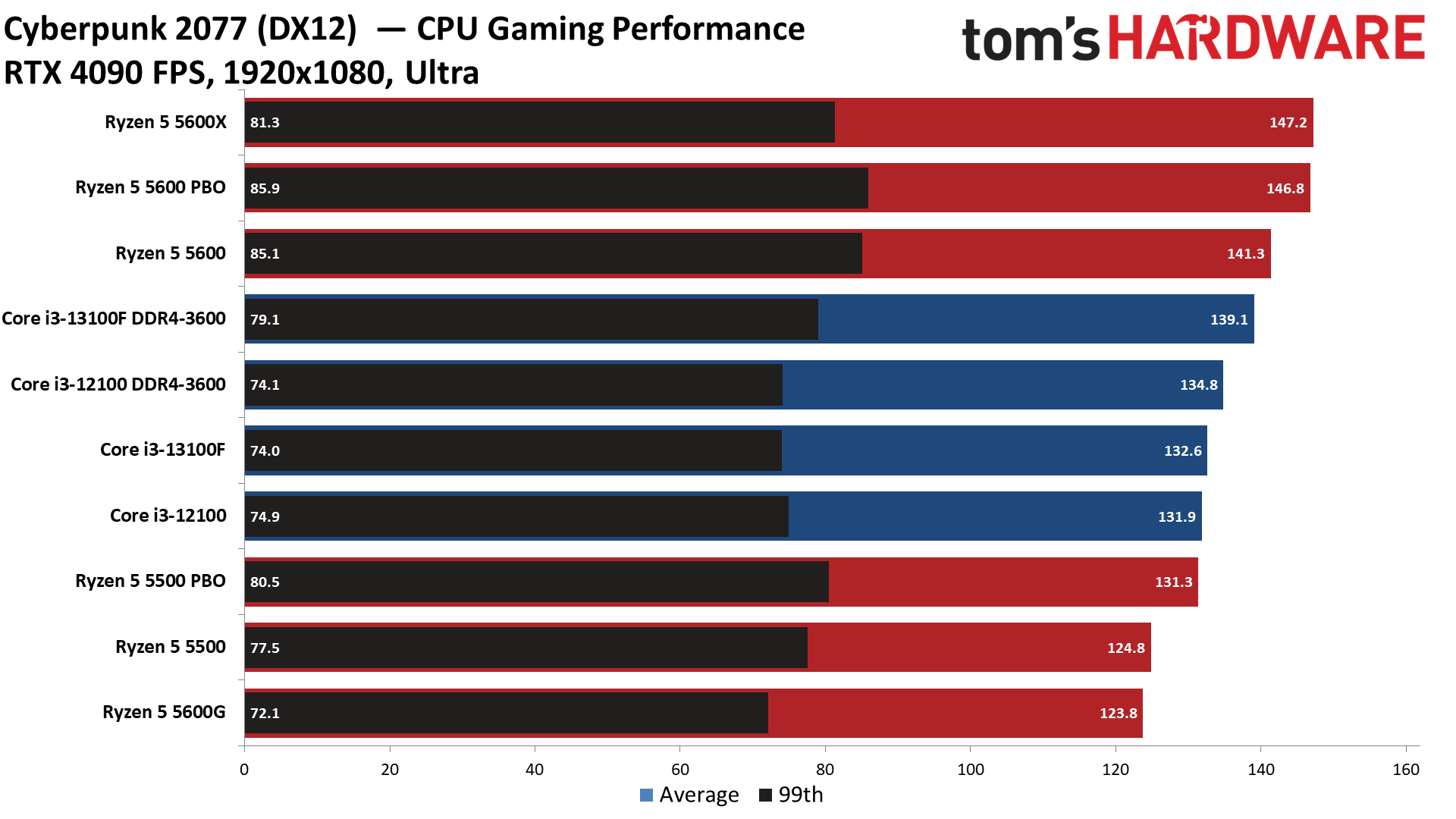
Far Cry 6 Benchmarks on Intel Core i3-13100F
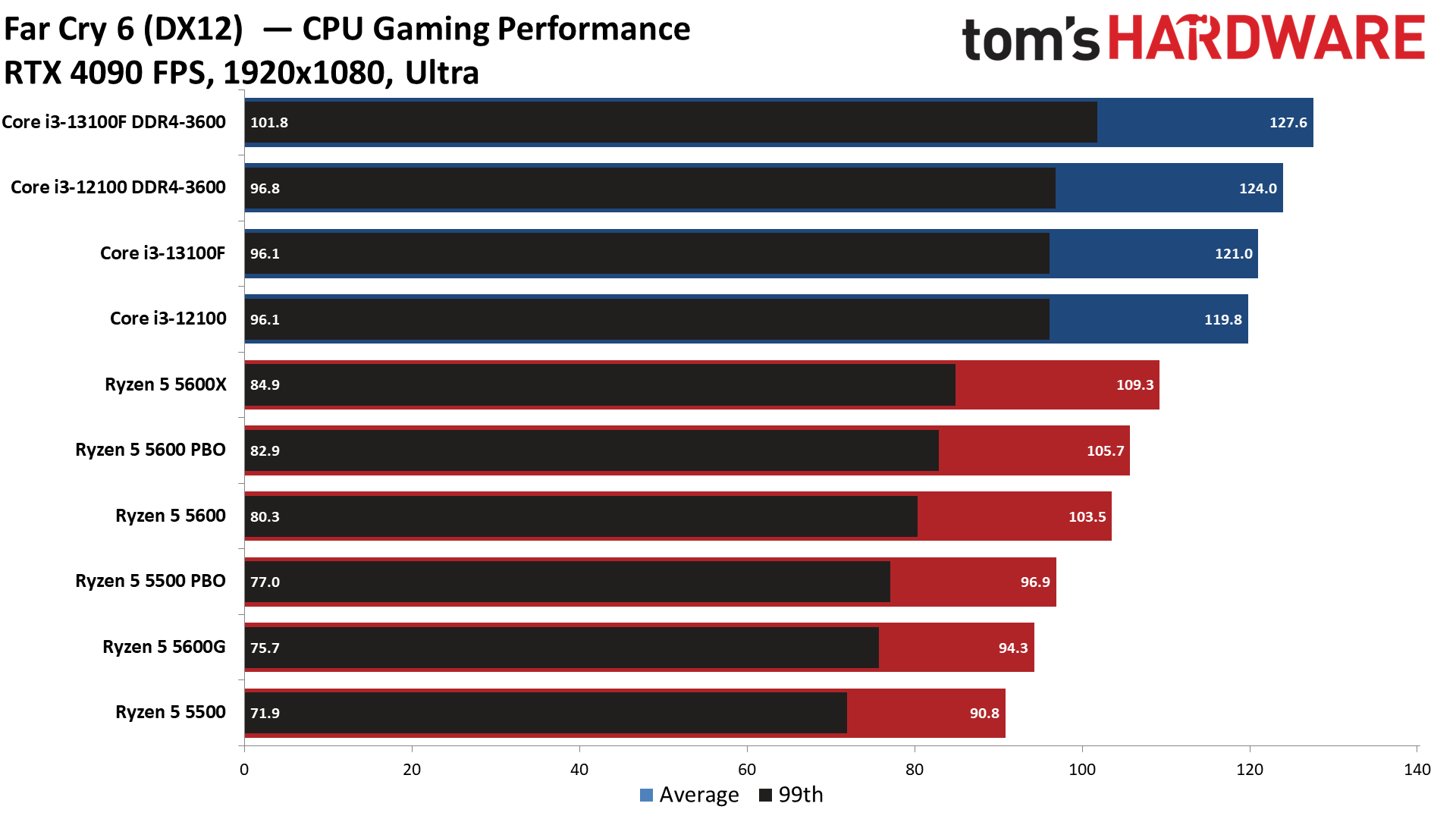
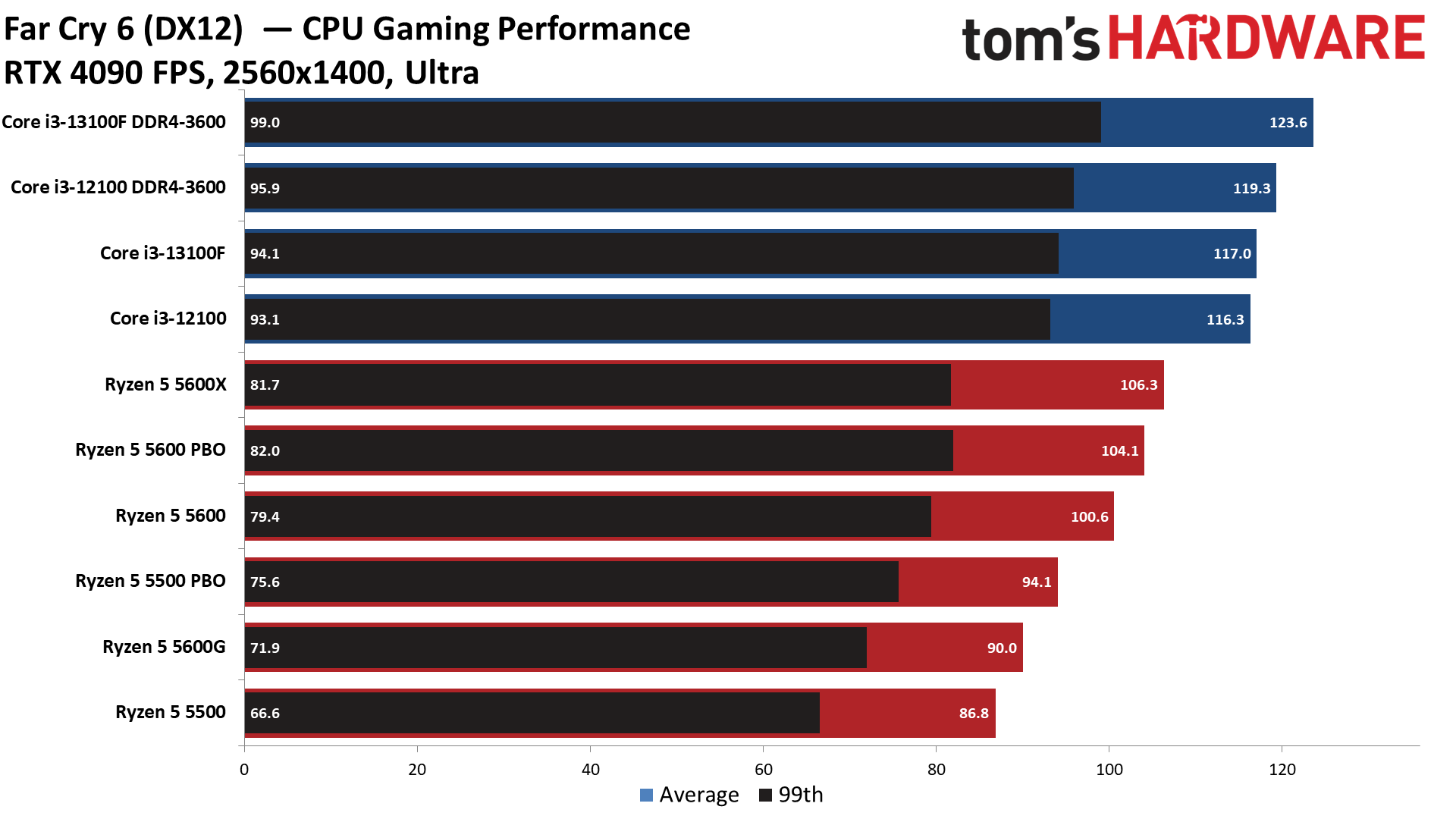
F1 2021 Benchmarks on Intel Core i3-13100F
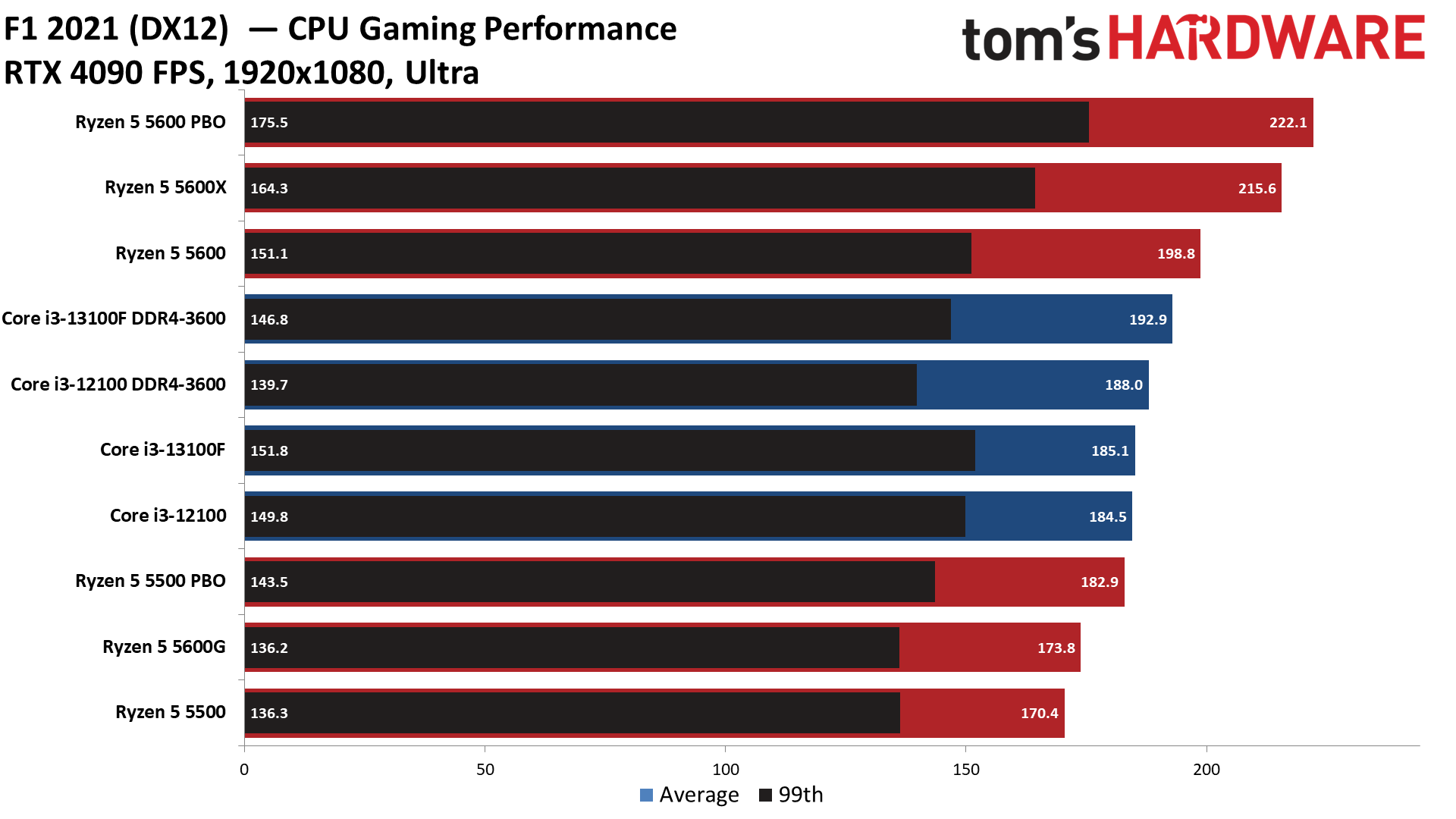
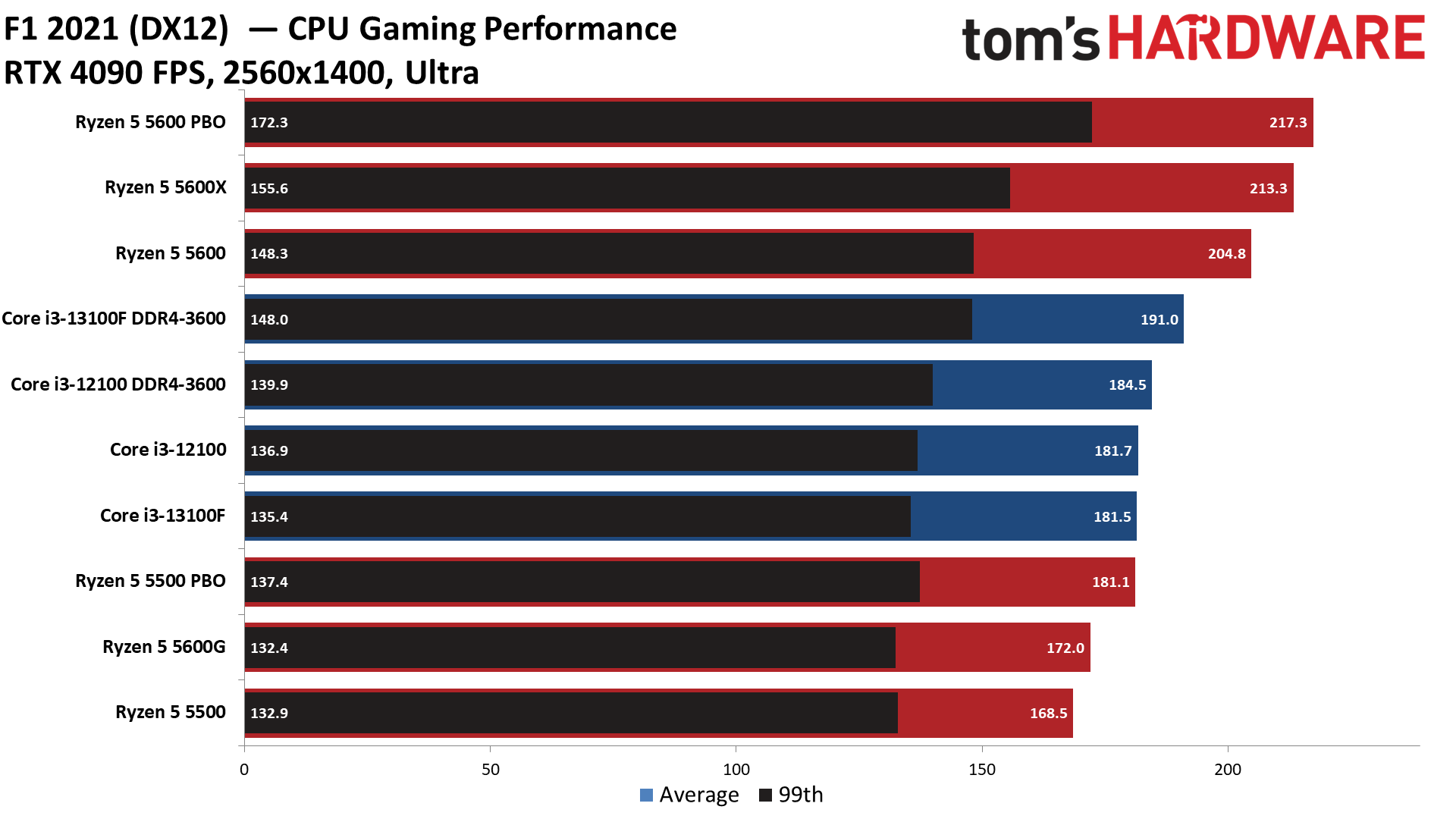
Hitman 3 Benchmarks on Intel Core i3-13100F
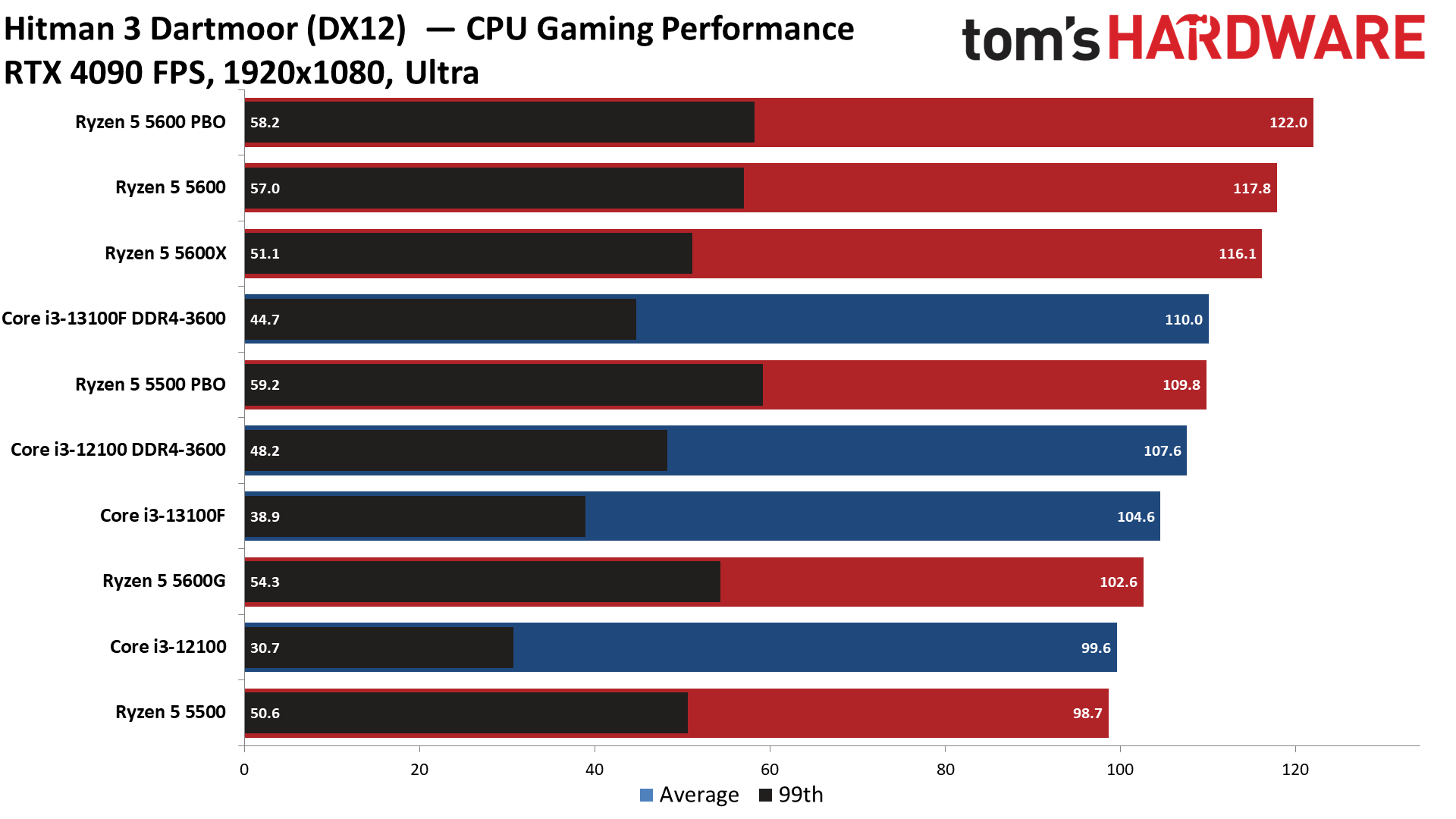
Microsoft Flight Simulator 2021 Benchmarks on Intel Core i3-13100F
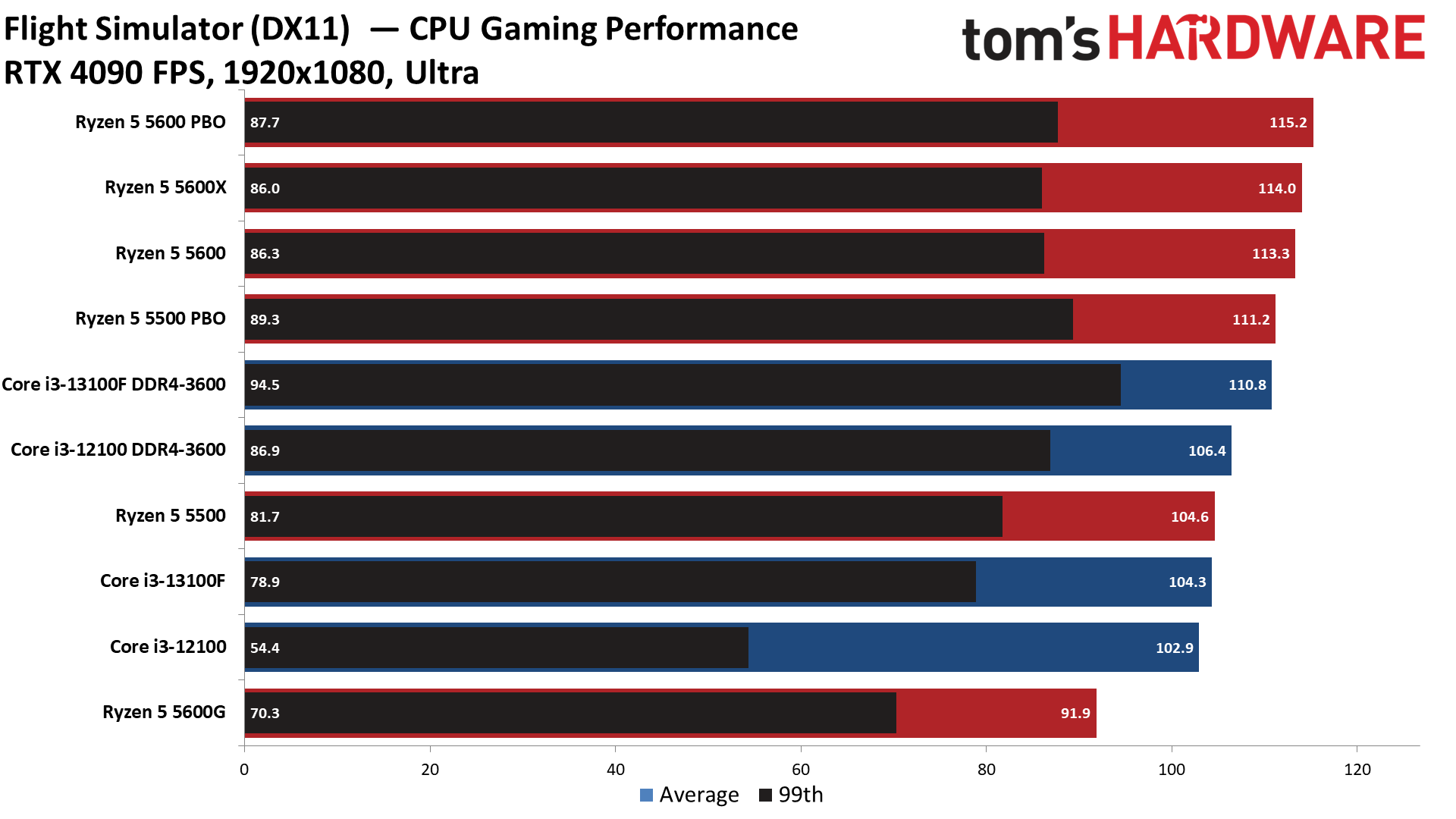
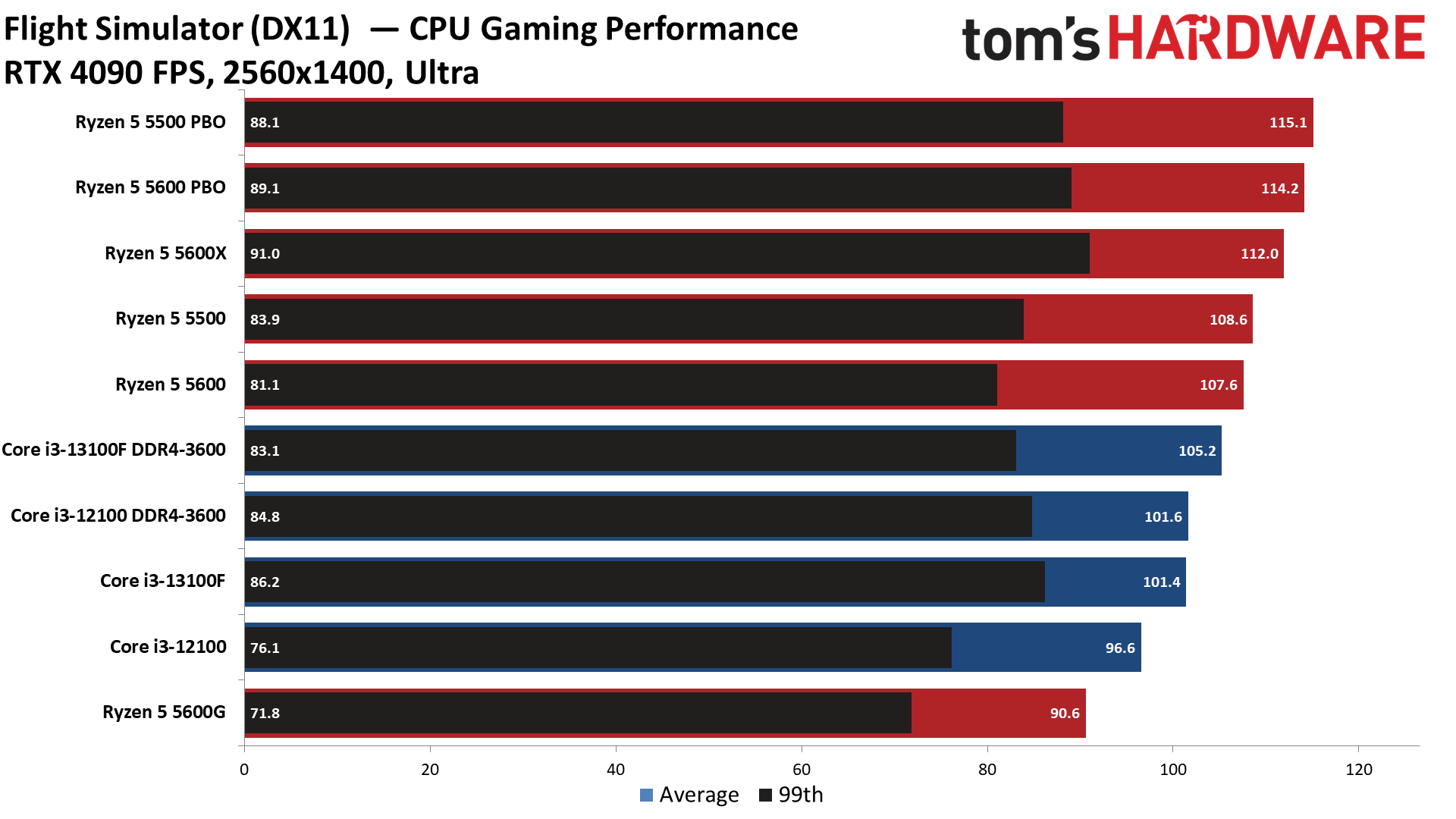
Red Dead Redemption 2 Benchmarks on Intel Core i3-13100F
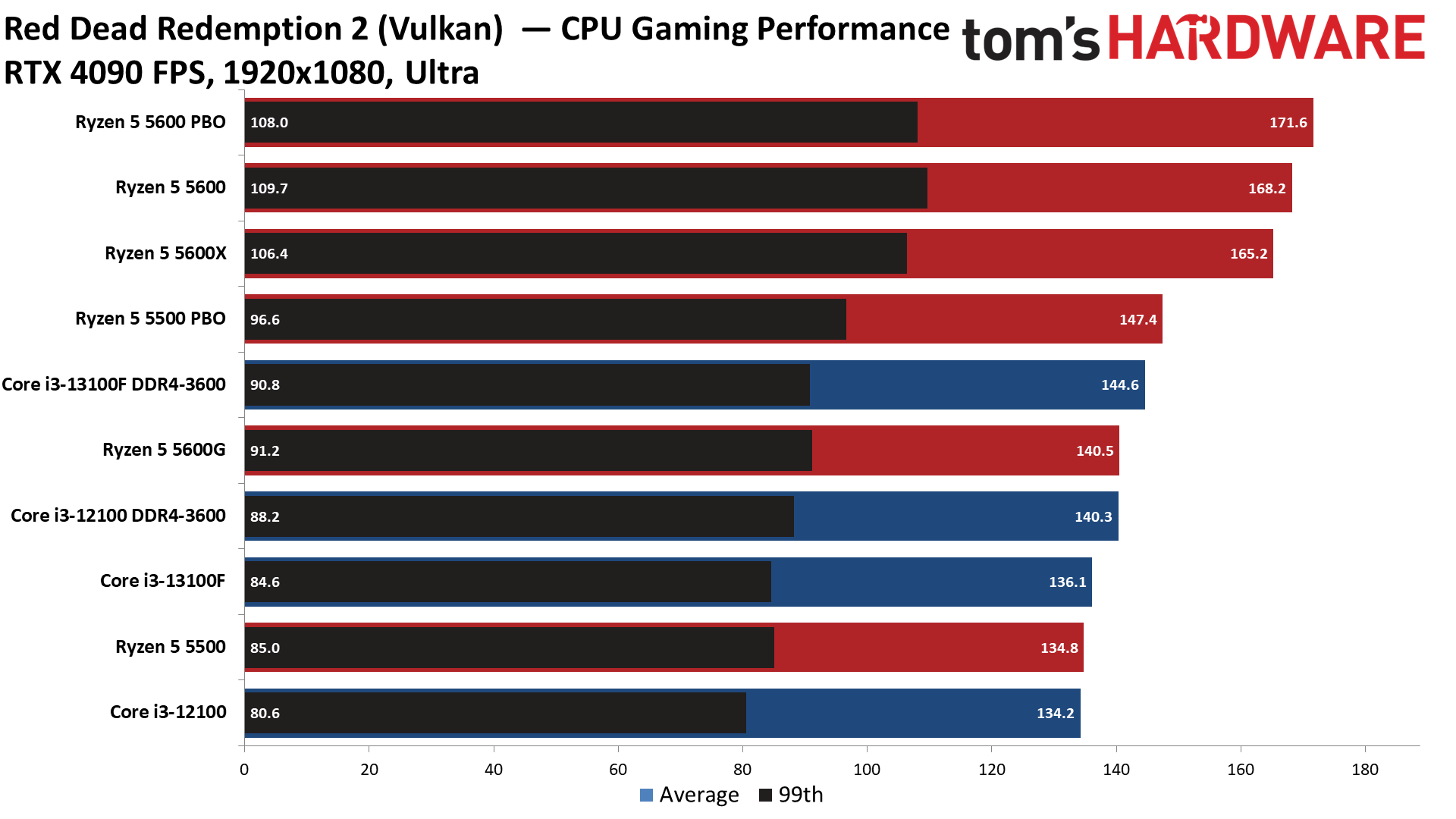
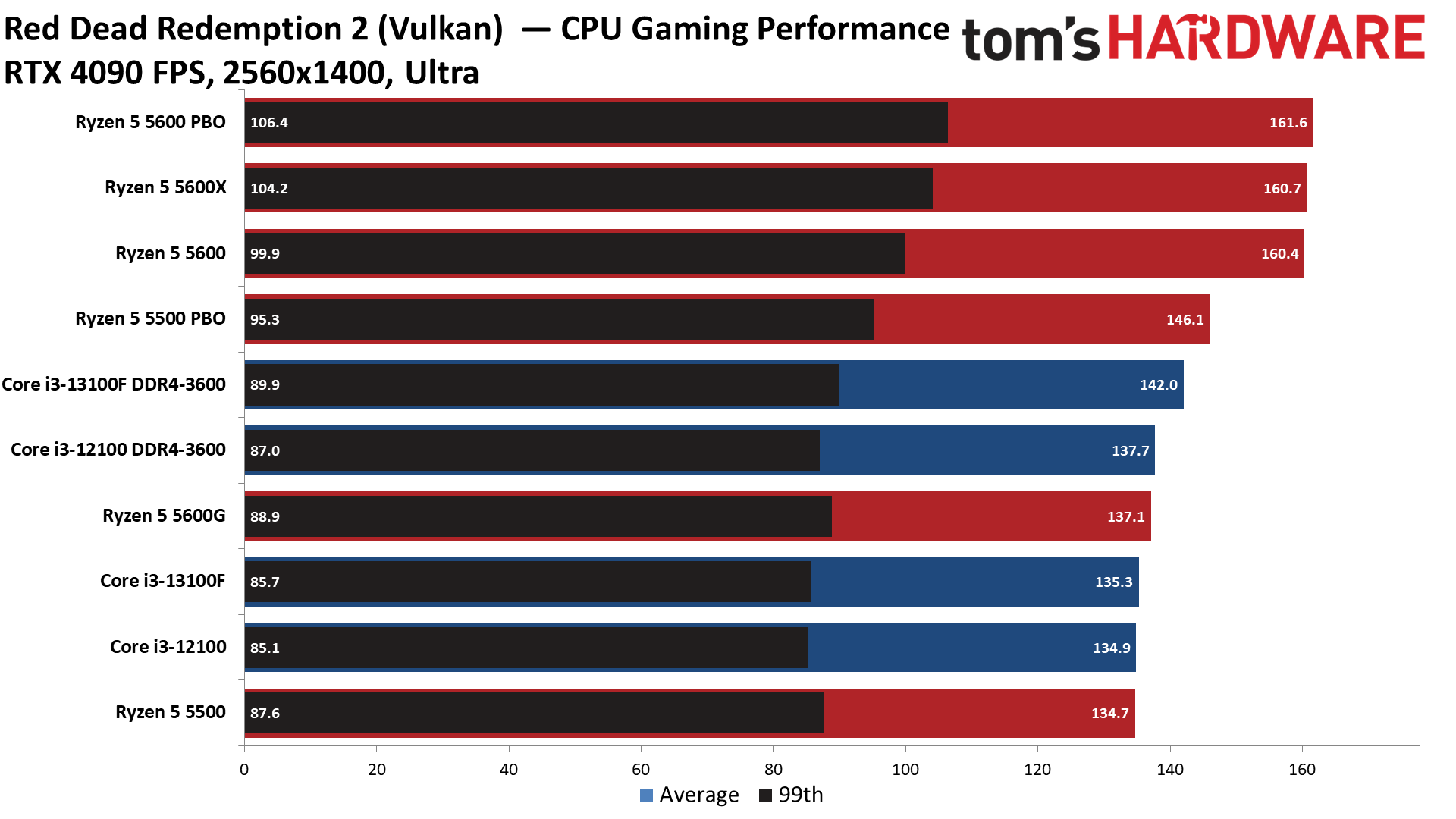
Warhammer 3 Benchmarks on Intel Core i3-13100F
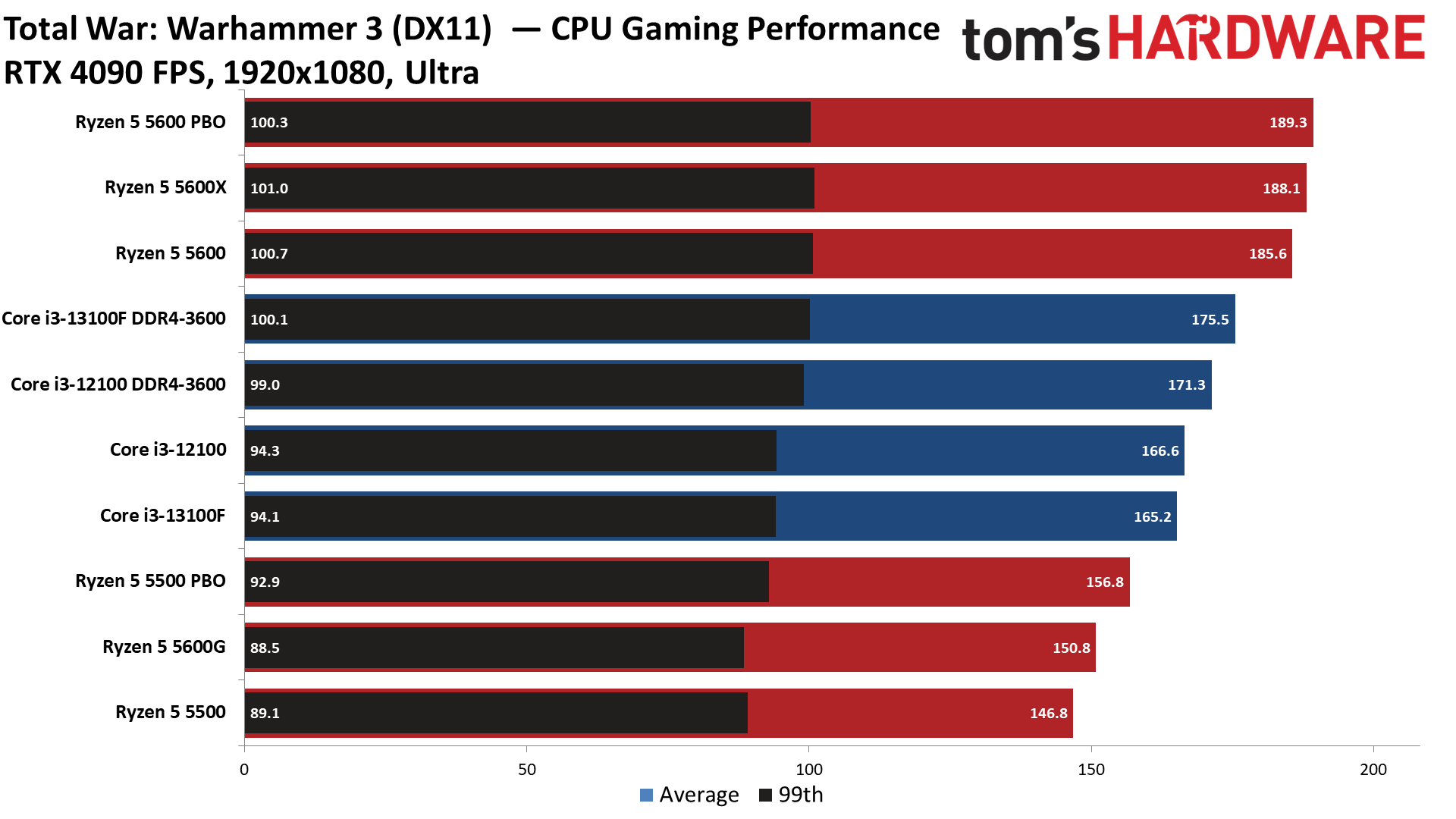
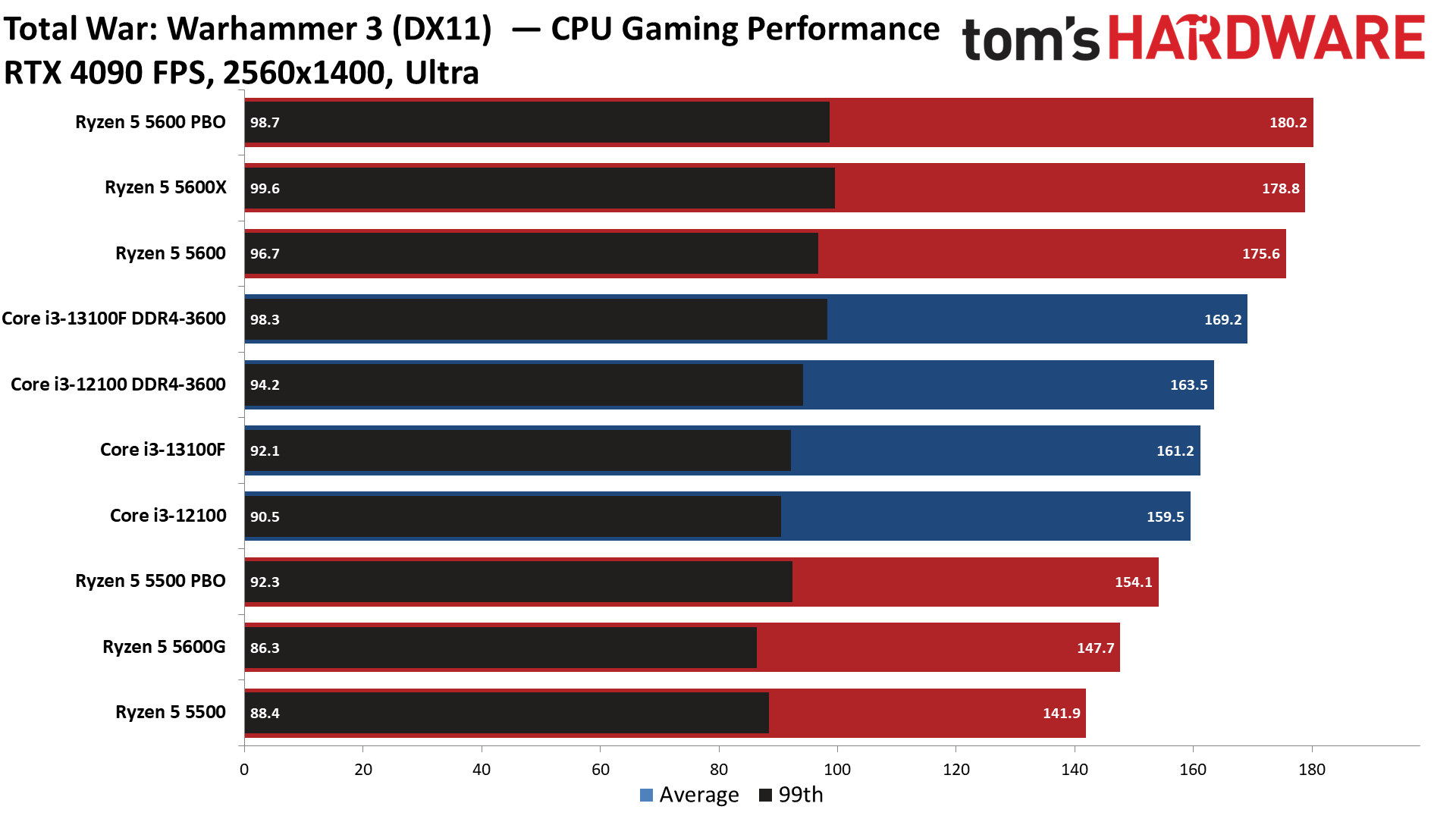
Watch Dogs Legion Benchmarks on Intel Core i3-13100F
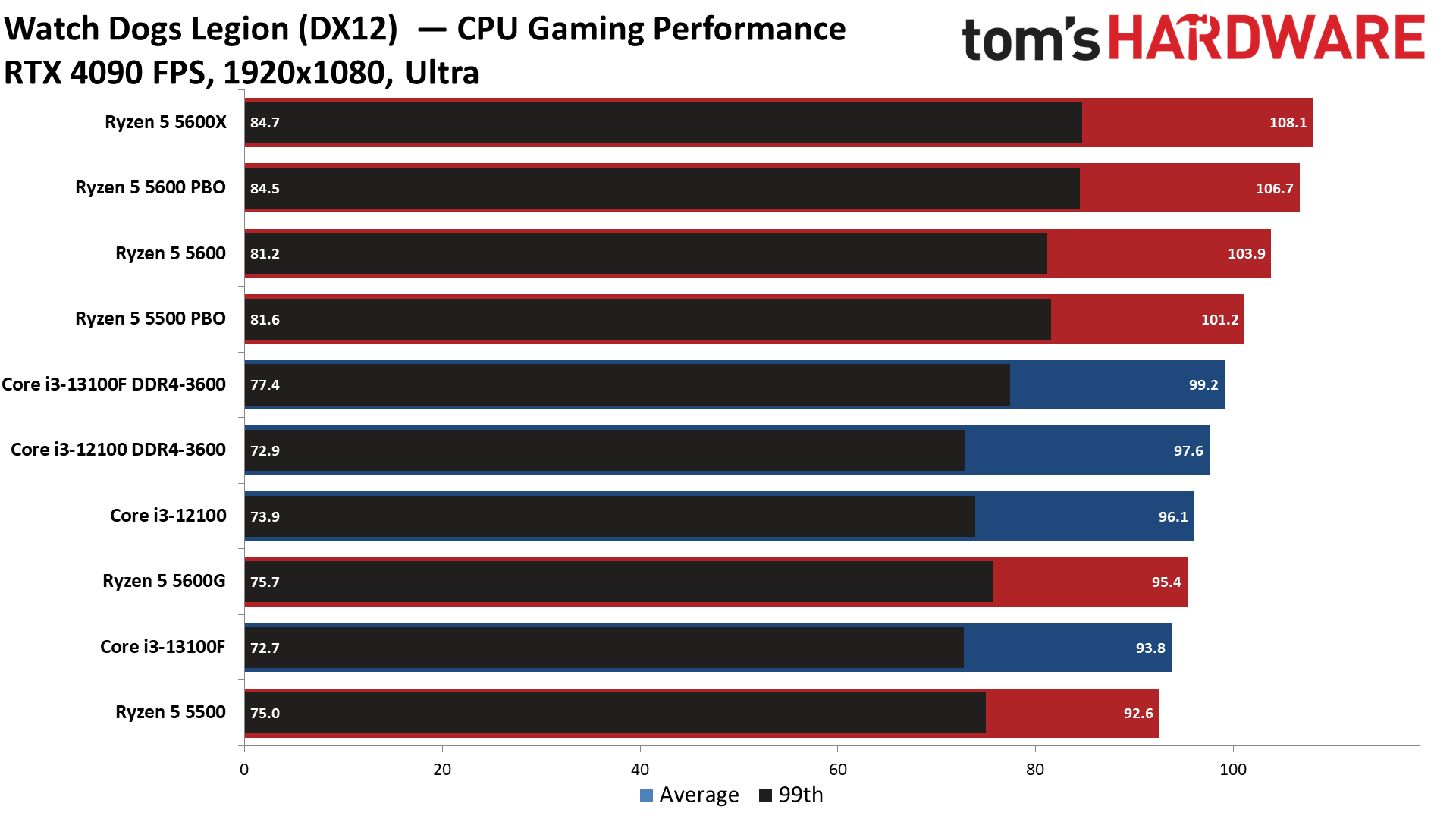
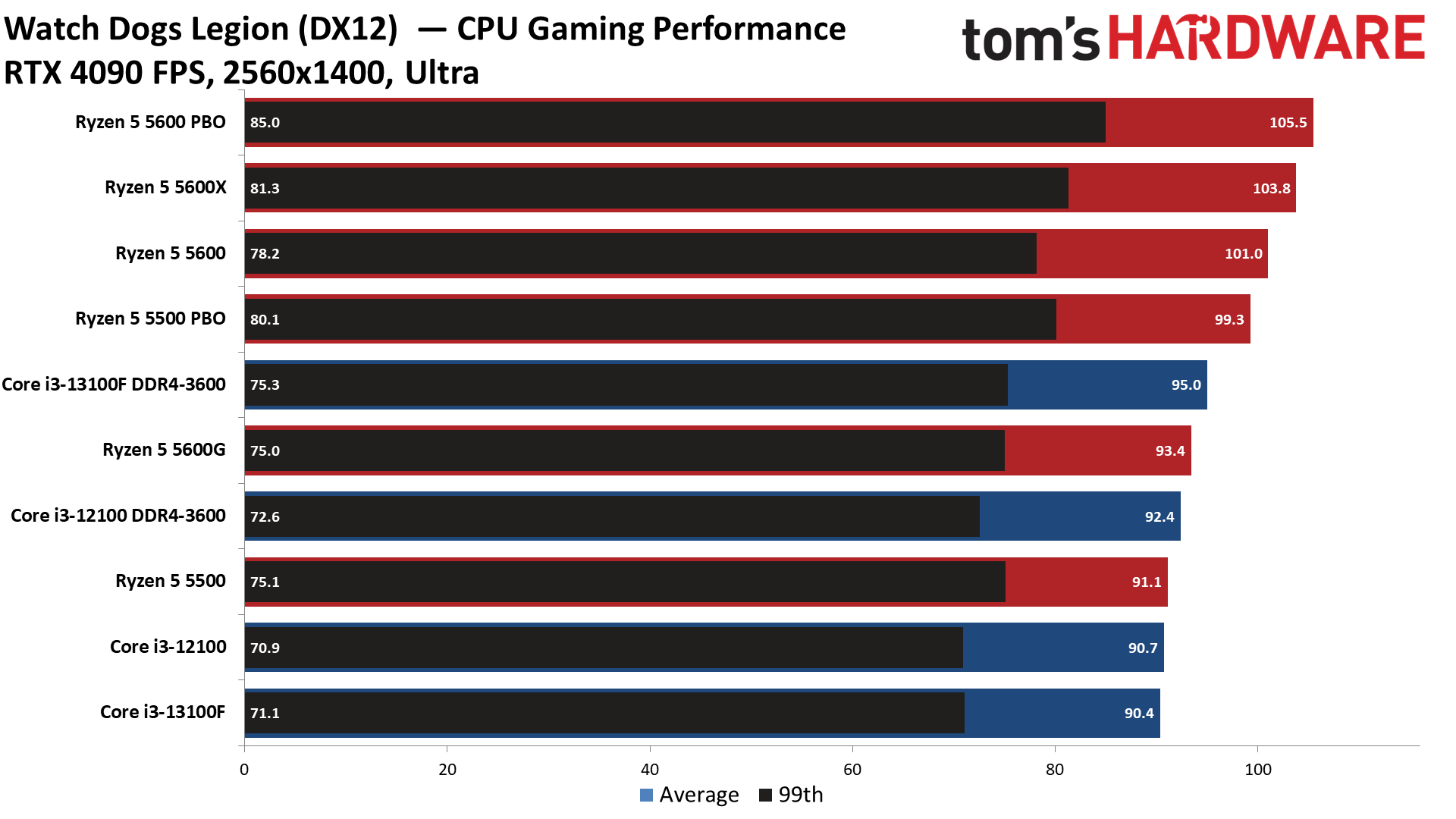
- MORE: AMD Ryzen 7 7800X3D vs Intel Core i9-13900K vs Core i7-13700K
- MORE: Best CPU for gaming
- MORE: CPU Benchmark Hierarchy
- MORE: Intel vs AMD
- MORE: How to Overclock a CPU
Intel Core i3-13100F Productivity Benchmarks — The TLDR
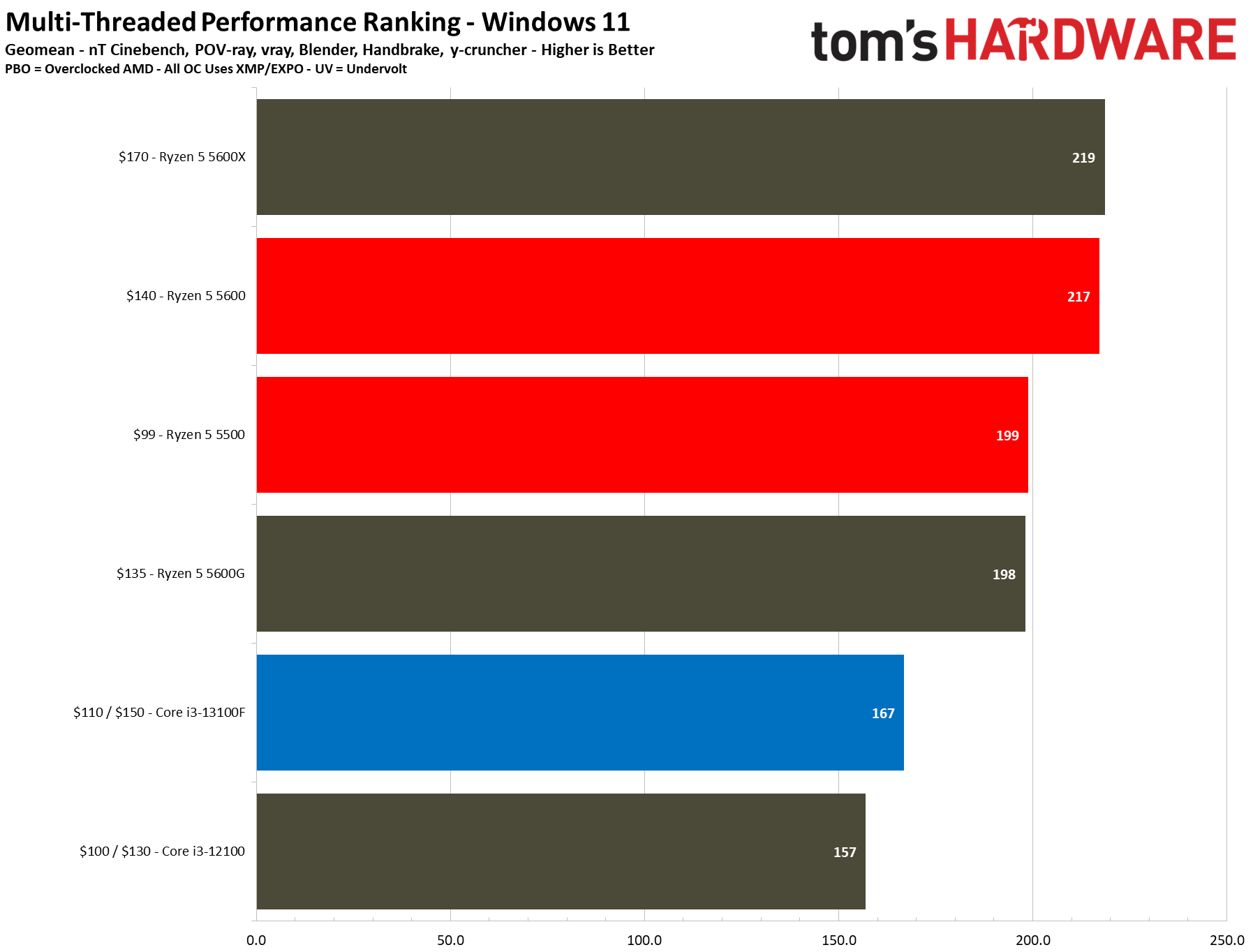
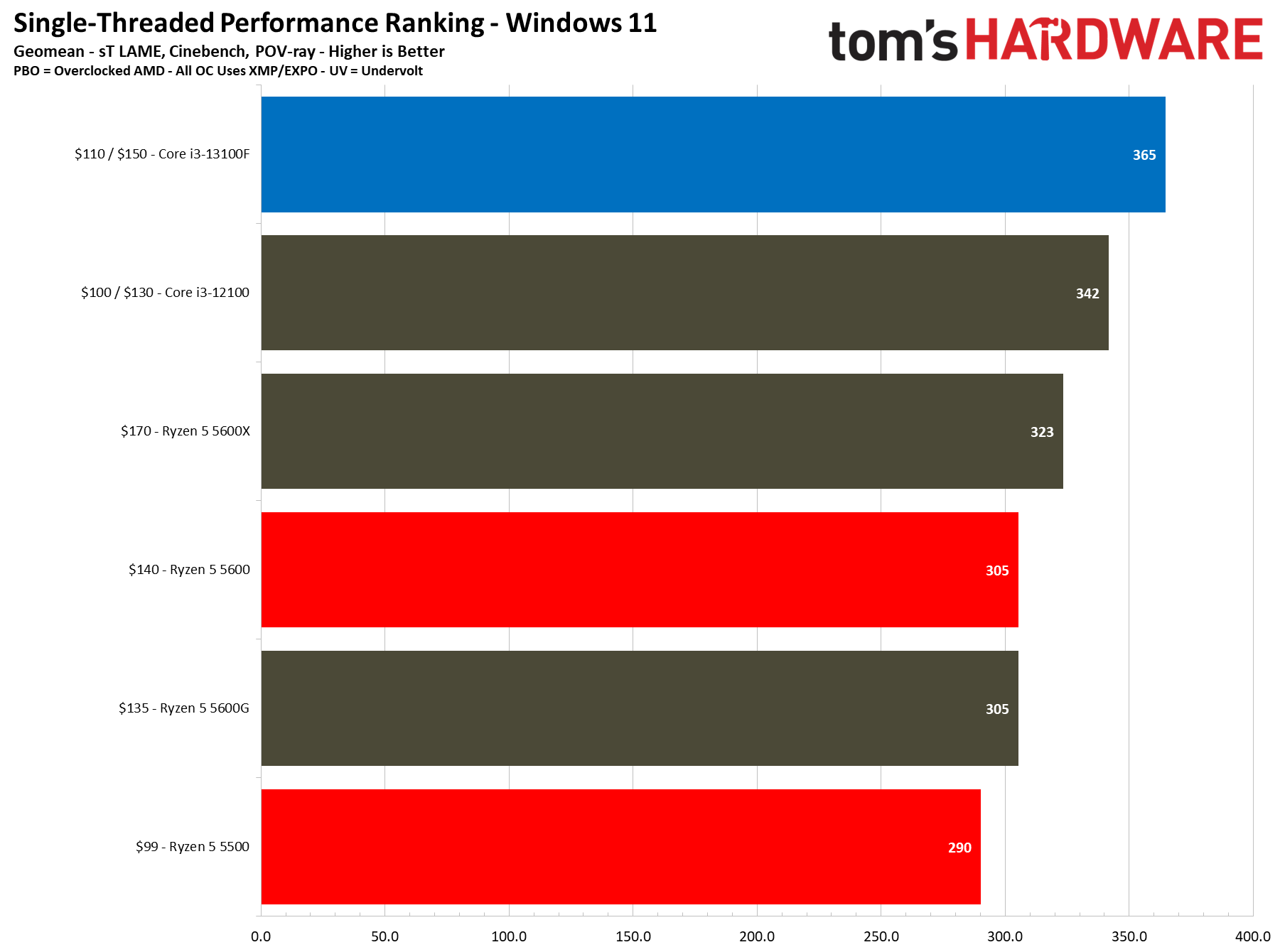
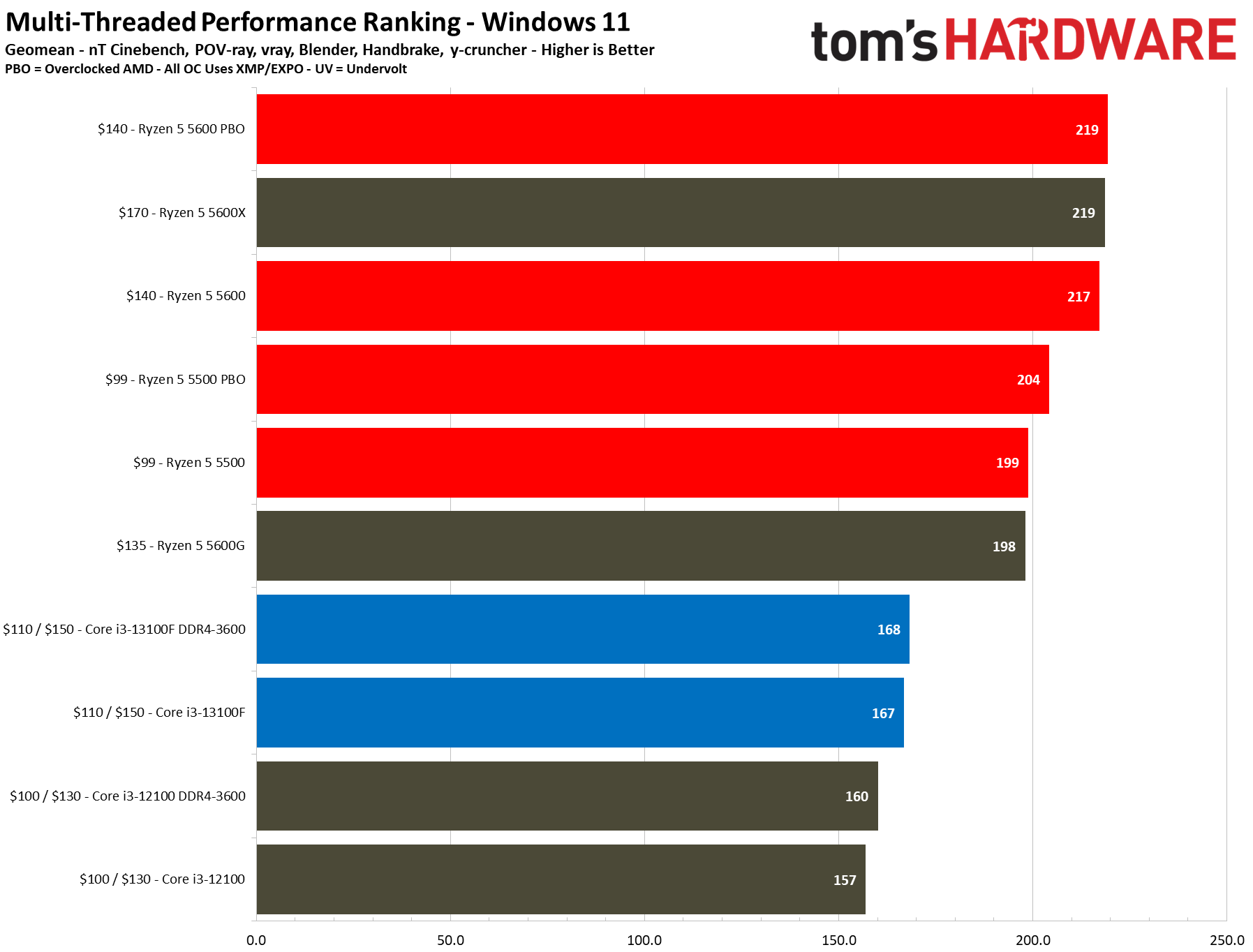
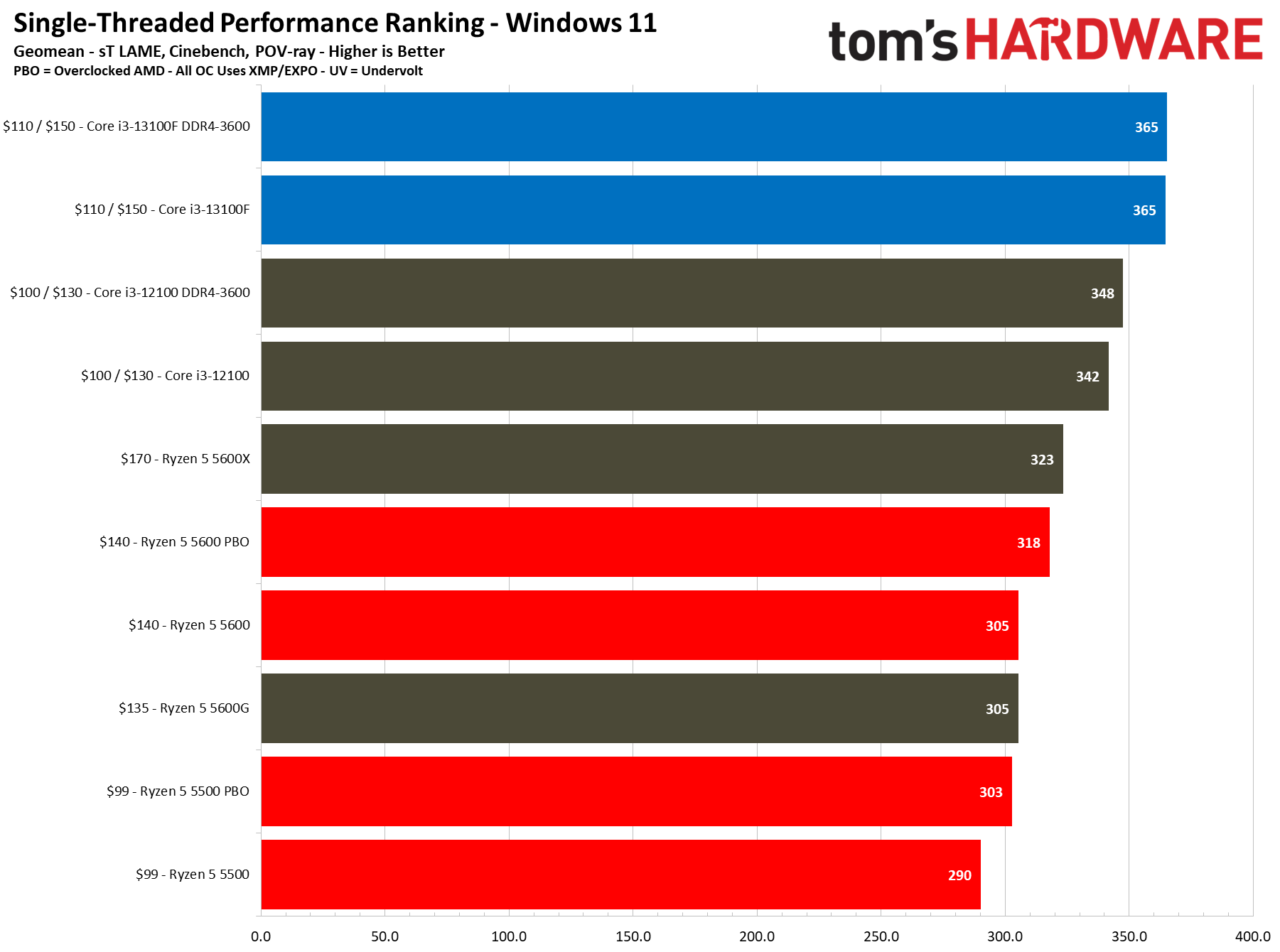
The first slides are simplified without the overclocking configs, while the remainder of the slides in the album covers the full roster of tested configurations. We boil productivity application performance down into two broad categories: single- and multi-threaded. These slides show the geometric mean of performance in several of our most important tests in each category, but be sure to look at the individual benchmark results below.
Again, due to the $40 price gap between them, the $150 Core i3-13100 and $110 13100F each have a different competitor in our test suite. With six Zen 3 cores and 12 threads, the $140 Ryzen 5 5600 easily leads our threaded benchmark suite with 30% more performance than the Core i3-13100. The six-core, 12-thread $99 Ryzen 5 5600 is also plenty impressive with a 20% lead over the 13100 in threaded workloads.
The Intel 13100/F takes the lead in single-threaded work, with a 20% lead over the Ryzen 5 5600 and a 25% lead over the Ryzen 5 5500. That will result in snappier responsiveness in lighter fare, but the 13100/F's slow-downs in threaded work will be far more noticeable than its performance advantage in single-threaded work. Overall, the Ryzen 5 5600 and 5500 deliver a better blend of performance at their respective price points.
The Core i3-13100/F exhibits a more meaningful lead over the 12100/F in the productivity benchmarks than we saw in the gaming benchmarks, delivering 6% more performance in both single- and multi-threaded applications. However, this doesn't really justify a ~15% price hike, again making the 12100 the more reasonable choice if you're specifically looking to buy an Intel chip.
Notably, none of these chips benefit much from overclocking, with low-single-percentage-point gains. The benchmarks below are pretty predictable, with the Ryzen processors dominating the threaded benchmarks while Intel takes smaller leads in lightly-threaded applications. As such, we'll limit our commentary.
Rendering Benchmarks on Intel Core i3-13100F
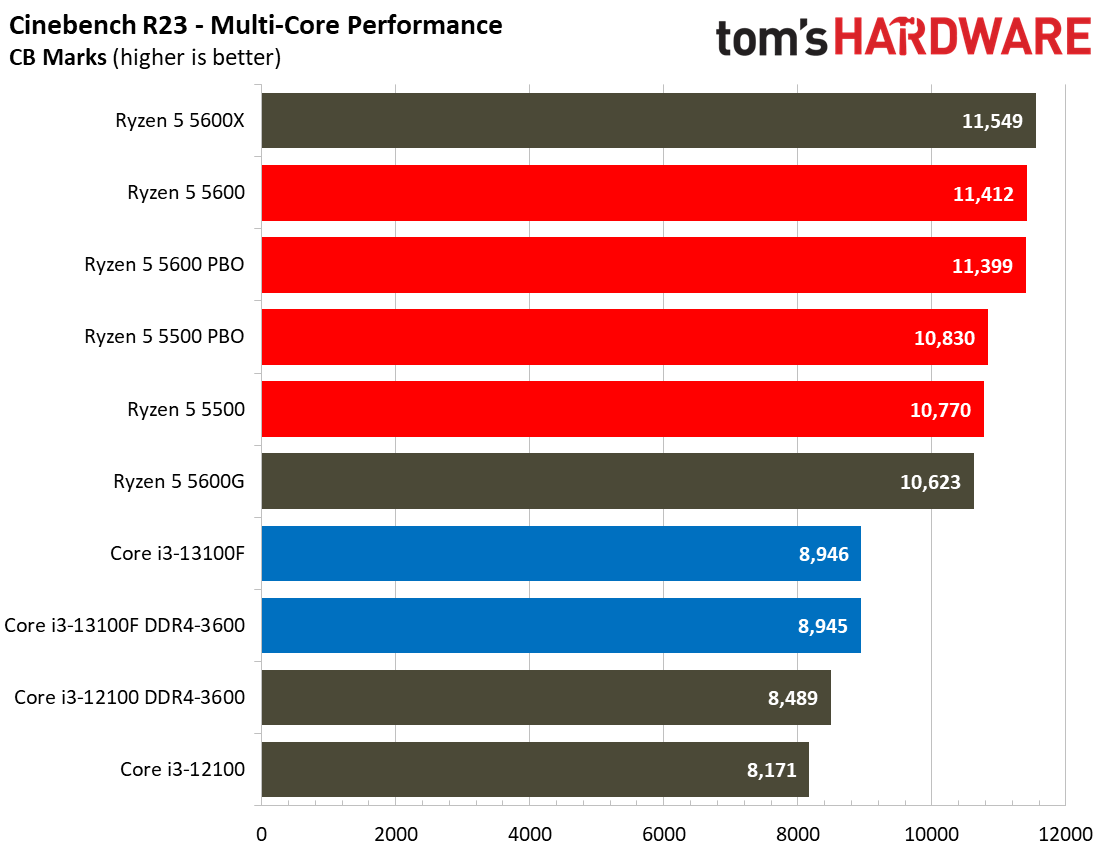
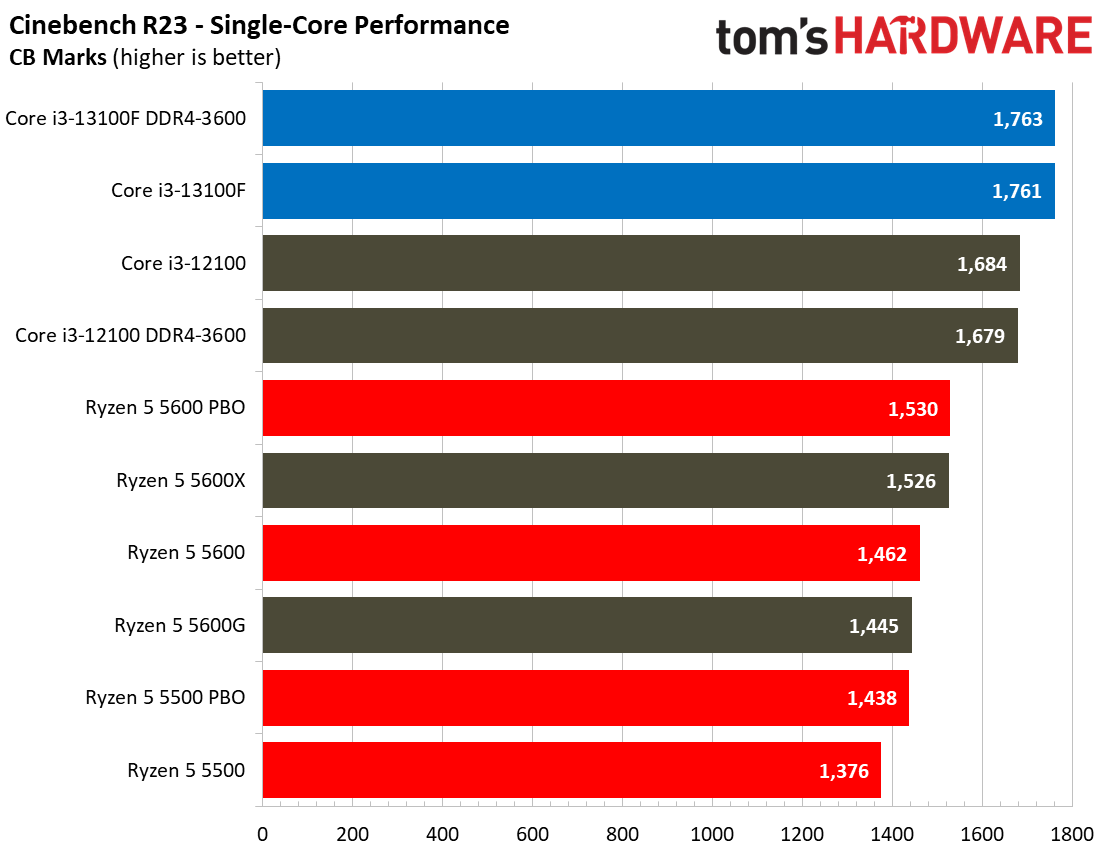

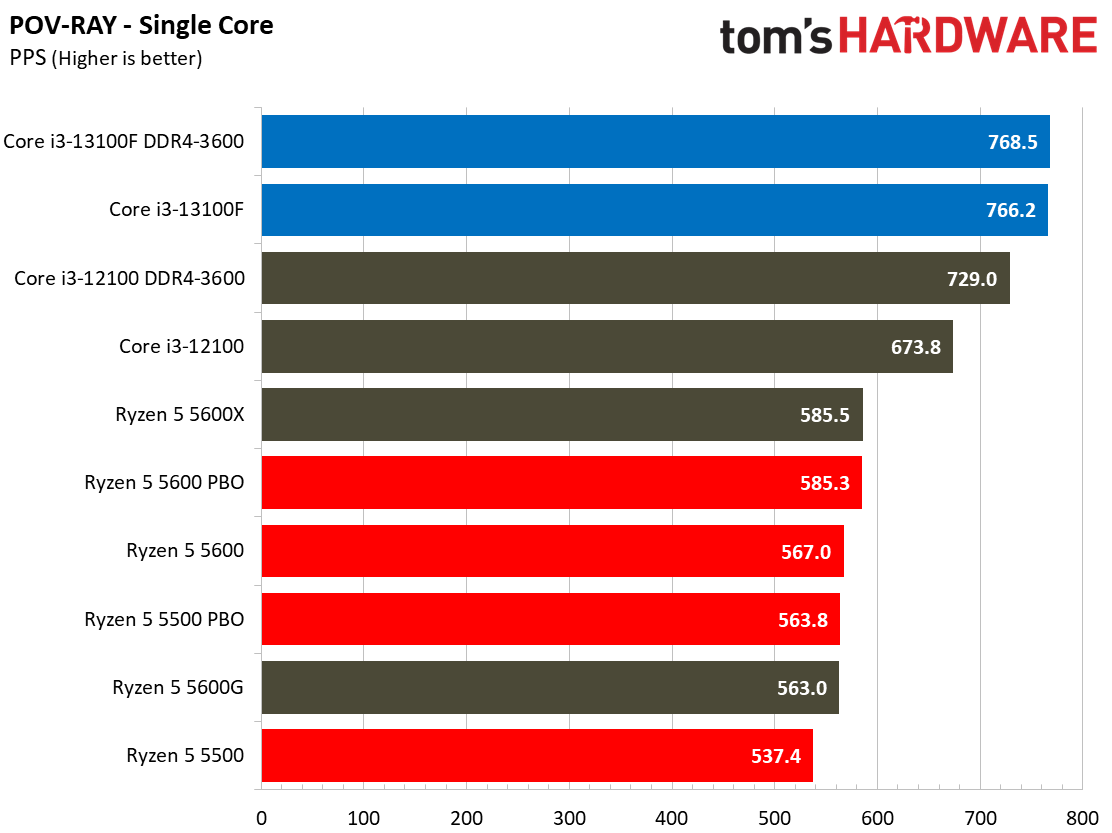
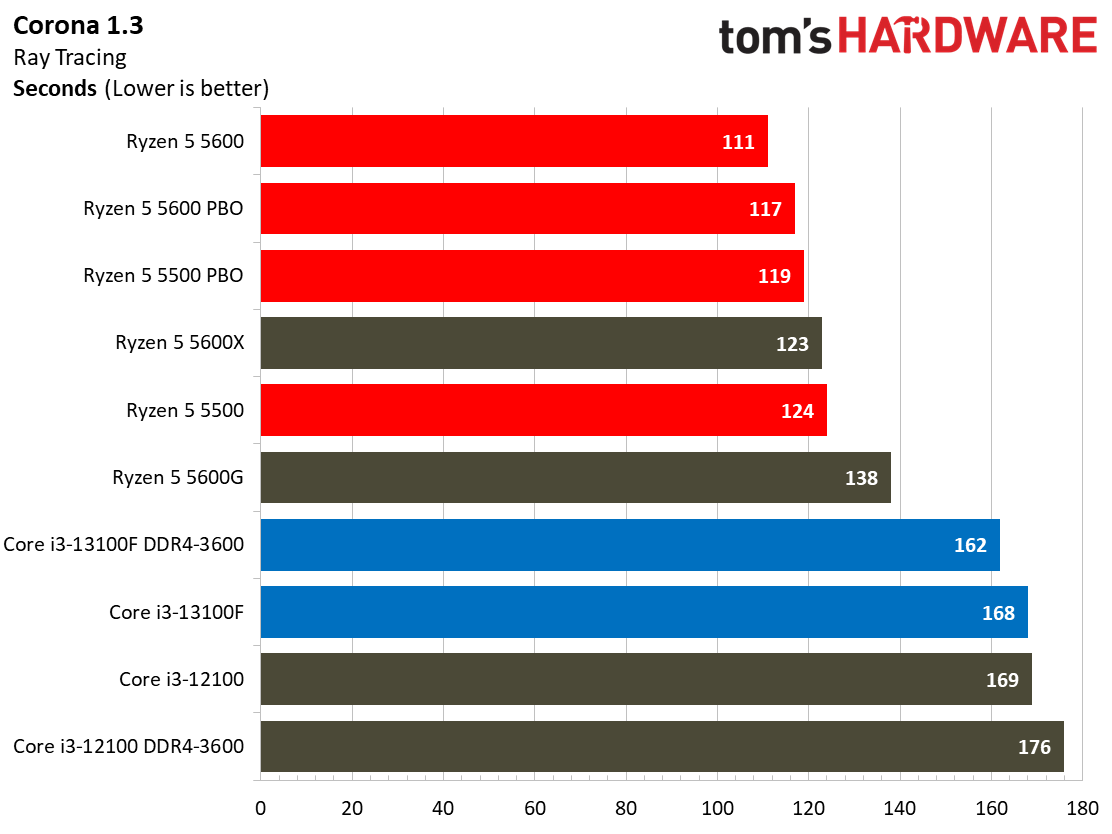
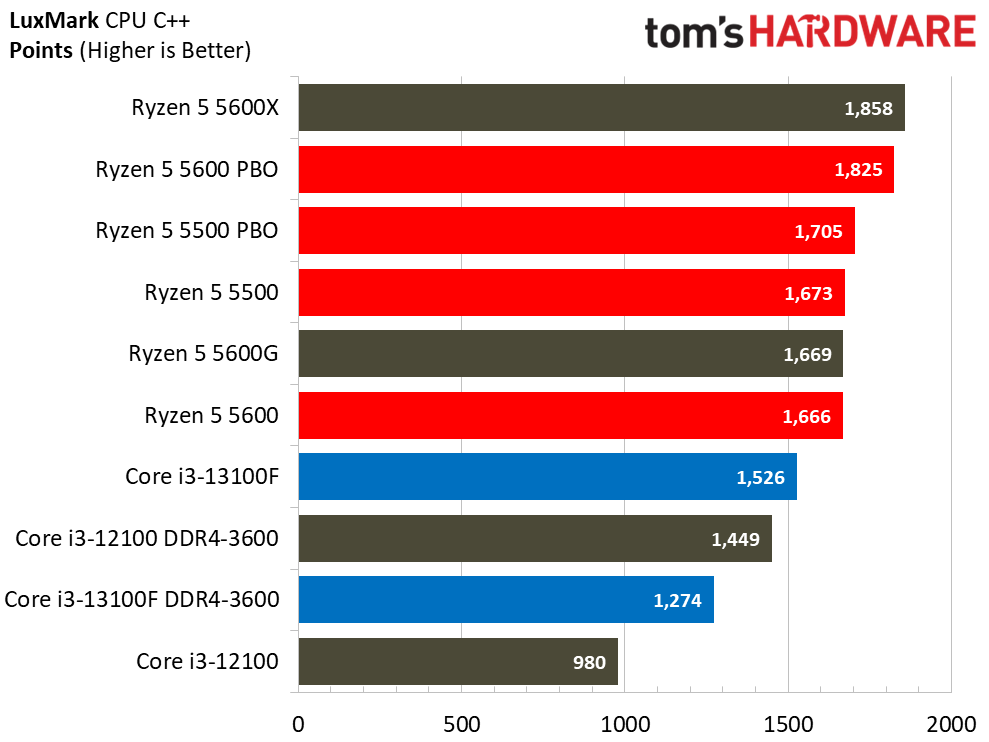
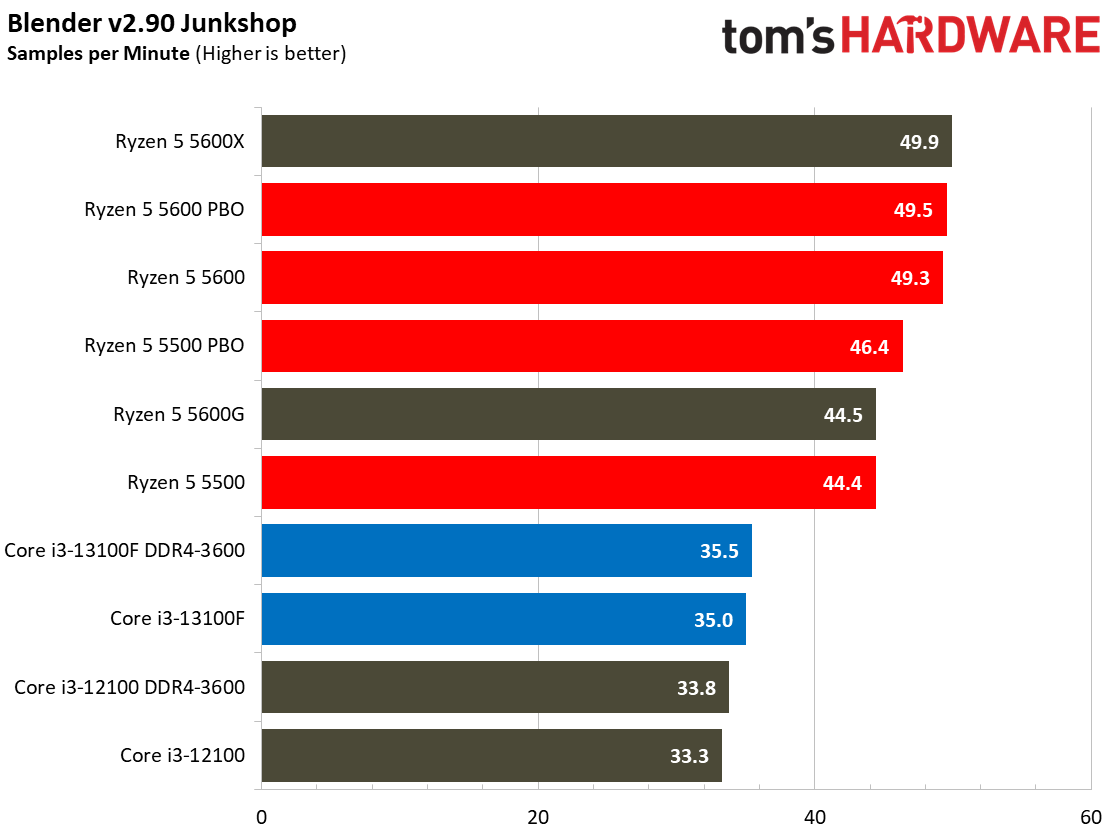
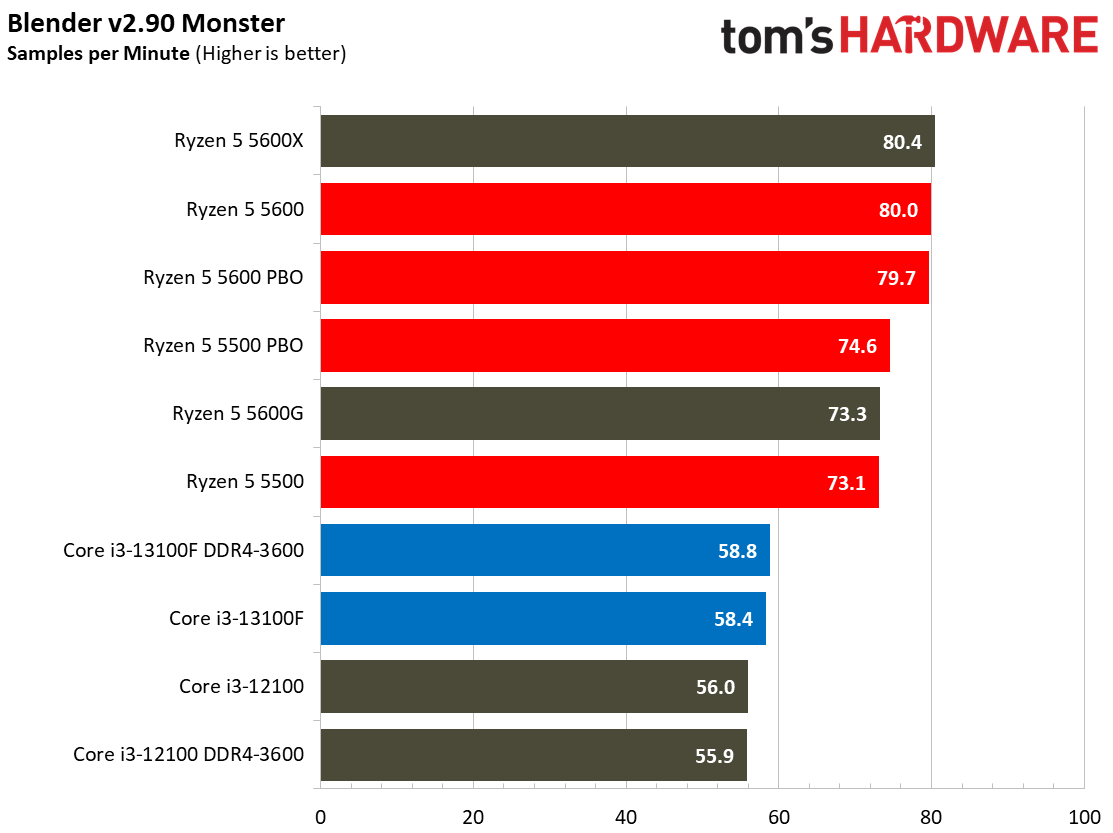
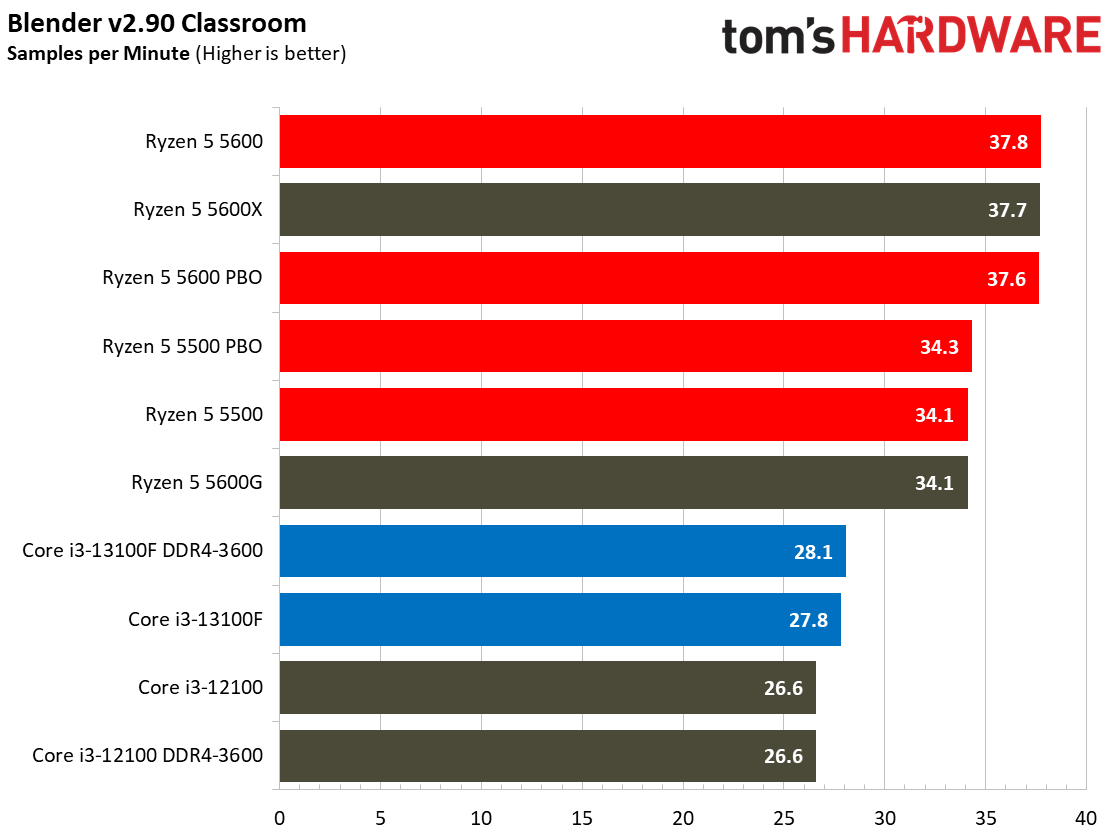
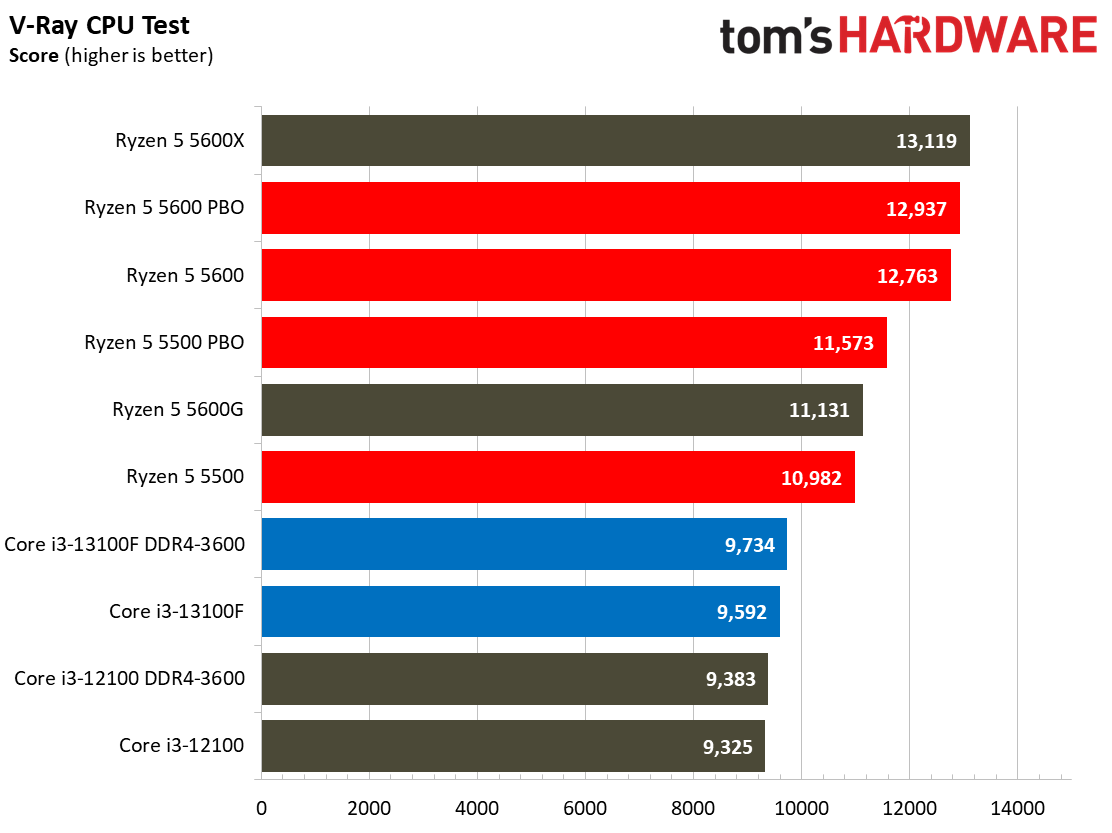
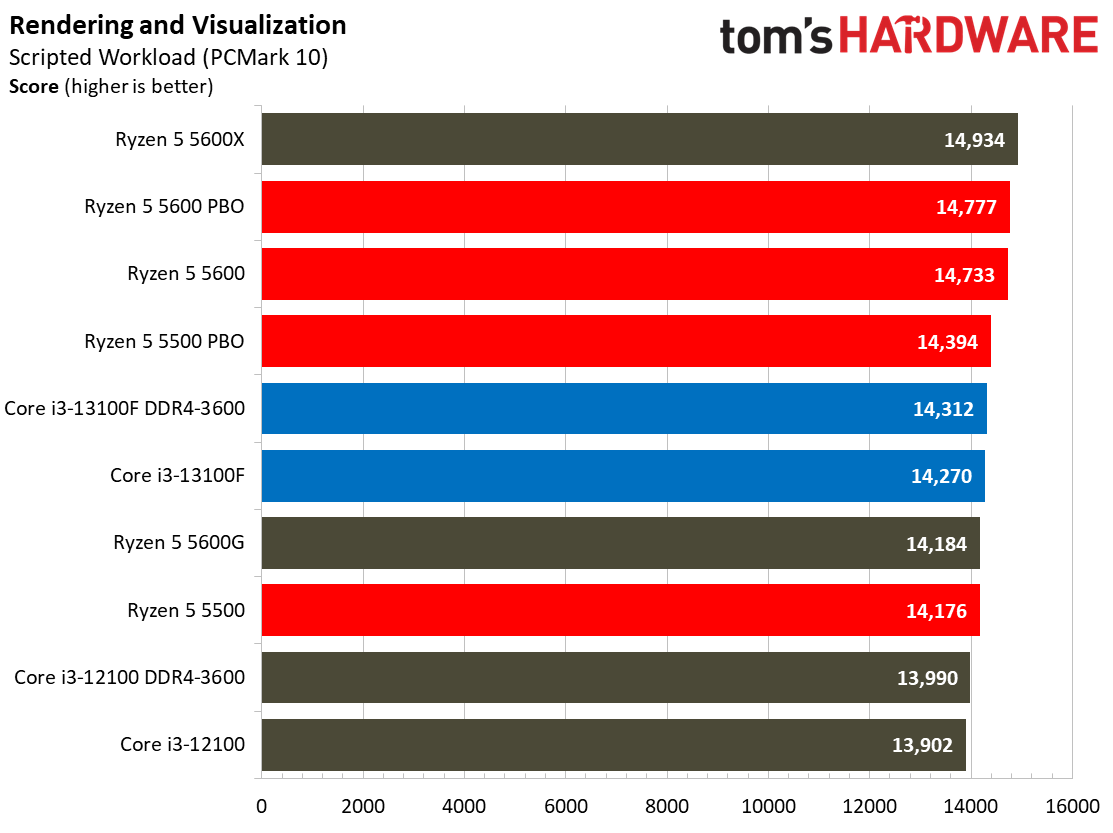
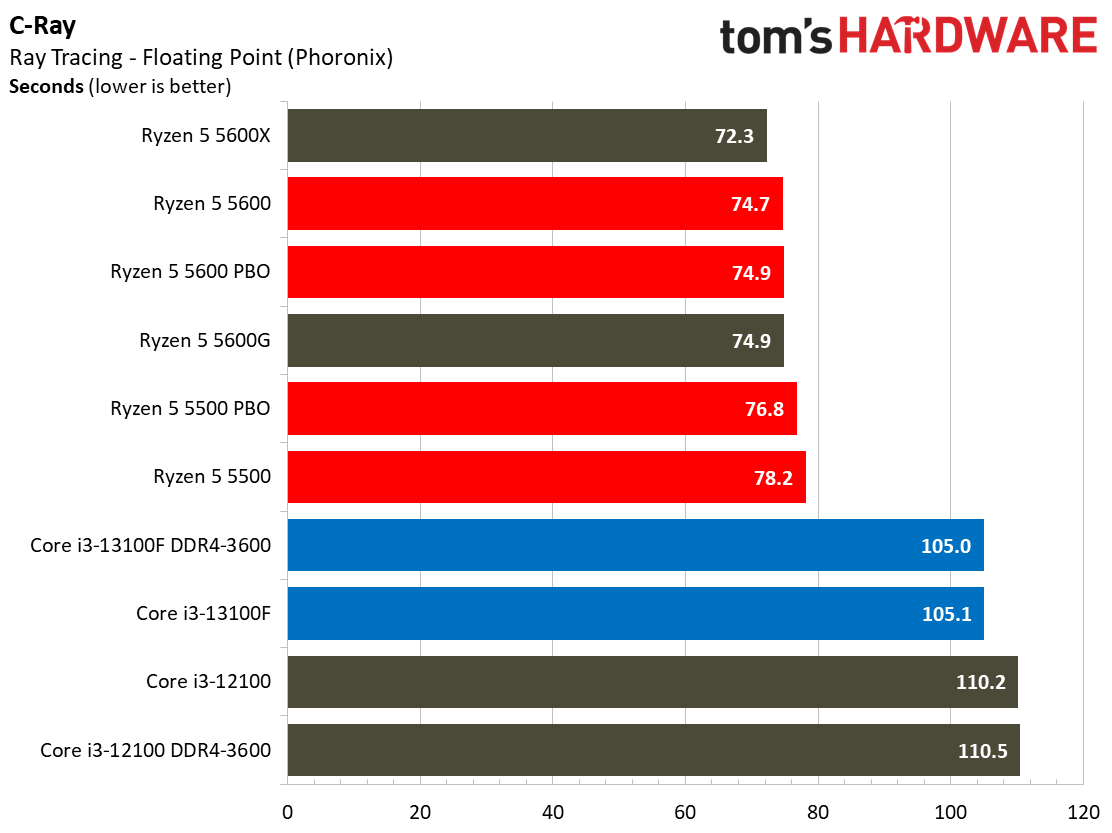
Here we have a quad-core attempting to fend off two six-core 12-thread chips in heavily threaded rendering applications. As you would expect, that doesn't go too well, with the Ryzen 5 5600 and 5500 both taking substantial leads in all manner of threaded workloads. The Core i3-13100/F does carve out a few wins in the single-threaded rendering tasks.
Encoding Benchmarks on Intel Core i3-13100F
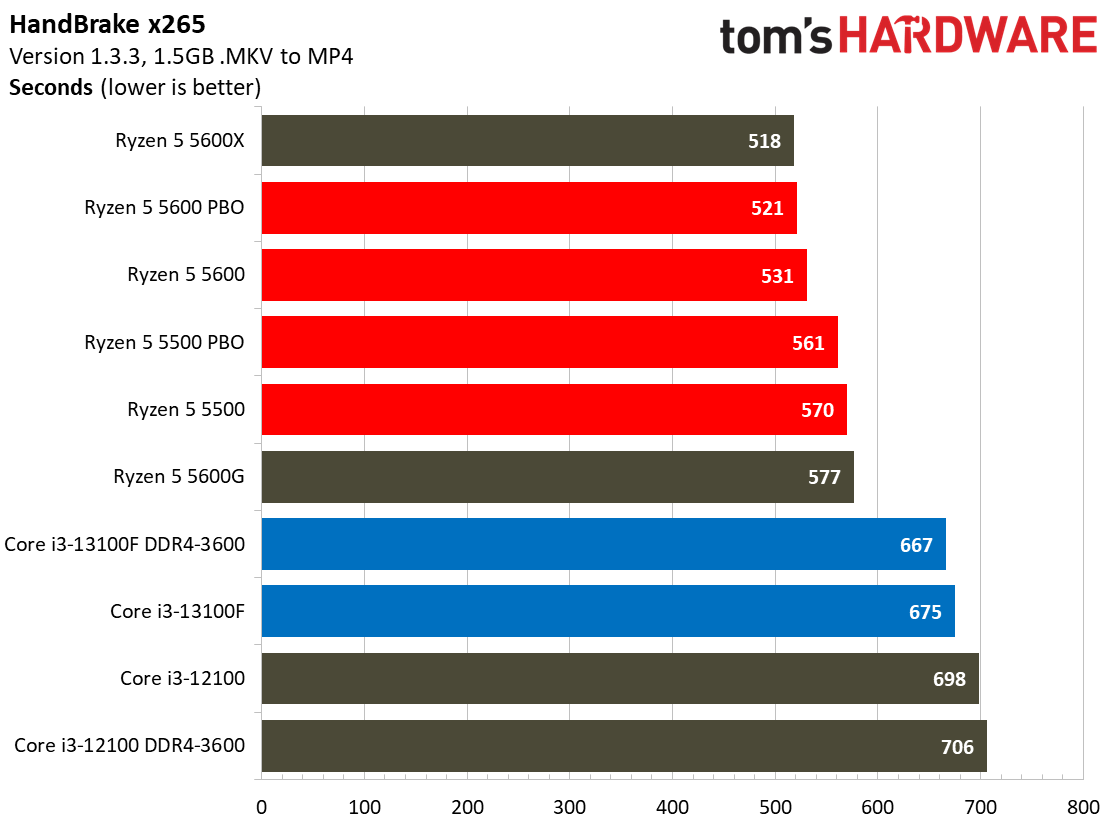
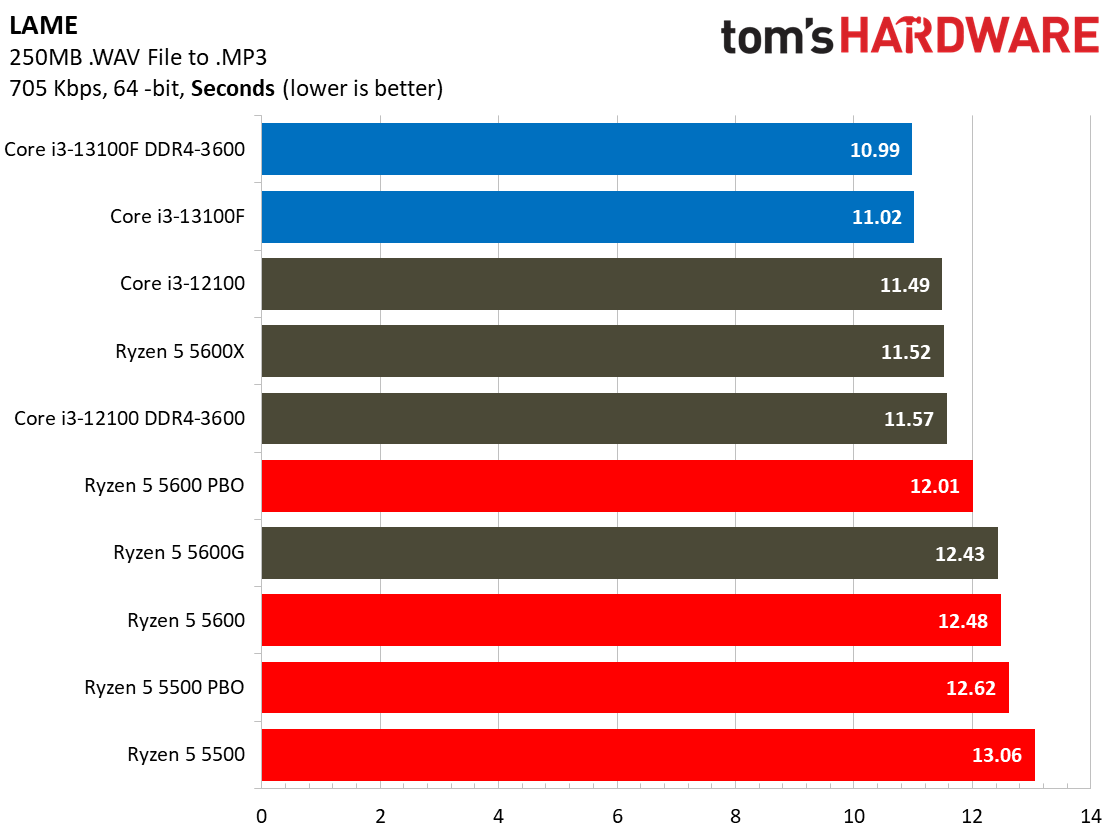
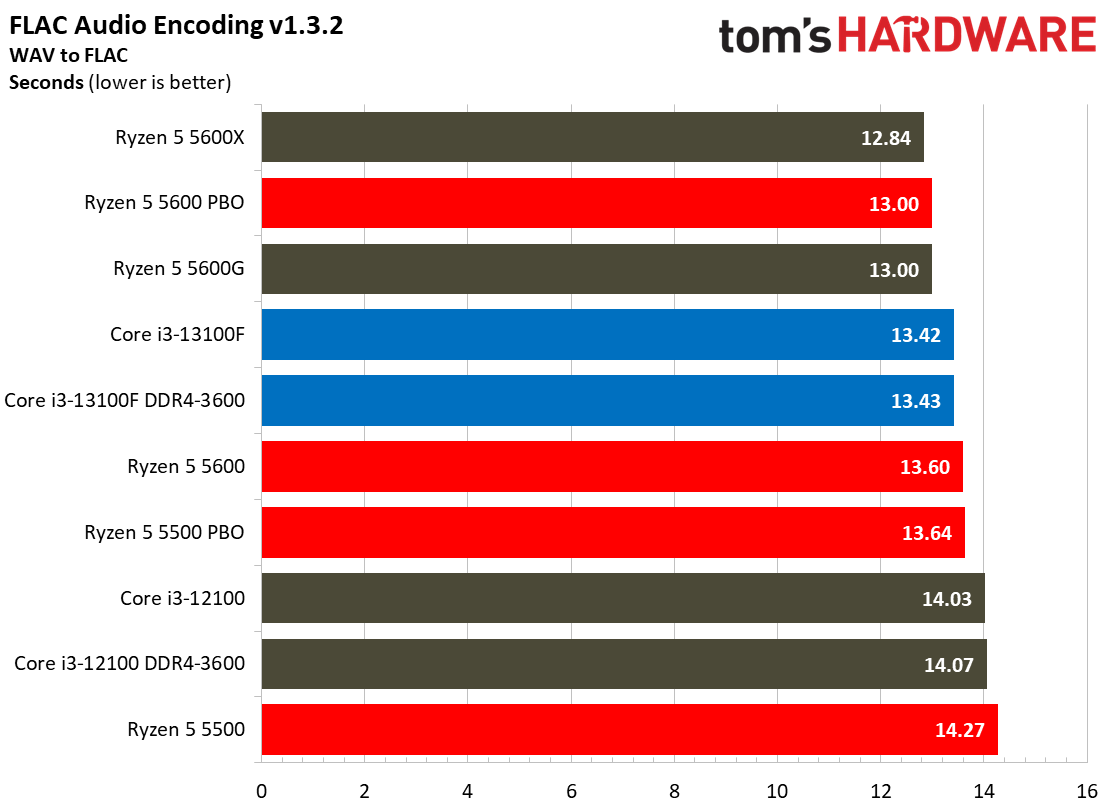
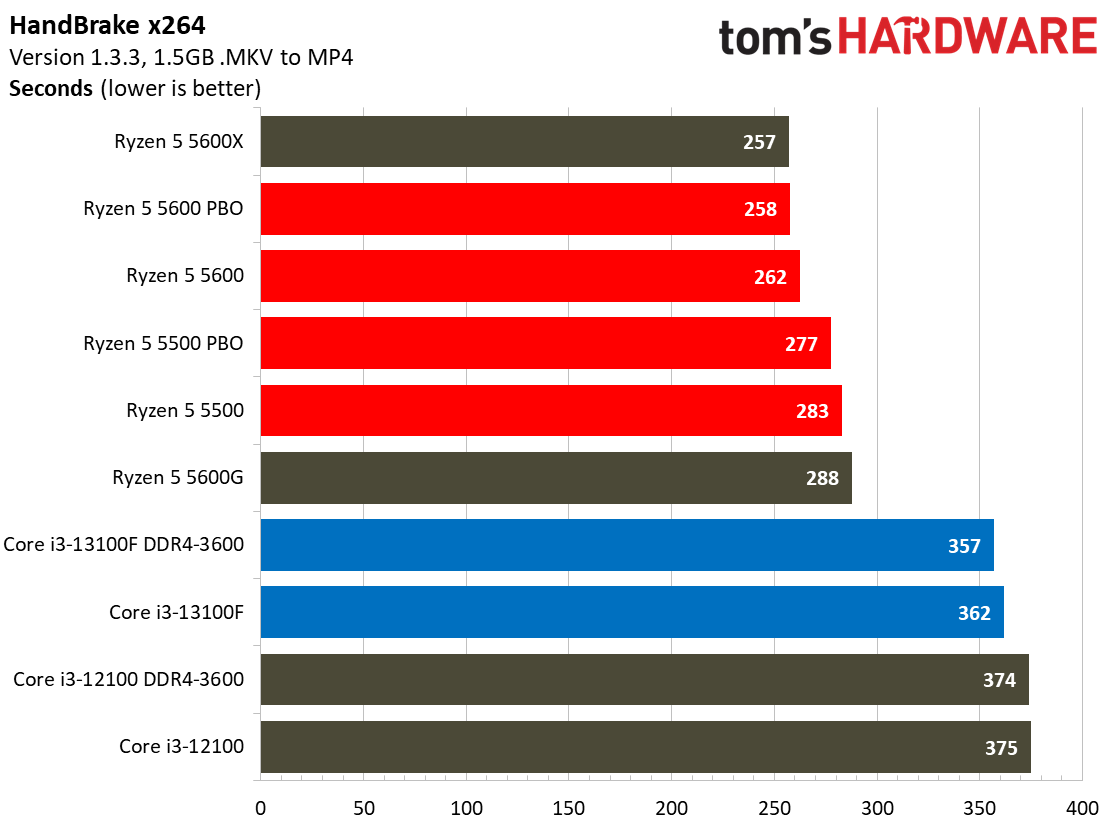
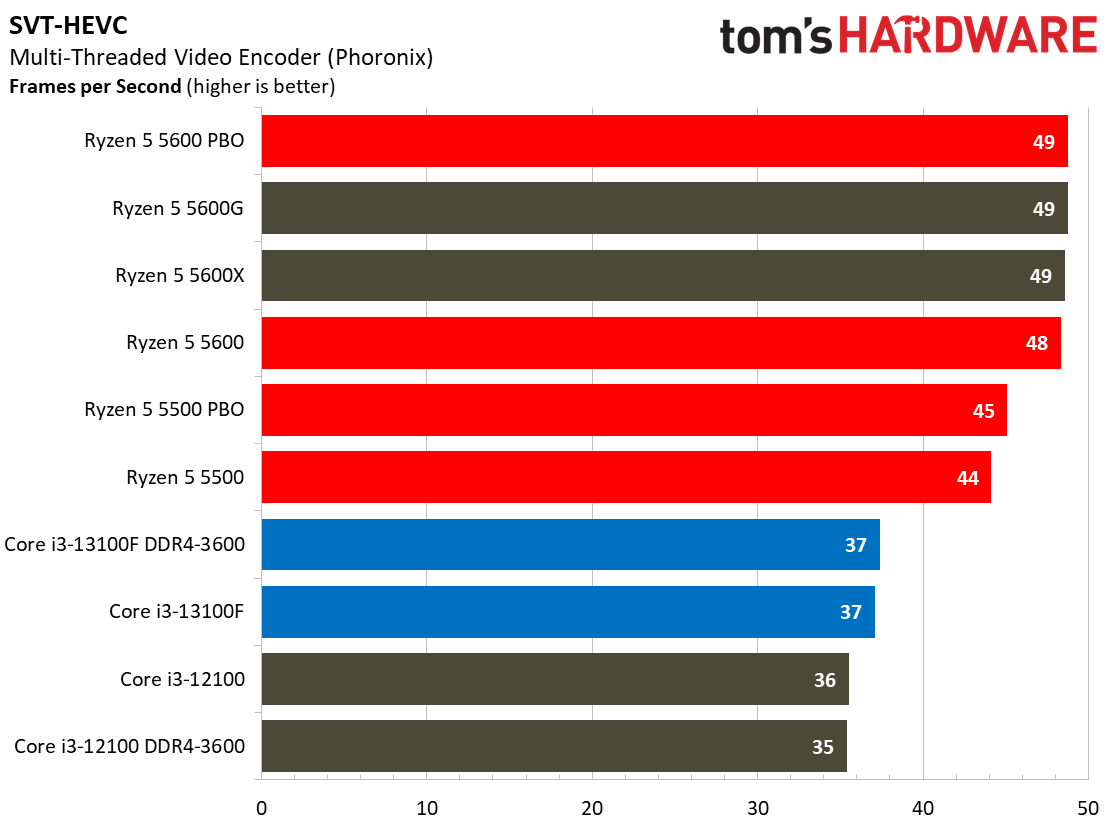
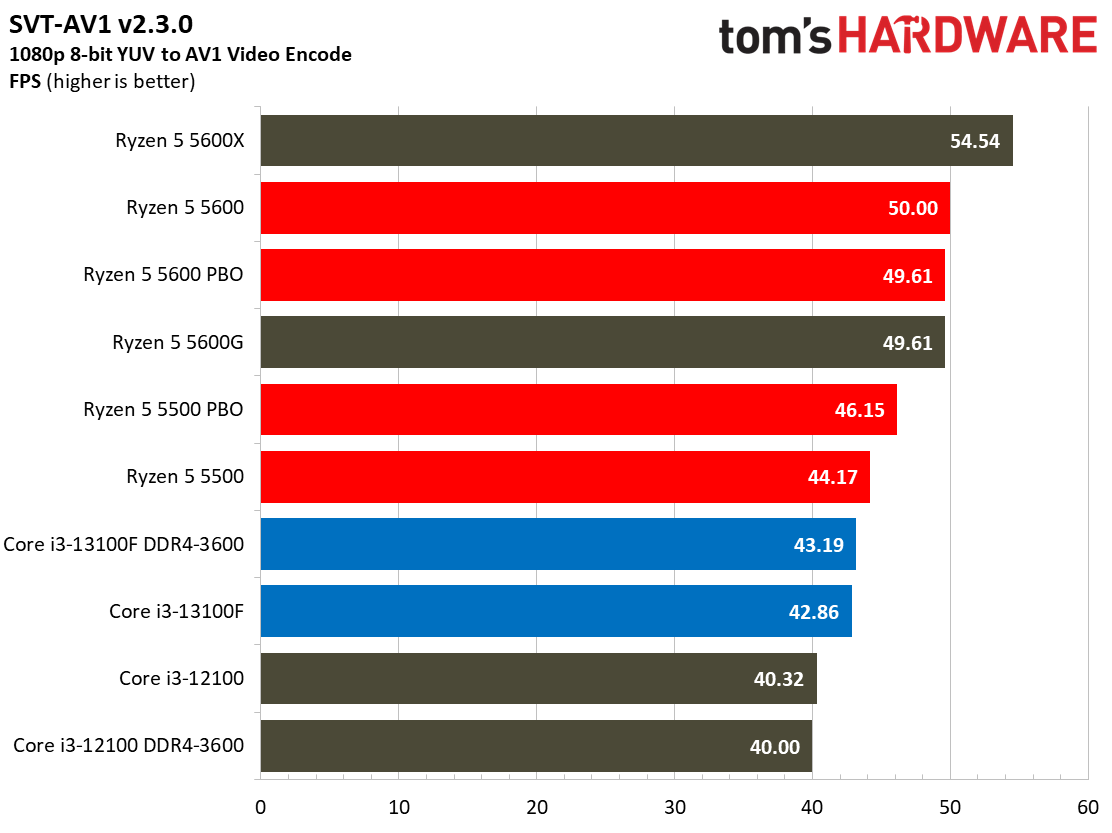
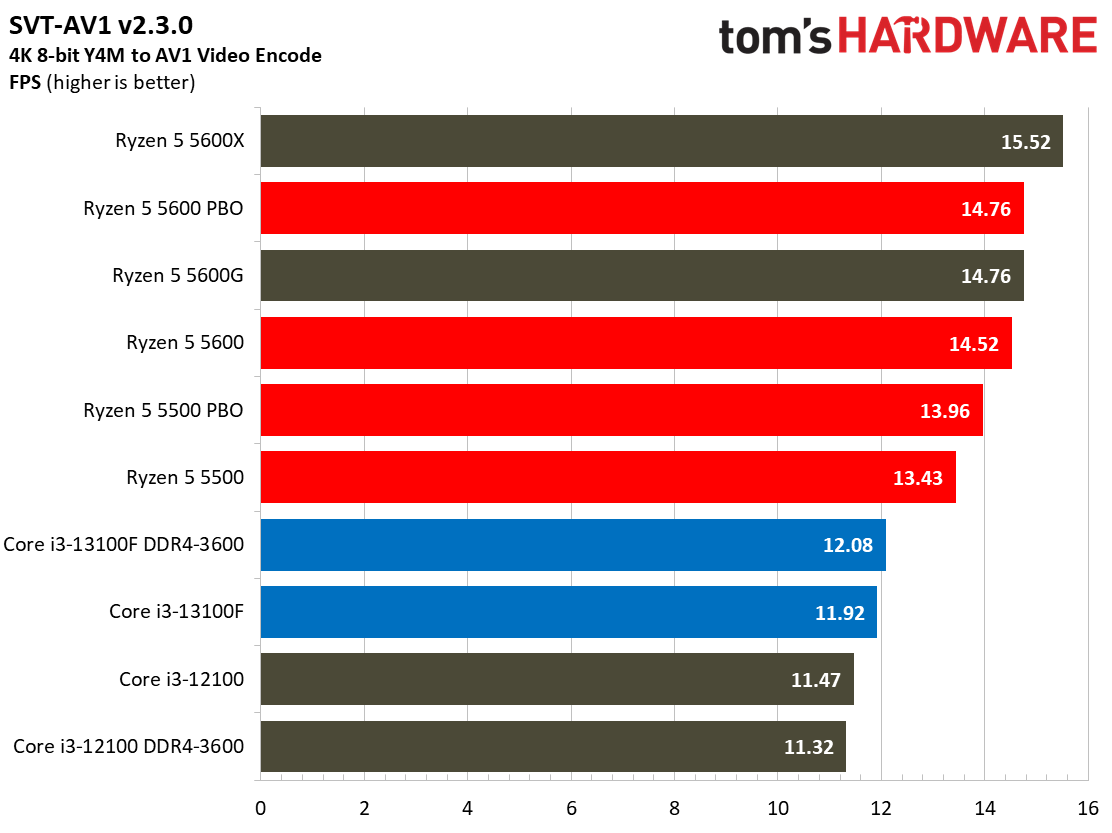
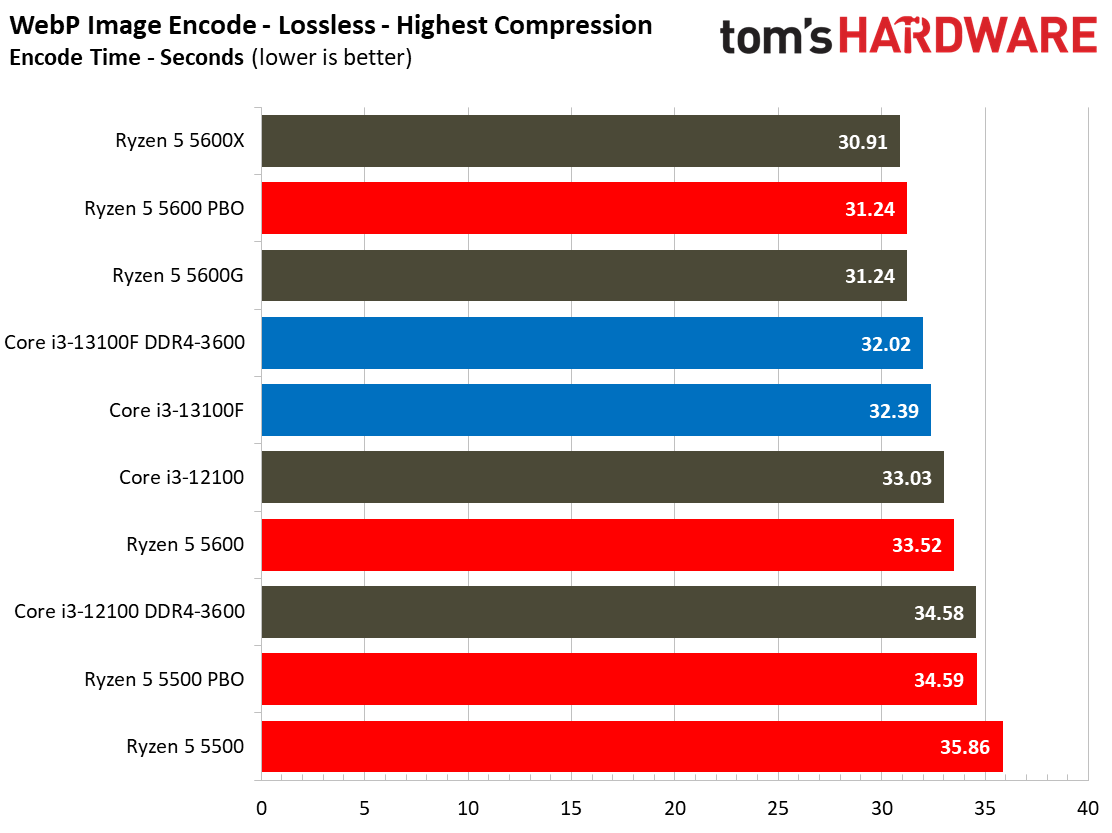
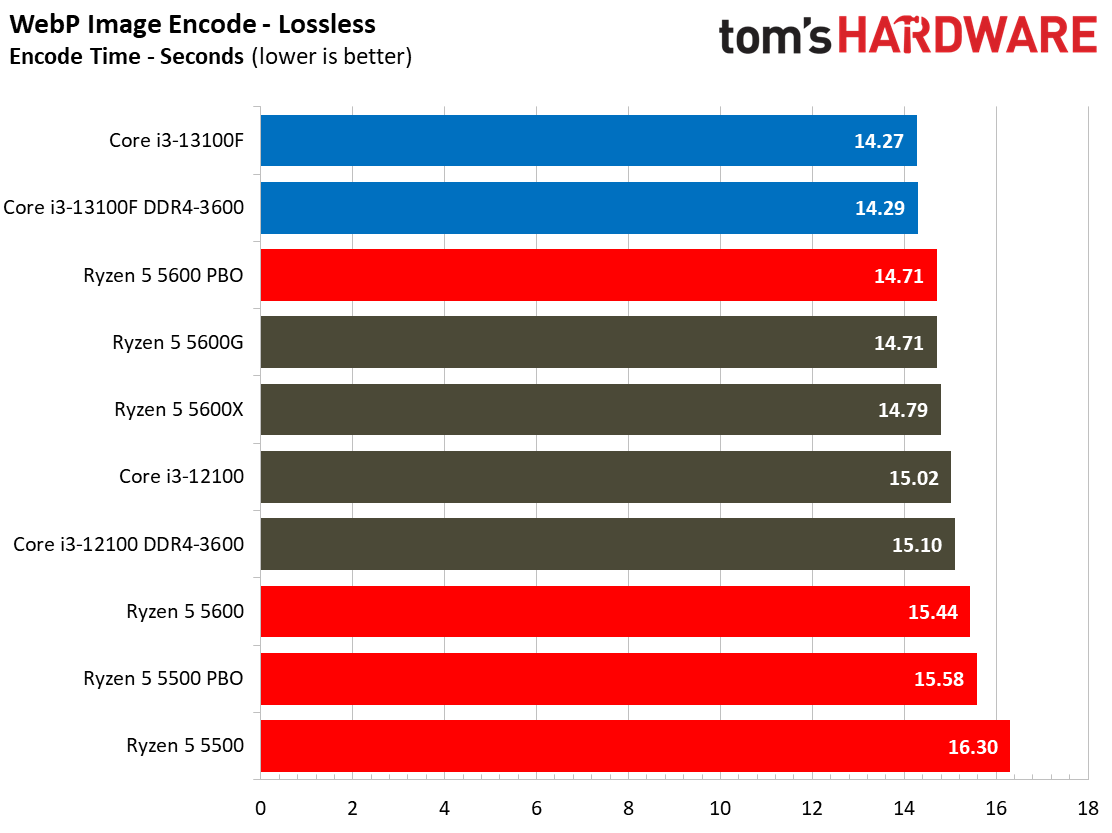
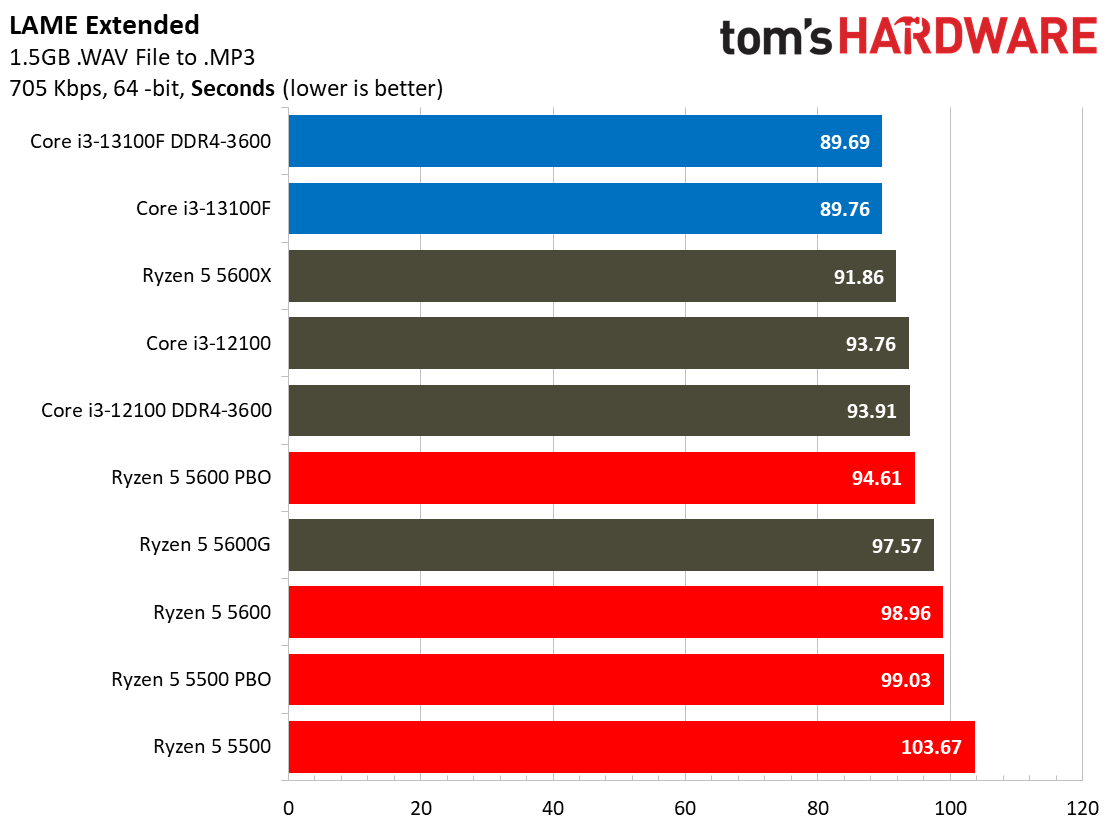
Most encoders tend to be either heavily threaded or almost exclusively single-threaded — it takes an agile chip to master both disciplines. Handbrake, SVT-HEVC, and SVT-AV1 serve as our threaded encoders, while LAME, FLAC, and WebP are indicative of how the chips handle lightly-threaded engines.
Adobe, Web Browsing, Office, and Productivity on Intel Core i3-13100F
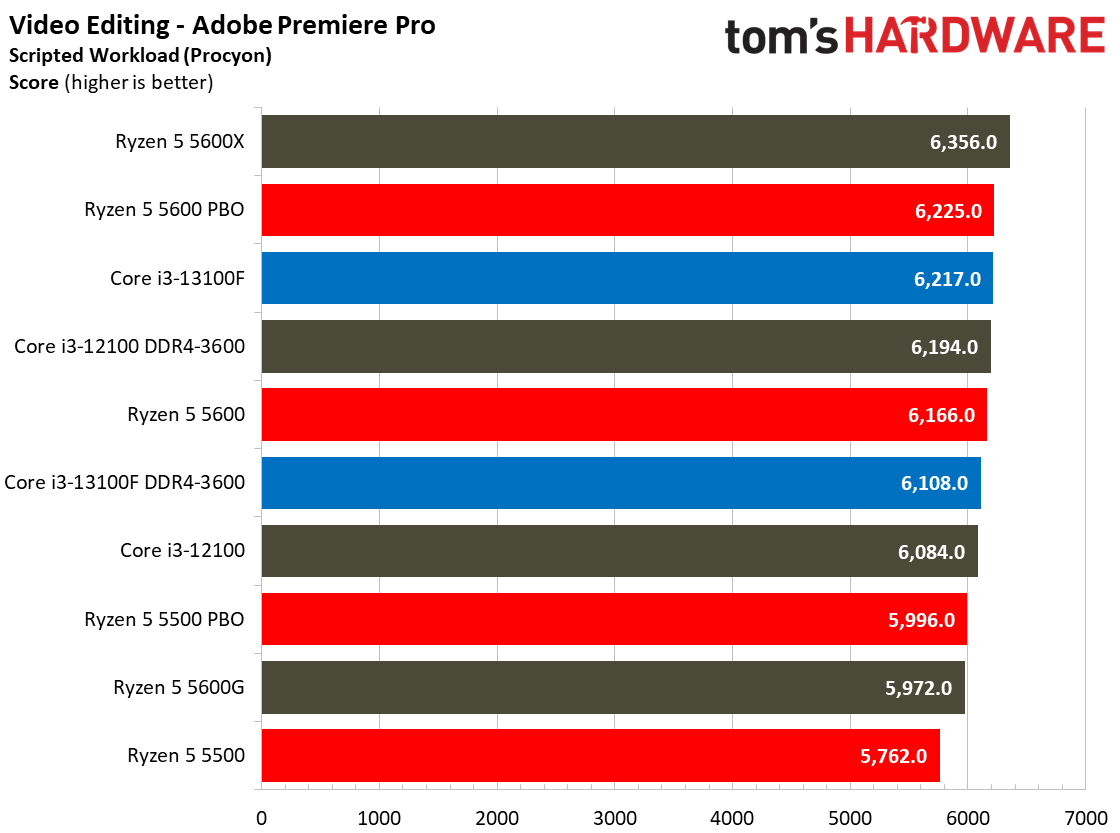
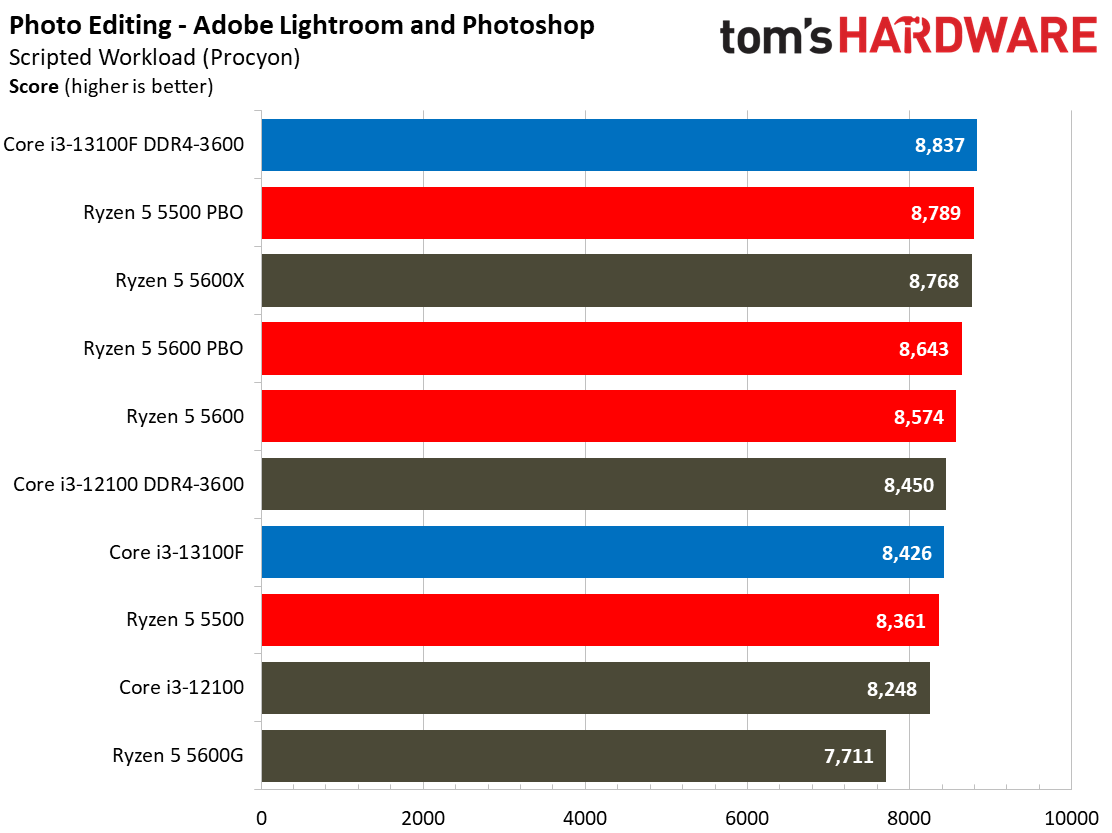
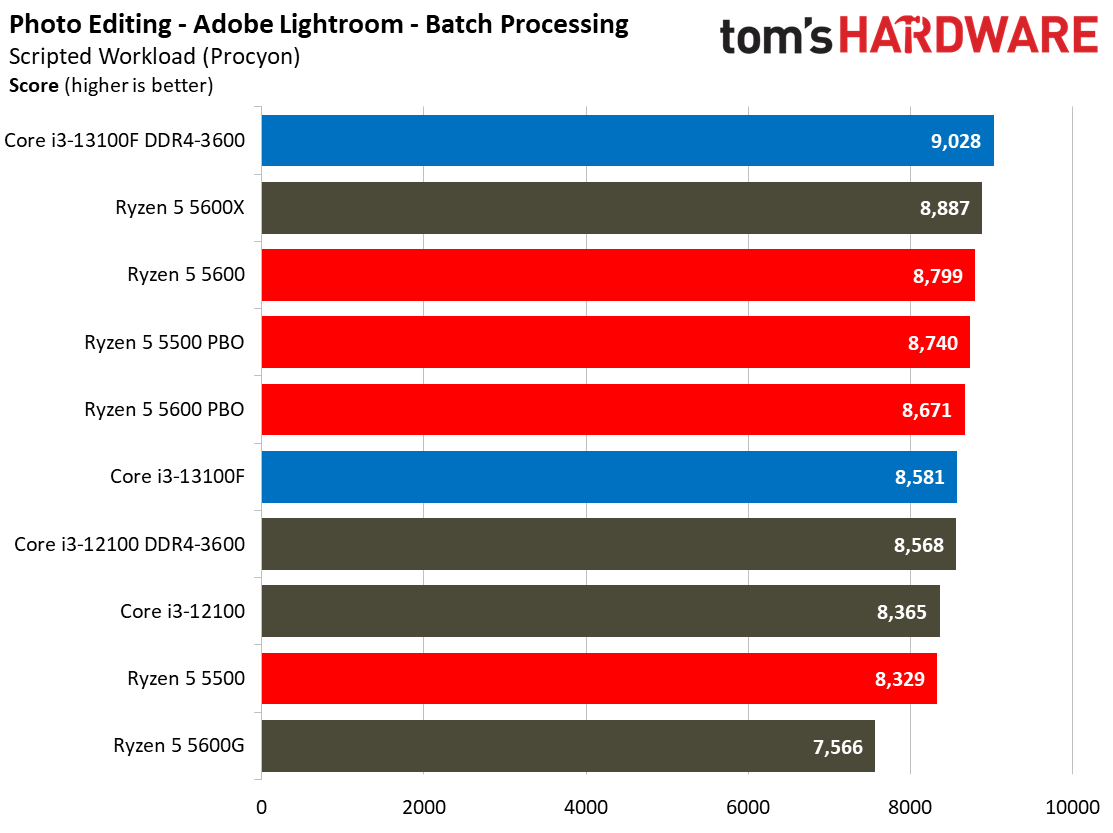
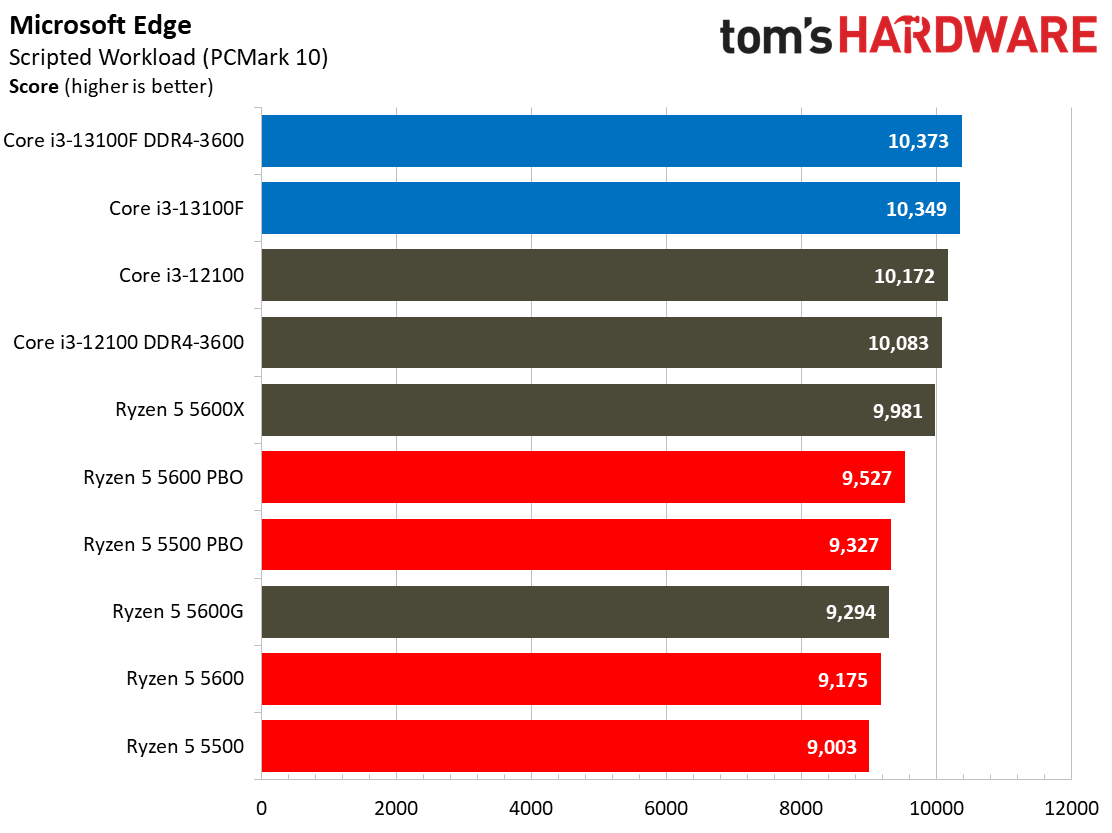
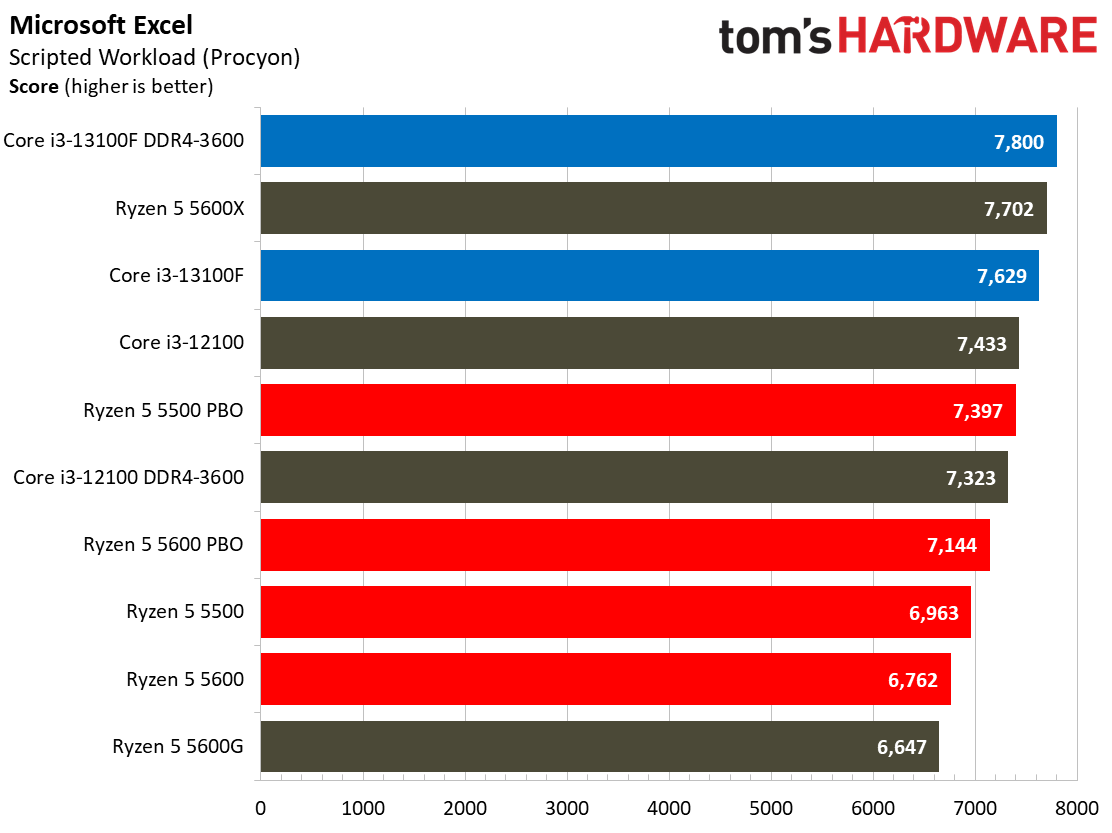
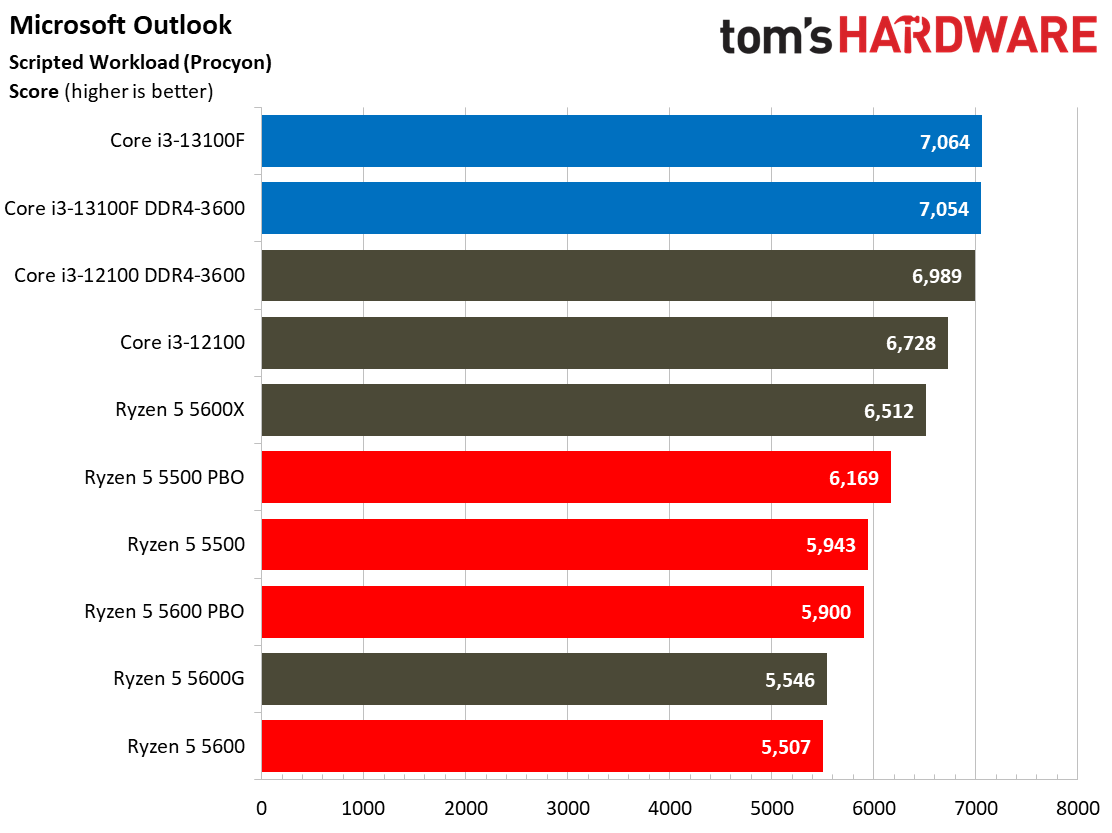
Compilation, Compression, AI Chess Engines, AVX-512 Performance on Intel Core i3-13100F
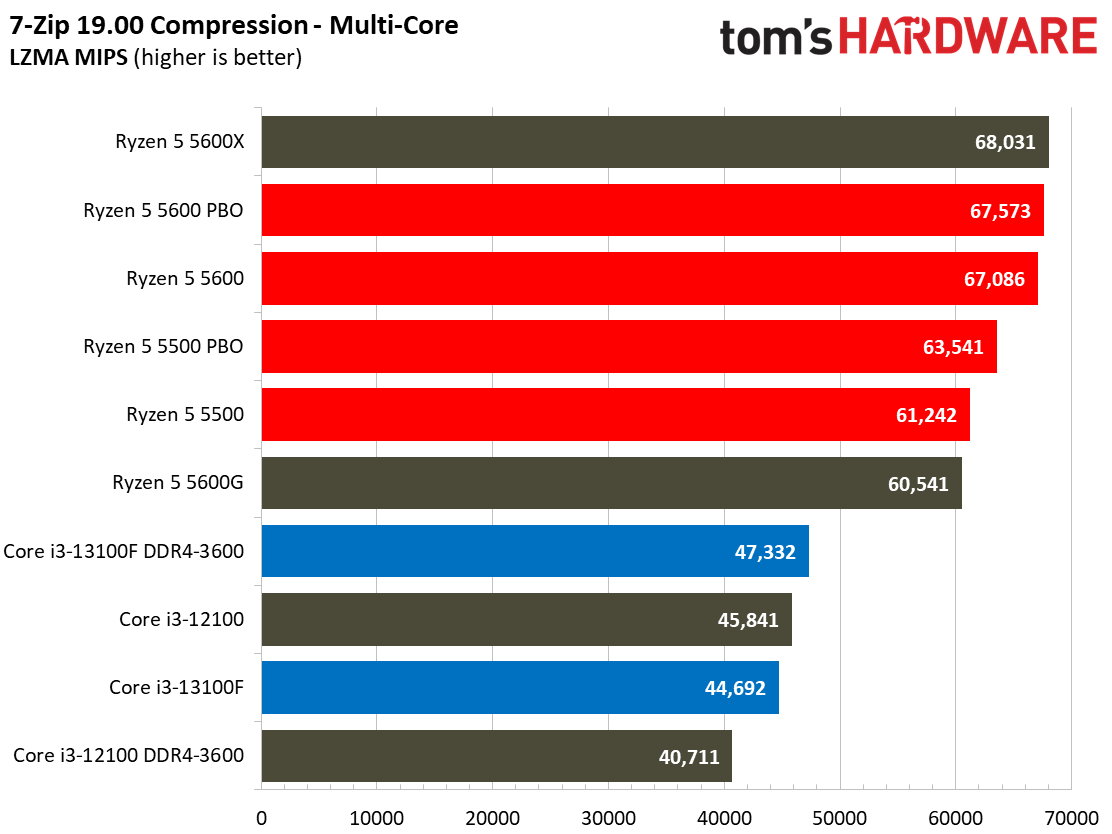
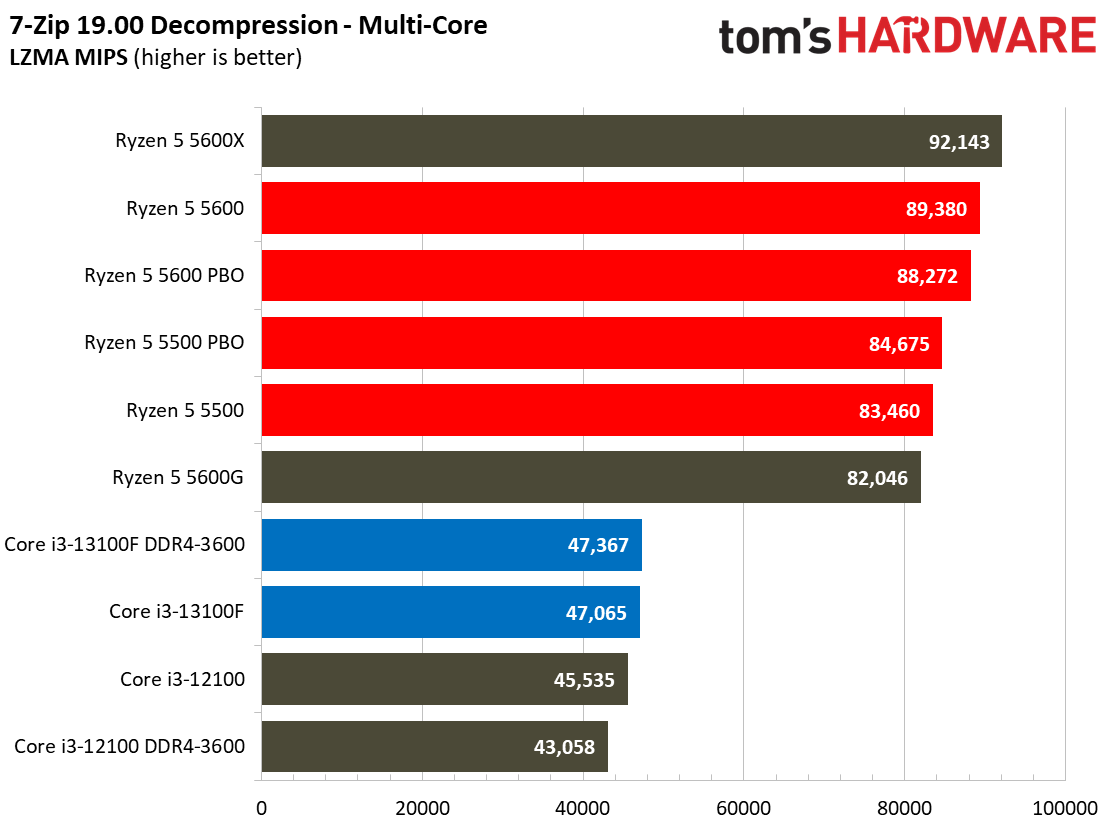
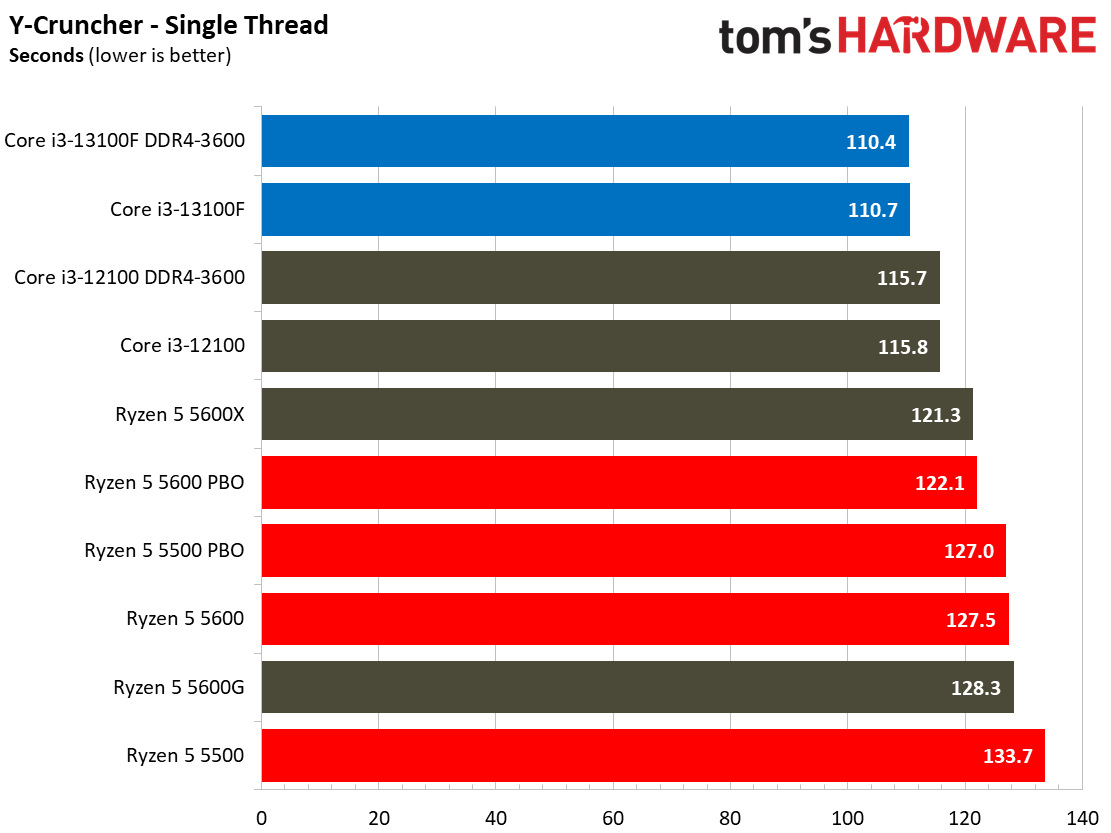
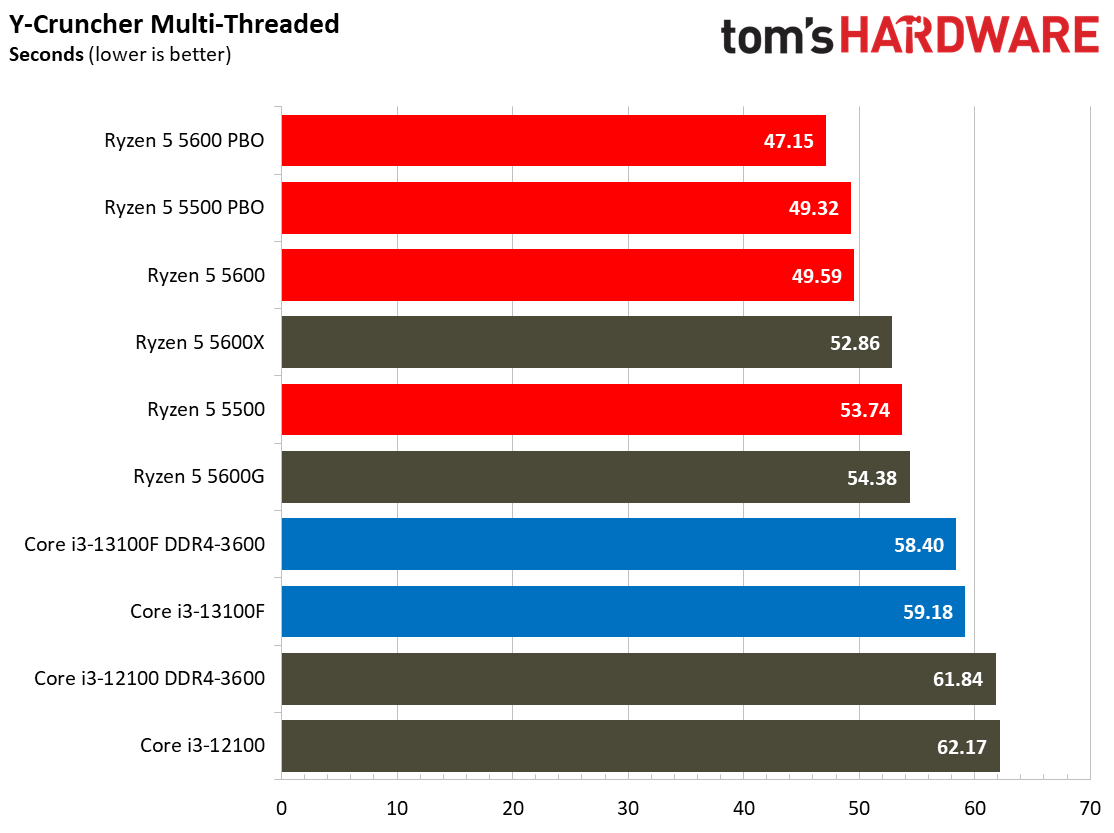
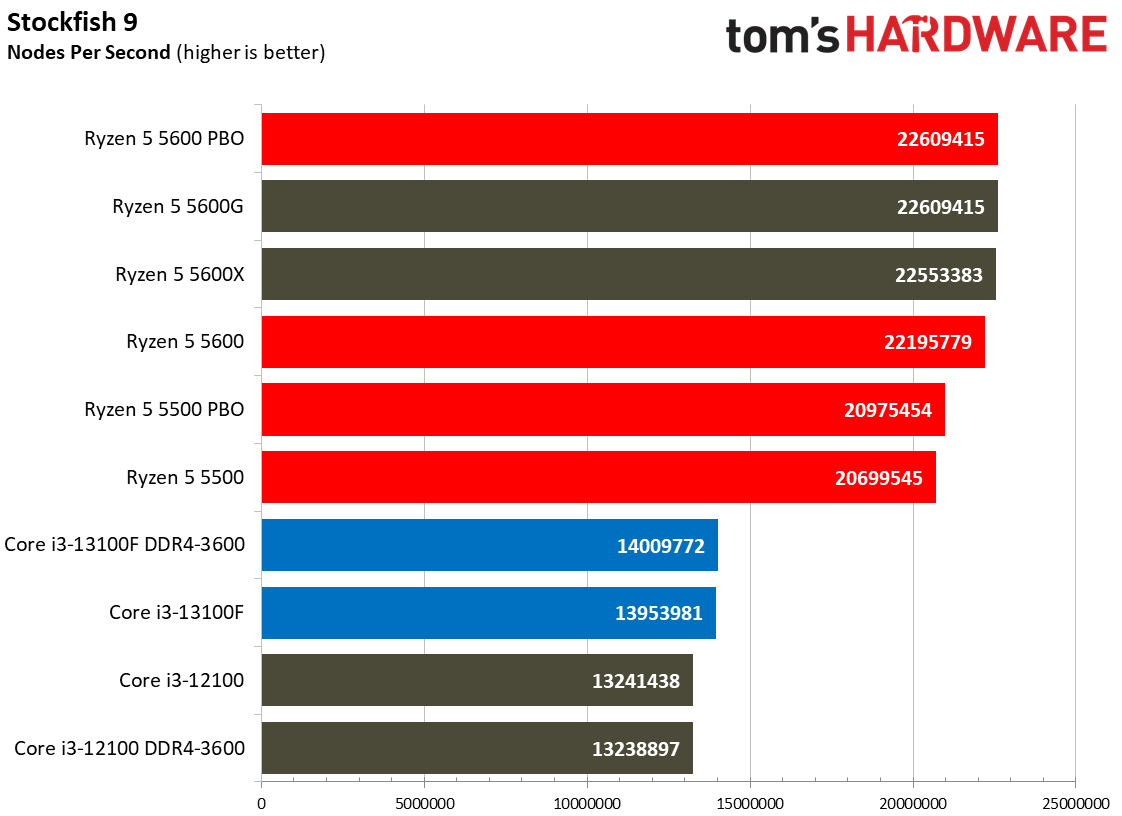
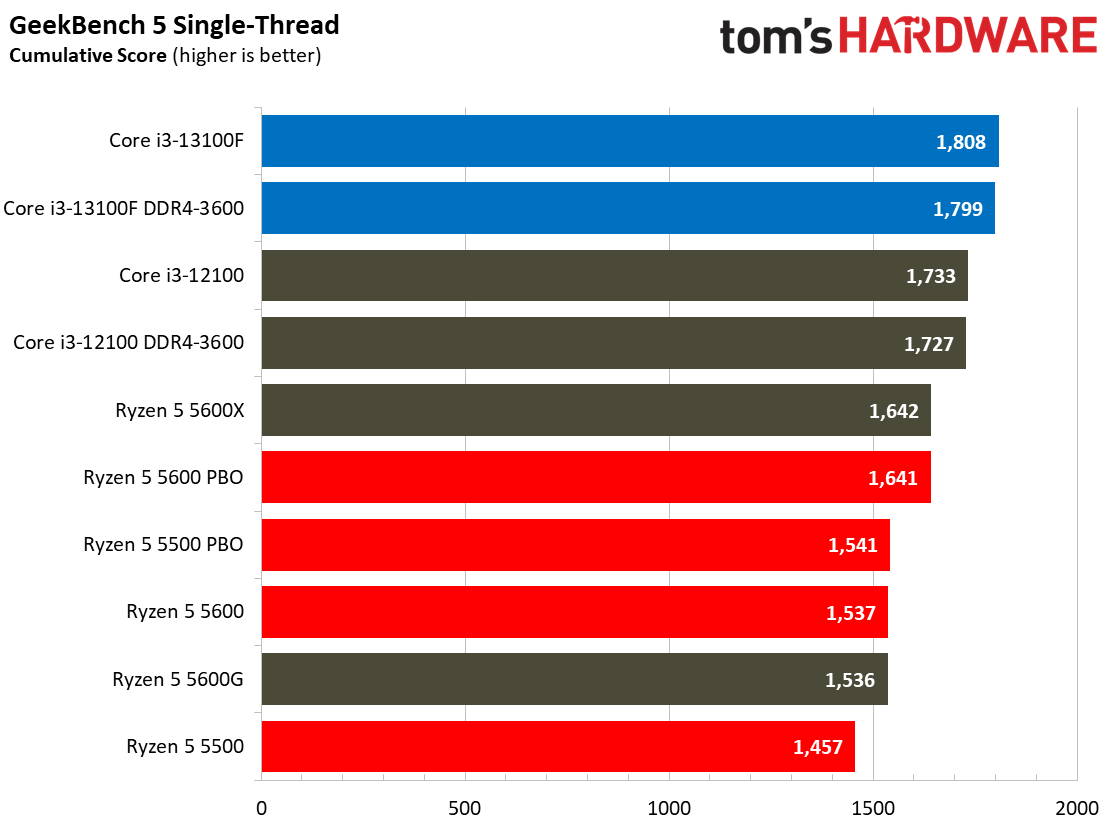
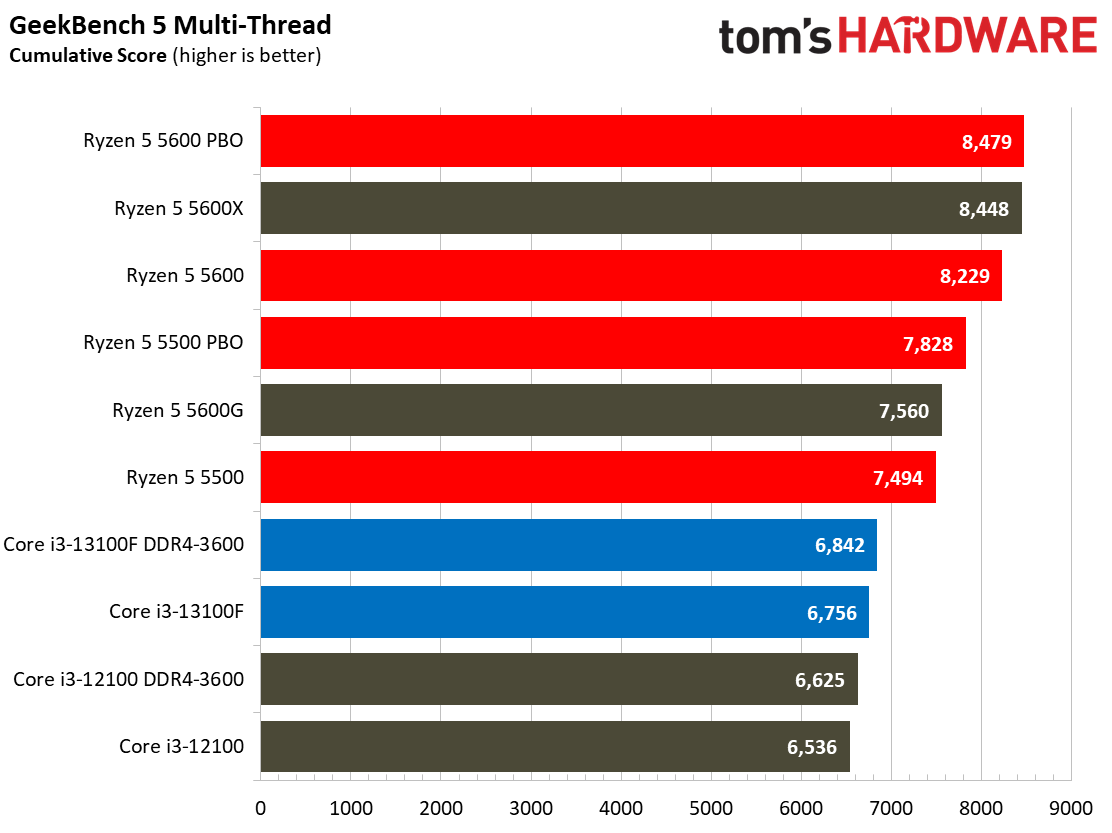
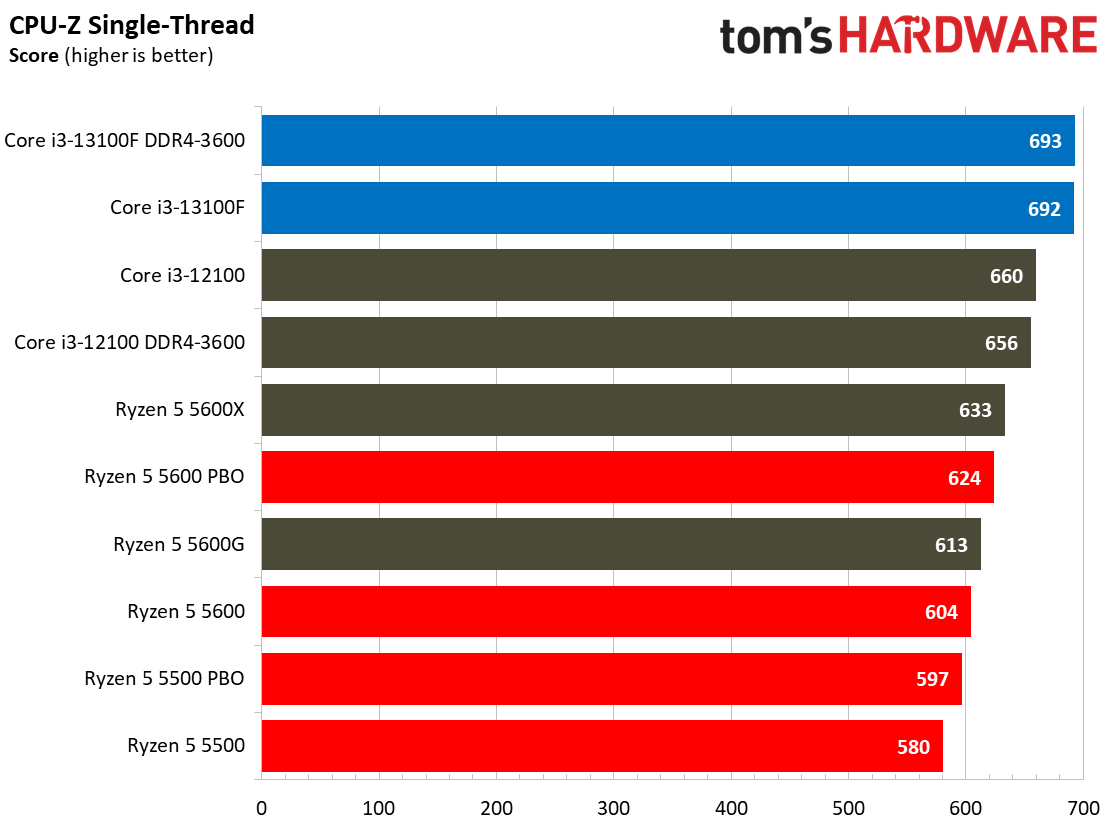
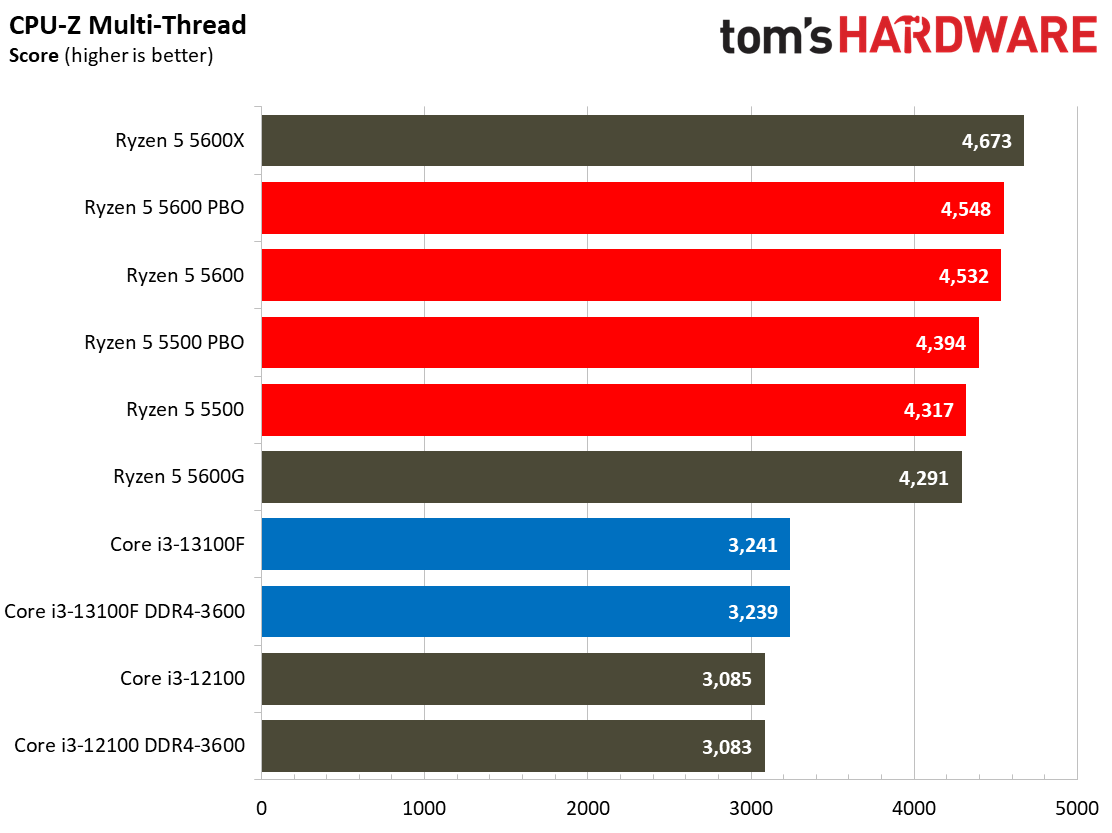
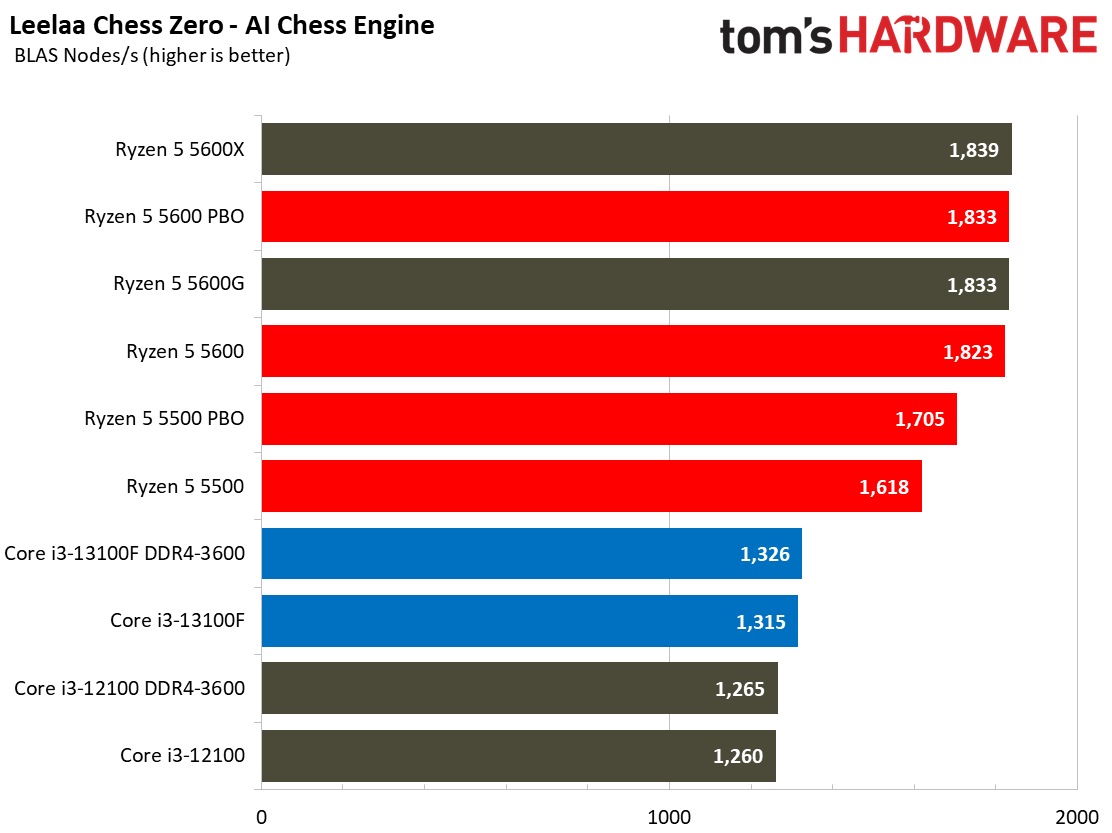
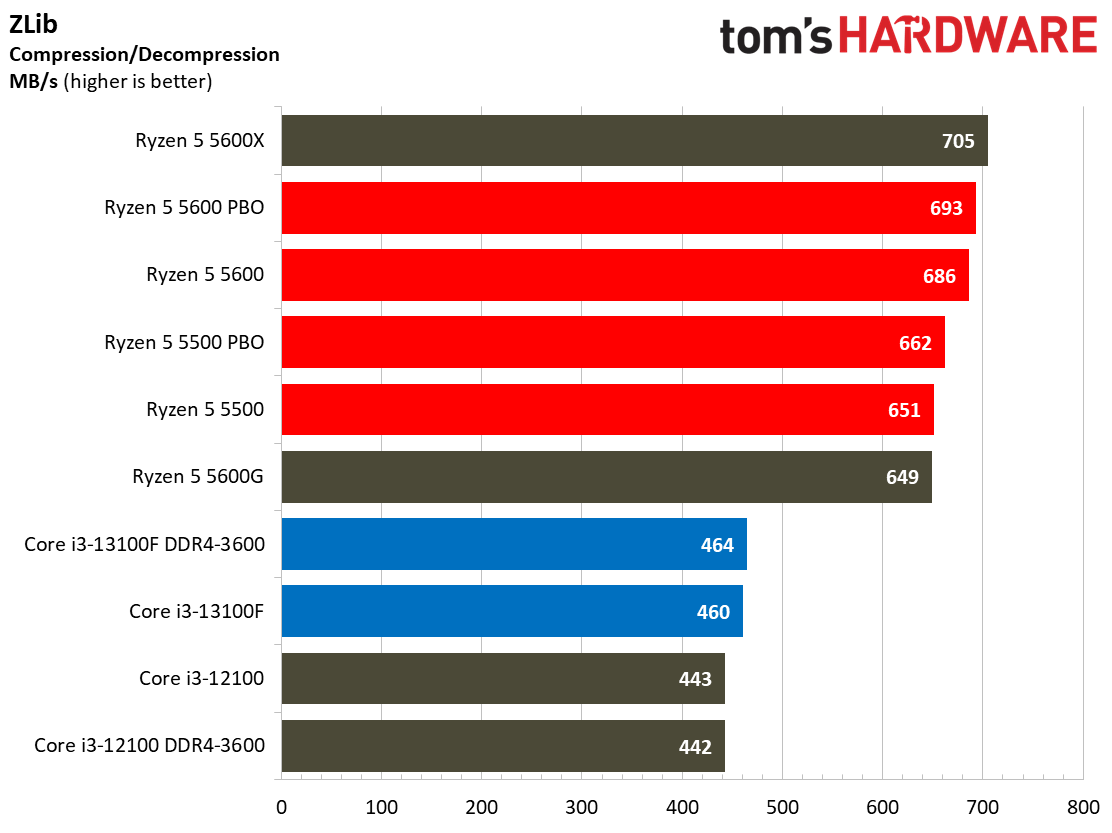
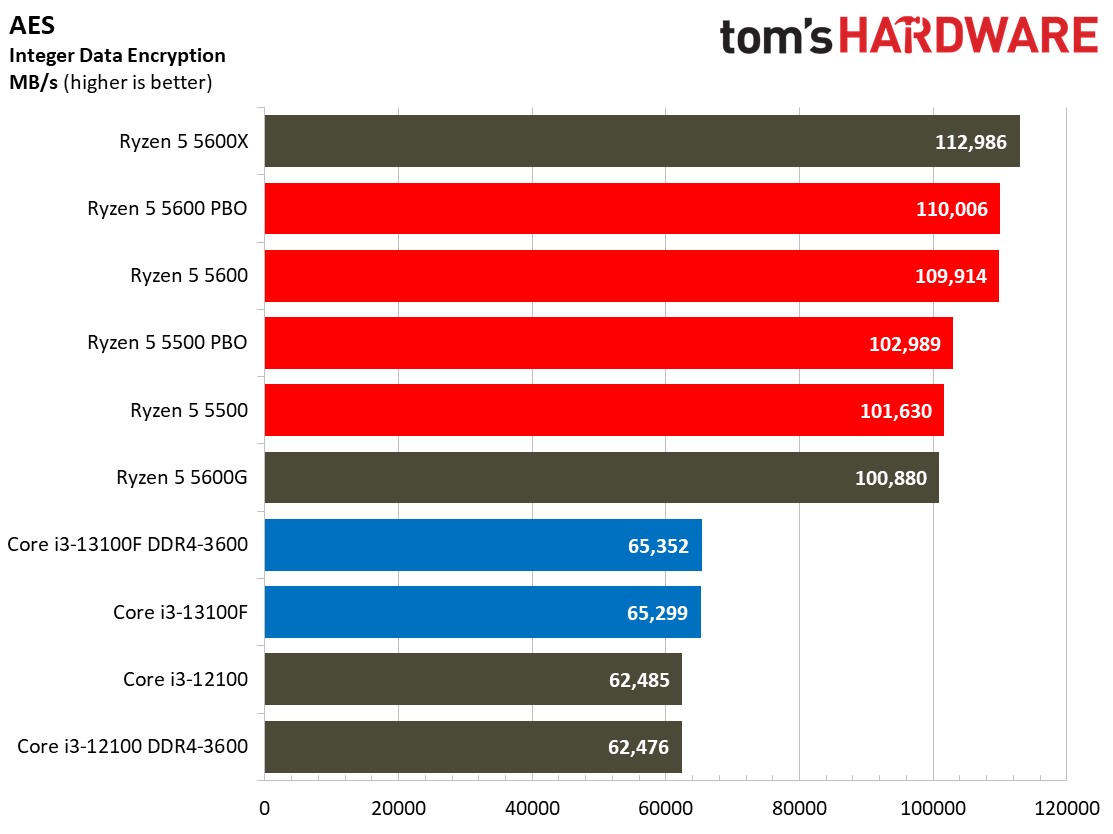
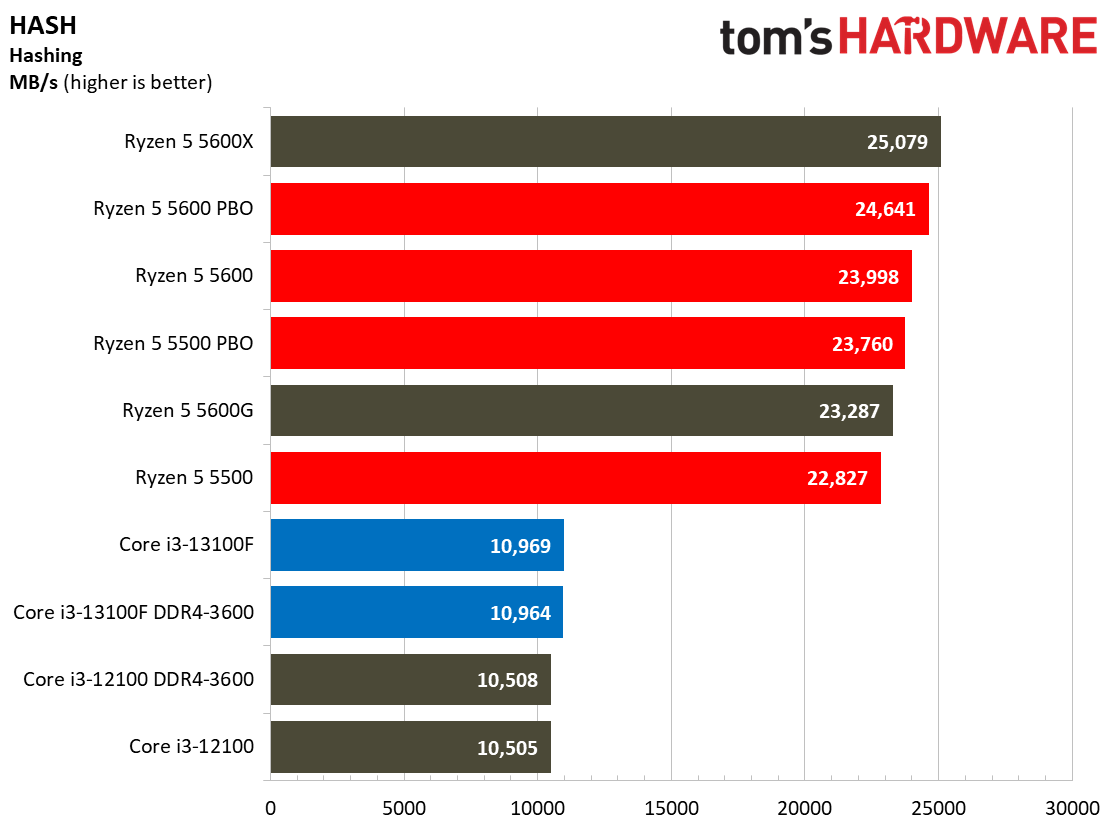
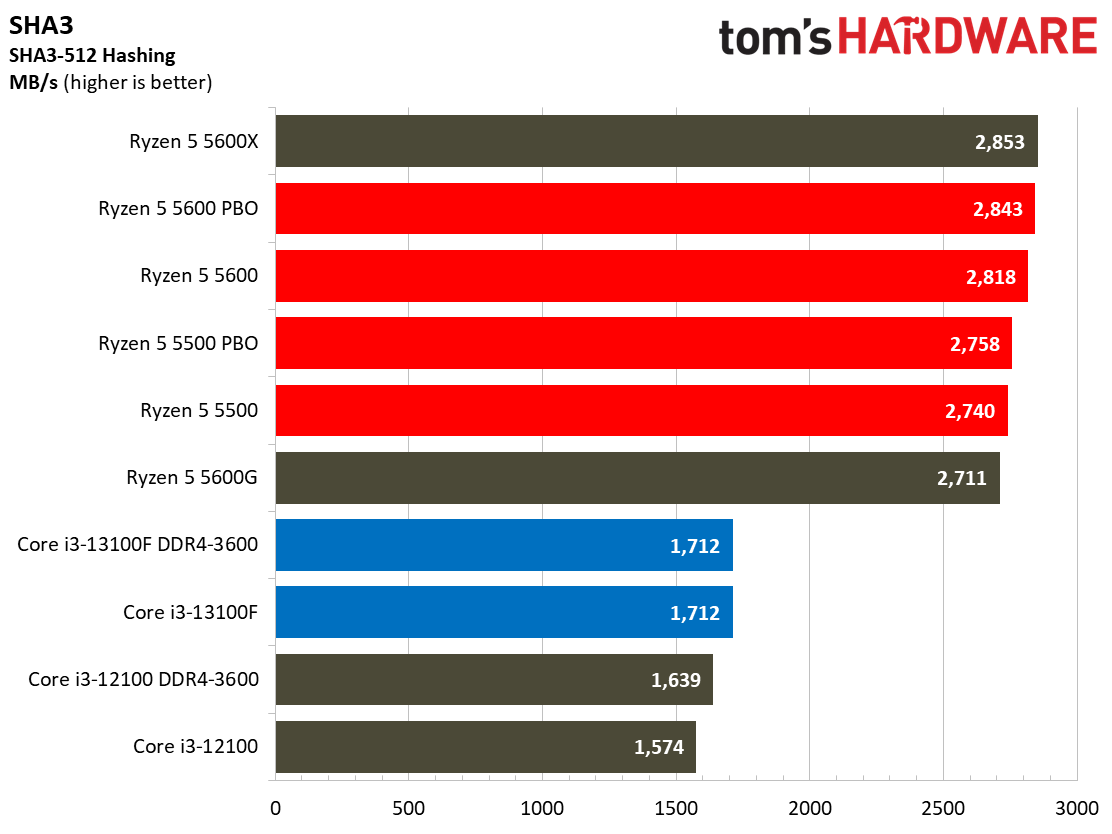
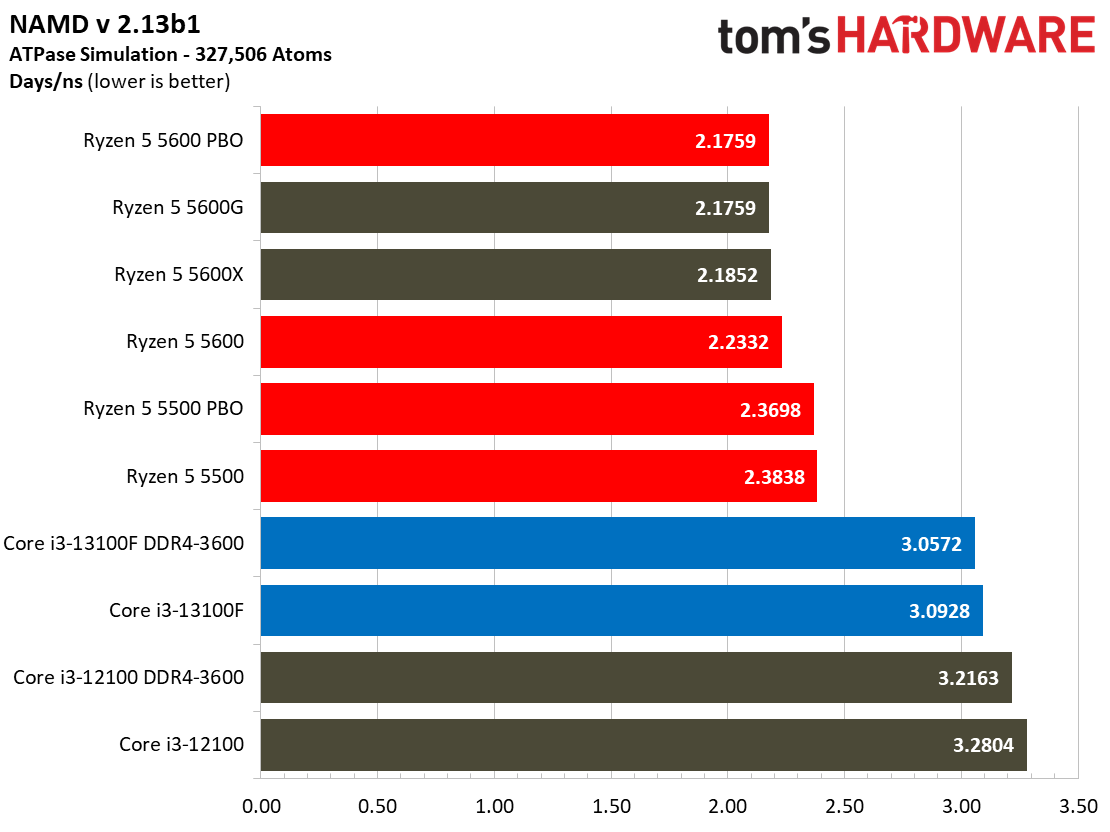
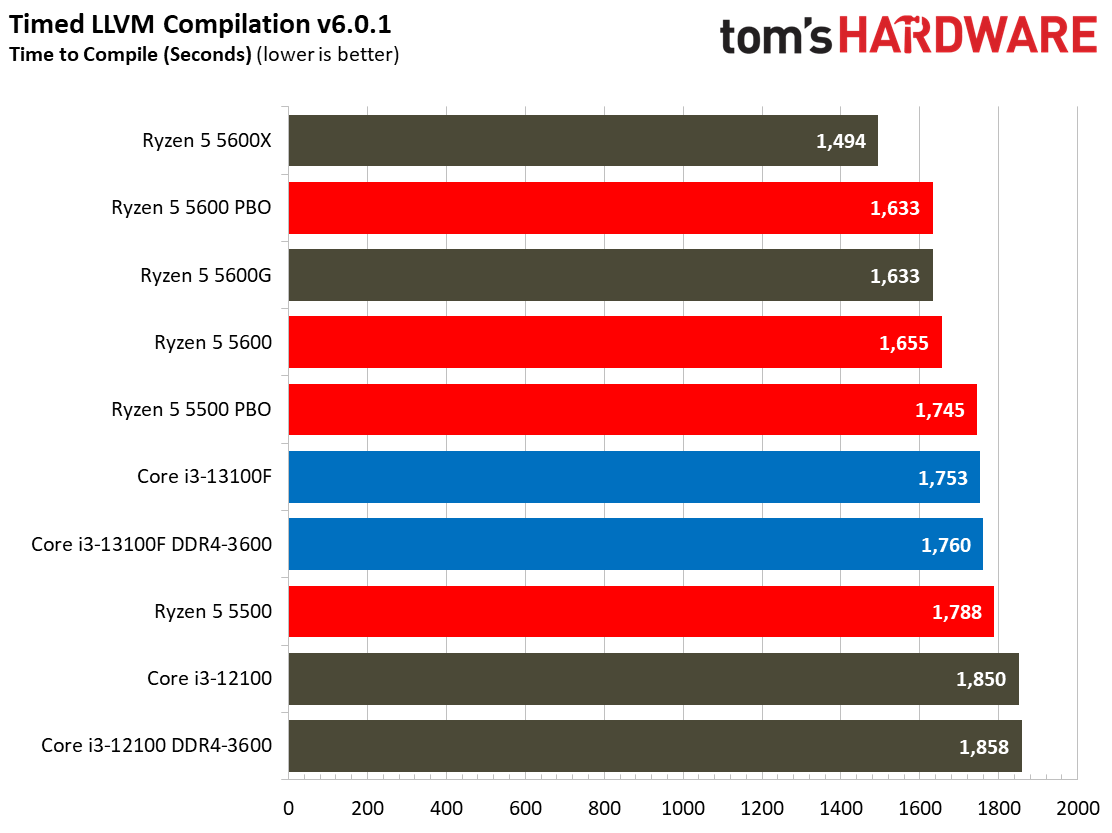
Aside from the compression/decompression tests, most of these benchmarks aren't as important for this class of processors, but we include them for the sake of completeness. As you can see, AMD easily wins the compression and decompression benchmarks due to both the advantage of having more cores and specific architectural optimizations that benefit this type of work.
The remainder of the benchmarks run the gamut from the exceedingly branchy code in the LLVM compilation workload to the massively parallel molecular dynamics simulation code in NAMD to encryption and compression/decompression performance. The demanding Y-cruncher benchmark computes Pi with the AVX instruction set and has optimizations for both Intel and AMD’s architectures.
The Core i3-13100/F pulls off a few wins in single-threaded tests, but the rest of the benchmarks are nearly entirely in AMD's favor.
- MORE: AMD Ryzen 7 7800X3D vs Intel Core i9-13900K vs Core i7-13700K
- MORE: Best CPU for gaming
- MORE: CPU Benchmark Hierarchy
- MORE: Intel vs AMD
- MORE: How to Overclock a CPU
The Core i3-13100F and Core i3-13100 come to market using the same winning formula that propelled the previous-gen Core i3-12100 to the top of our recommendations for budget systems, but AMD's Ryzen 5 5600 has seen substantial price reductions that change the ~$130 to $150 landscape entirely. Additionally, despite its higher price tag, the 13100's slim improvements in clock speeds mean it only delivers small gains over its predecessor.
Below, we have the geometric mean of our gaming test suite at 1080p and 1440p and a cumulative measure of performance in single- and multi-threaded applications. We conducted our gaming tests with an Nvidia RTX 4090, so performance deltas will shrink with lesser cards and higher resolution and fidelity settings. This is especially important to keep in mind with these lower-end processors as they will be paired with lower-end GPUs.






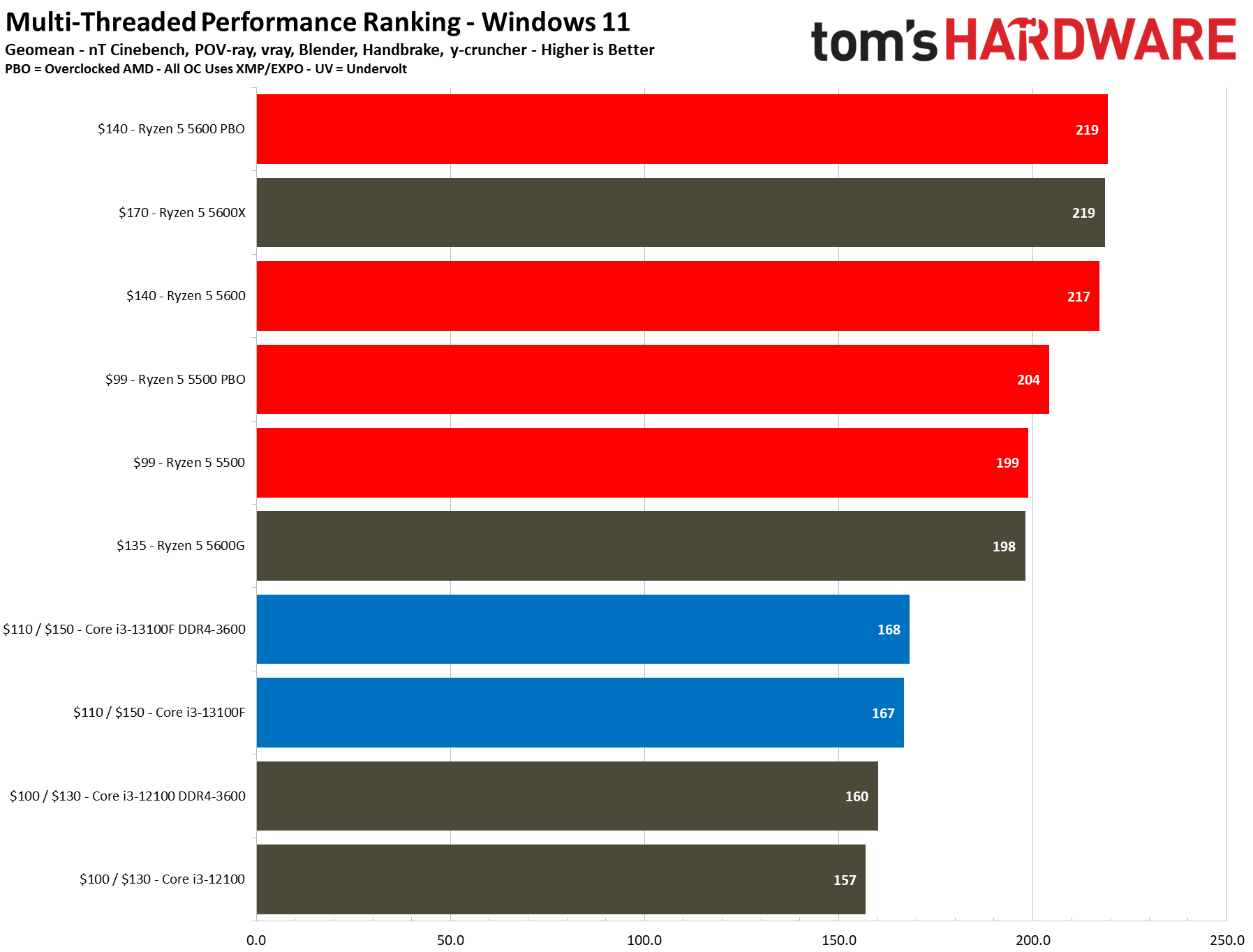
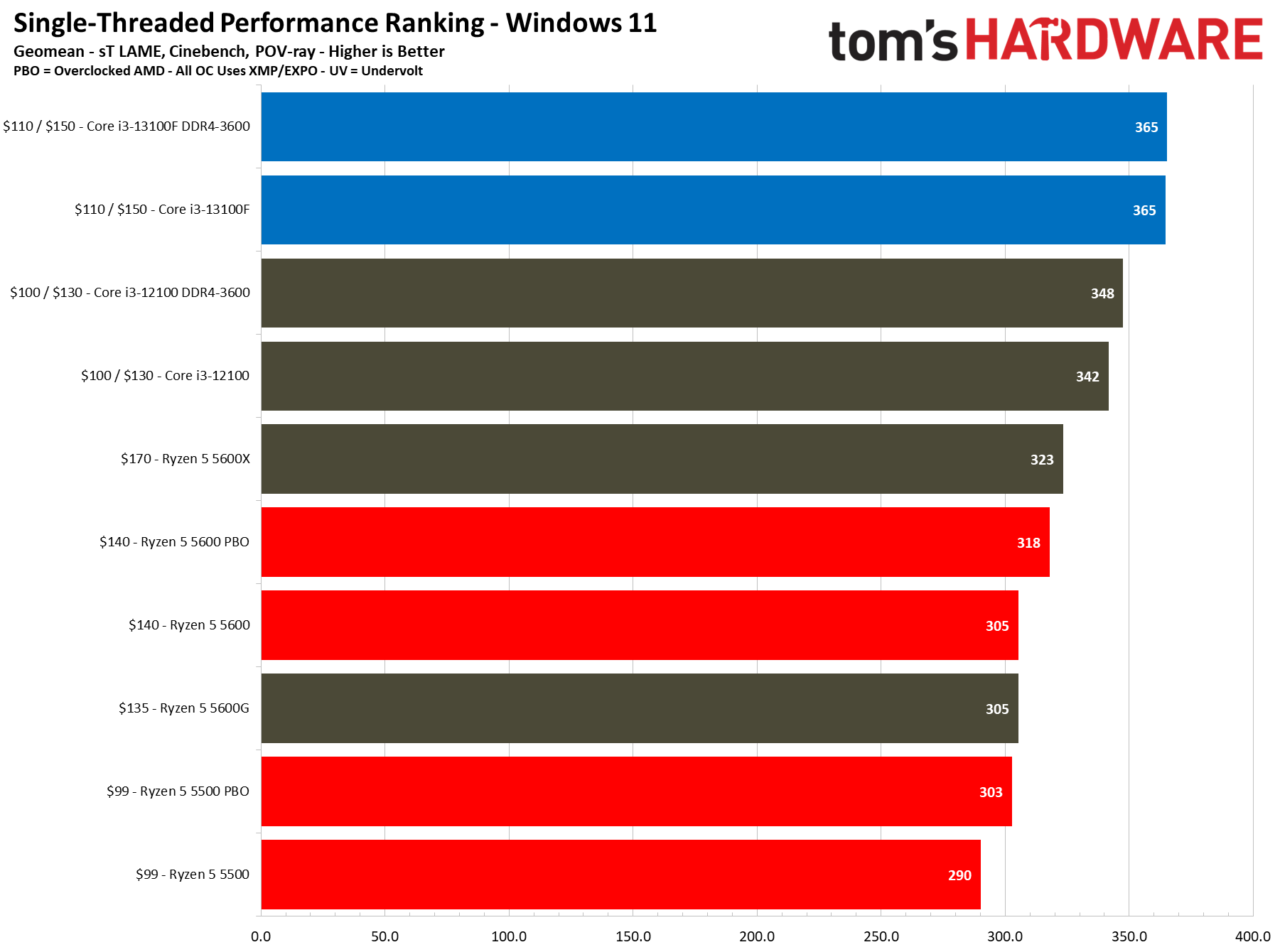
The Core i3-13100 and 13100F offer the same level of gaming performance when paired with a discrete graphics card, but a $40 price delta separates the two chips. That means we have two different contests in this section.
If you're looking for a gaming processor for around $100, the $110 Core i3-13100F is 8% faster than the $99 Ryzen 5 5500, giving it the win. The Ryzen 5 5500 is also limited to the PCIe 3.0 interface while the 13100F supports the faster PCIe 5.0/4.0 interfaces. However, while the 13100F takes the lead over the Ryzen 5 5500 in this price bracket, the previous-gen $100 Core i3-12100F remains the chip to beat with basically the same performance as the Core i3-13100F in gaming, but for $10 less.
If you're looking for a chip with a bit more heft in productivity workloads, or if you can't find a Core i3 F-series model in stock, you'll have to jump up to the $130 to $150 price range. The $140 Ryzen 5 5600 is 8% faster than the Core i3-13100 in 1080p gaming, yet costs $10 less, making it an easy recommendation even before we take its other advantages into account. The $130 Core i3-12100 remains a viable alternative here if you absolutely must have an iGPU (the Ryzen model doesn't have one), but the Ryzen 5 5600 holds the lead in gaming with a discrete GPU and is far more performant in productivity workloads.
Speaking of which, both the Ryzen 5 5600 and 5500 offer substantially more performance in multi-threaded productivity applications (30% and 20%, respectively) than the Core i3-13100 and 12100. Conversely, the Intel chips are faster in single-threaded tasks, but by smaller margins. We think Ryzen's big advantage in threaded workloads will be far more noticeable than Intel's smaller advantage in single-threaded work.
The Ryzen processors leverage the plentiful and affordable AM4 motherboard ecosystem, and like the Core i3 chips, support DDR4 memory. Meanwhile, the Intel chips are confined to 600- and 700-series chipsets, so AMD has the platform pricing advantage — you can find incredible deals for AM4 motherboards. Be aware that you'll lose support for PCIe 5.0 and DDR5 if you go with the Ryzen 5 5600, but we don't think those interfaces are as important with this class of chip. Both the Intel and AMD chips come with bundled coolers that are sufficient for normal operation.
The $150 Core i3-13100 is simply overpriced for a quad-core in 2023. Intel's decision to use the same design for the 13100/F and merely increase boost clocks by 200 MHz doesn't do enough to deliver any tangible increase in value. The minor improvements we saw in our testing certainly aren't enough to justify the Core i3-13100's higher price tag over the prior-gen model.
The less-expensive $110 Core i3-13100F makes more sense, but it faces a stiff challenge from its predecessor. If you're looking for a chip in the $100 price range and you can find it in stock, we still recommend the Core i3-12100F for gaming-focused budget builds. If the Core i3-13100F is all that is available, it is also better in the ~$100 price range than the Ryzen 5 5500. If you're looking to step up a pricing tier and want even more performance in gaming and productivity applications, the Ryzen 5 5600 is the best of the bunch in both gaming and productivity work.
- MORE: AMD Ryzen 7 7800X3D vs Intel Core i9-13900K vs Core i7-13700K
- MORE: Best CPU for gaming
- MORE: CPU Benchmark Hierarchy
- MORE: Intel vs AMD
- MORE: How to Overclock a CPU







